The Catalog of Transit Fiscal Ephemera & Exonumia from the City of the New York
(pre-MetroCard)
featuring the collections of George S. Cuhaj & Philip M. Goldstein
Page 5B:

| Bruckner Boulevard Line | |
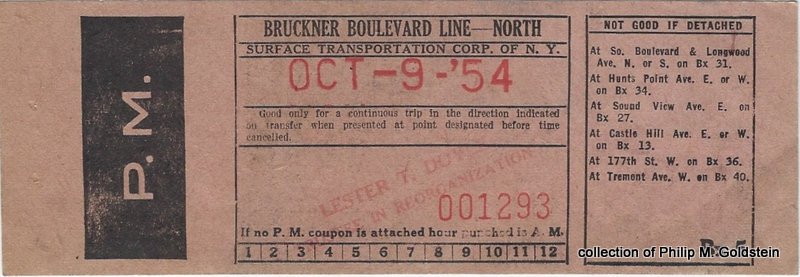 |
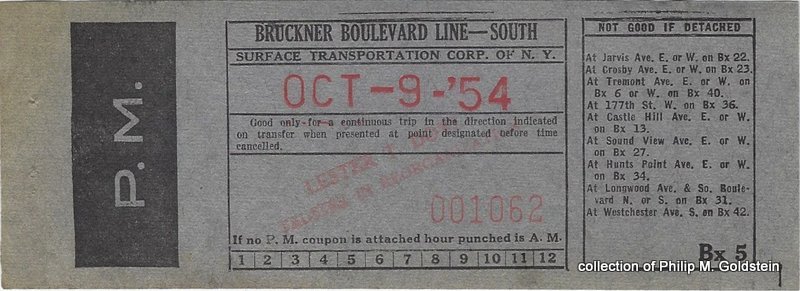 |
| North - PM (pink) hourly punch, detachable PM coupon Surface Transportation Corp of NY (receivership, Lester T. Doyle trustee) (Smith Patent copy) |
South - PM (blue) hourly punch, detachable PM coupon Surface Transportation Corp of NY (receivership, Lester T. Doyle trustee) (Smith Patent copy) |
| City Island - West Farms |
 |
| West - PM (buff) Surface Transportation Corp. hourly punch PM (no patent) note on back: bus |
| Concourse - Hub Line | |
| intentionally left blank | 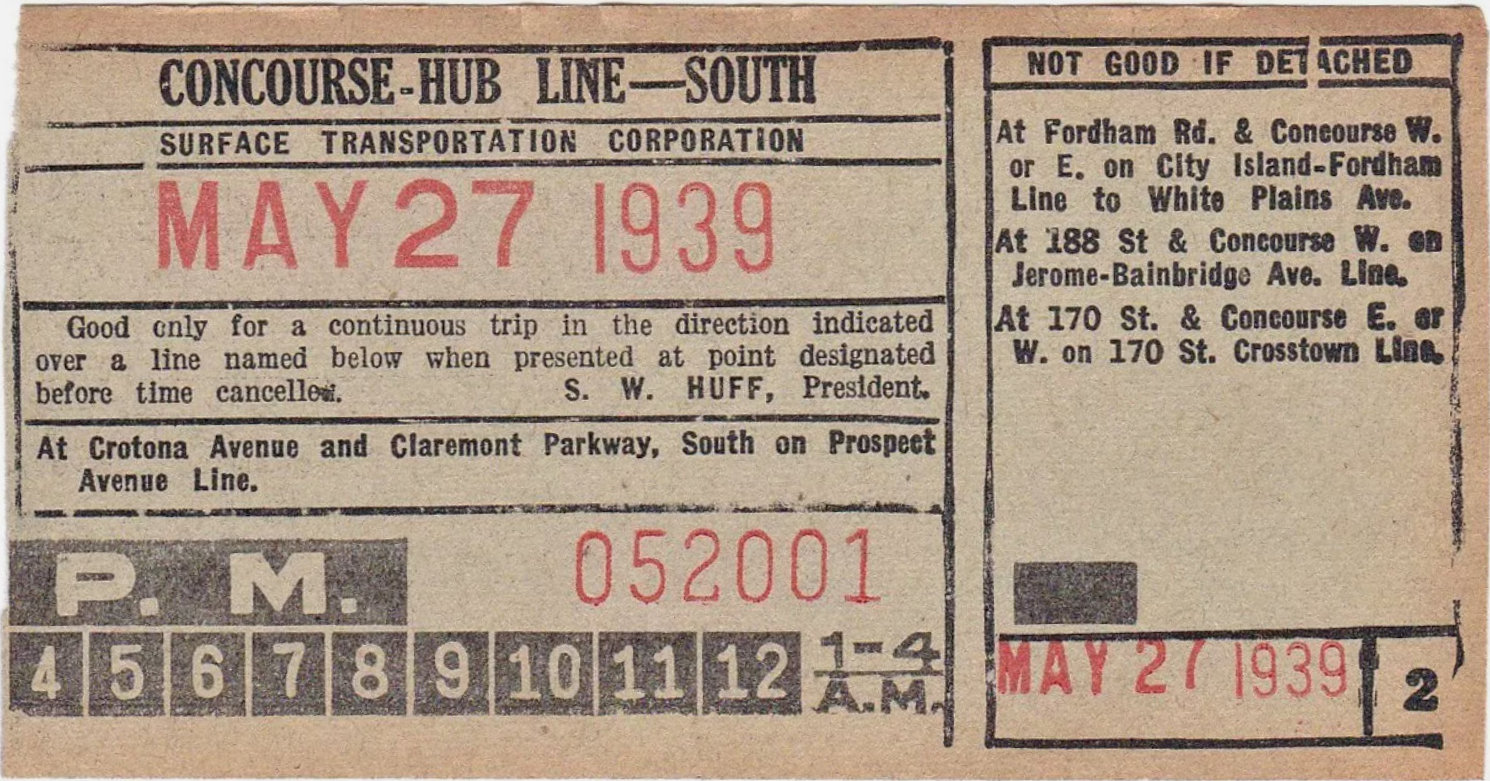 |
| South - PM (buff) hourly punch, PM Surface Transportation Corp S. W. Huff, president |
|
| . | |
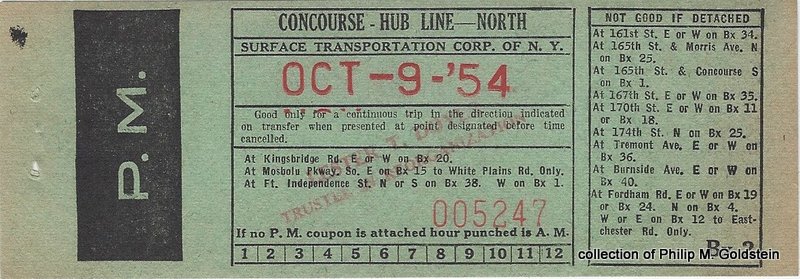 |
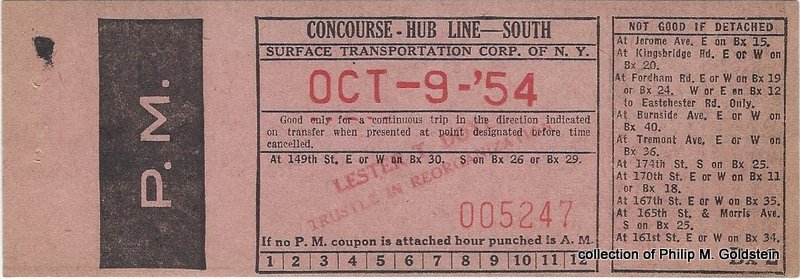 |
| North - PM (green) hourly punch, detachable PM coupon Surface Transportation Corp of NY (receivership, Lester T. Doyle trustee) (Smith Patent copy) |
South - PM (pink) hourly punch, detachable PM coupon Surface Transportation Corp of NY (receivership, Lester T. Doyle trustee) (Smith Patent copy) |
| Concourse - 138th Street Line | |
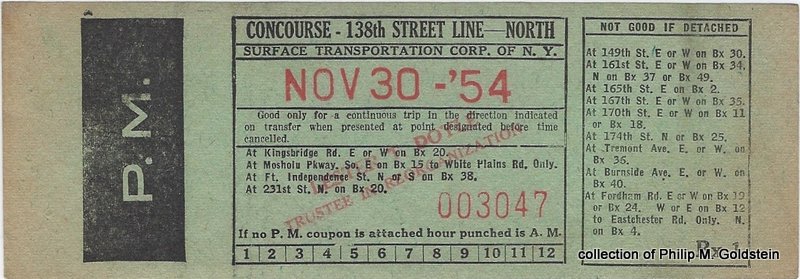 |
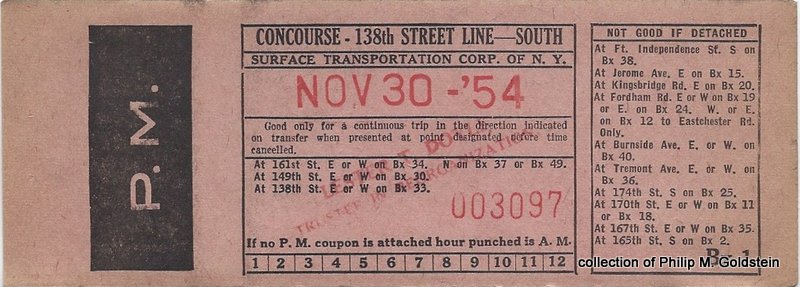 |
| North - PM (green) hourly punch, detachable PM coupon Surface Transportation Corp of NY (receivership, Lester T. Doyle trustee) (Smith Patent copy) |
South - PM (pink) hourly punch, detachable PM coupon Surface Transportation Corp of NY (receivership, Lester T. Doyle trustee) (Smith Patent copy) |
| Eastchester Road Line |
 |
| South - PM (salmon) hourly punch, detachable PM coupon Surface Transportation Corp (Smith Patent copy) |
| Jerome - Bainbridge Avenue Line |
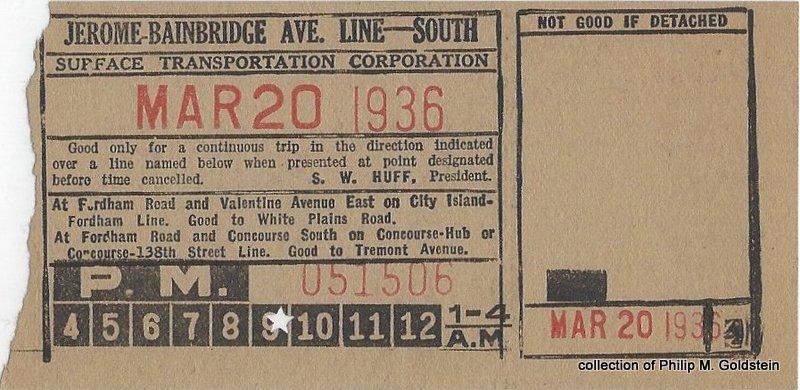 |
| South - PM (buff) hourly punch, PM Surface Transportation Corp (no patent) |
| Prospect Avenue Line | |
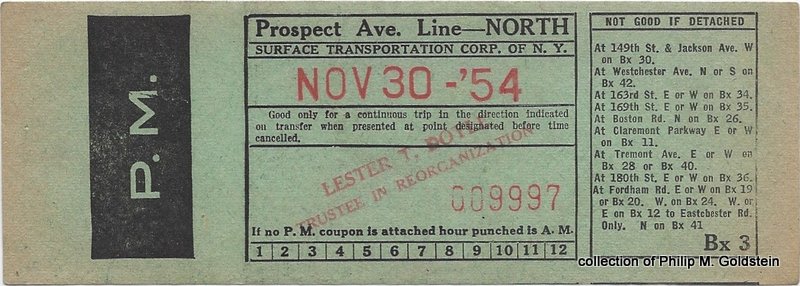 |
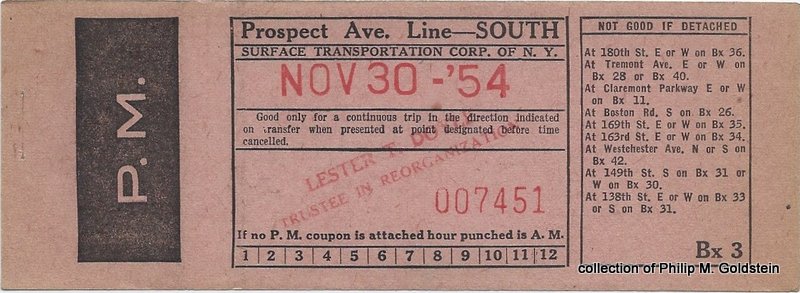 |
| North (green) hourly punch, detachable PM coupon Surface Transportation Corp of NY (receivership, Lester T. Doyle trustee) (Smith Patent copy) |
South (pink) hourly punch, detachable PM coupon Surface Transportation Corp of NY (receivership, Lester T. Doyle trustee) (Smith Patent copy) |
| Riverdale Avenue Line | |
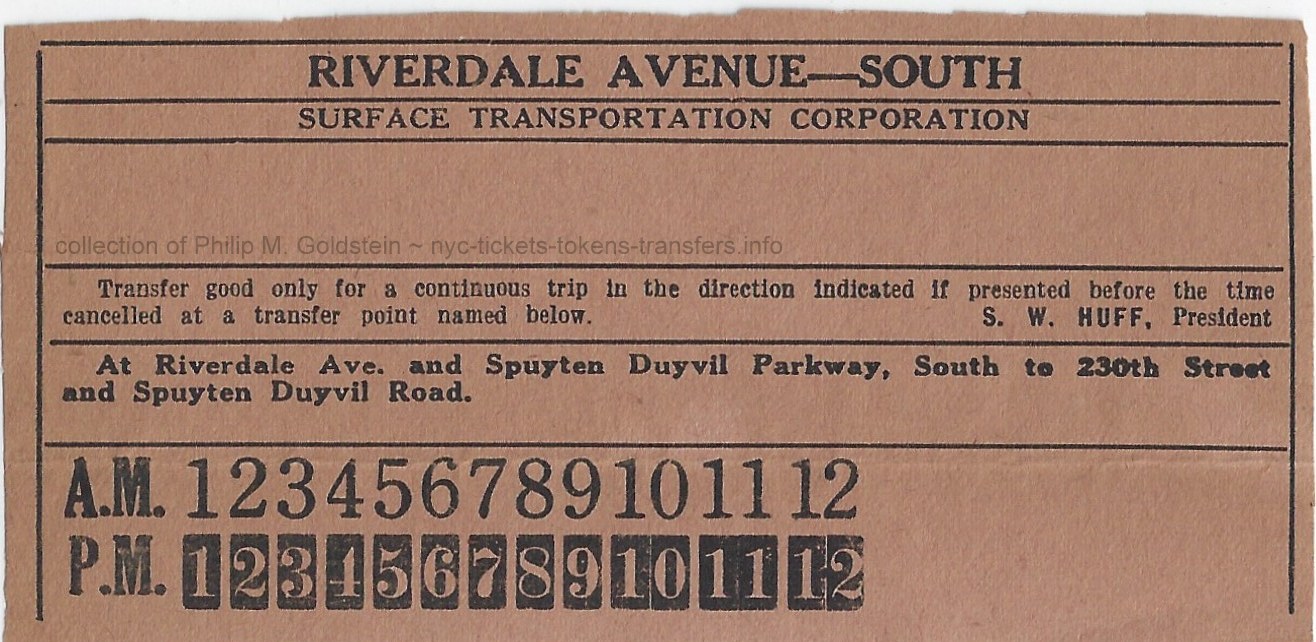 South (brown) hourly punch, AM / PM Surface Transportation Corp S. W. Huff, president (no patent) |
|
| . | |
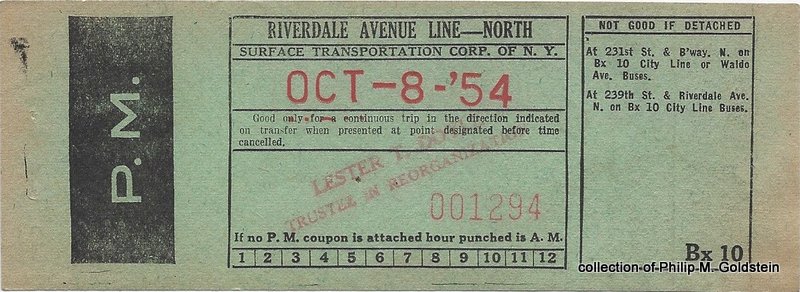 |
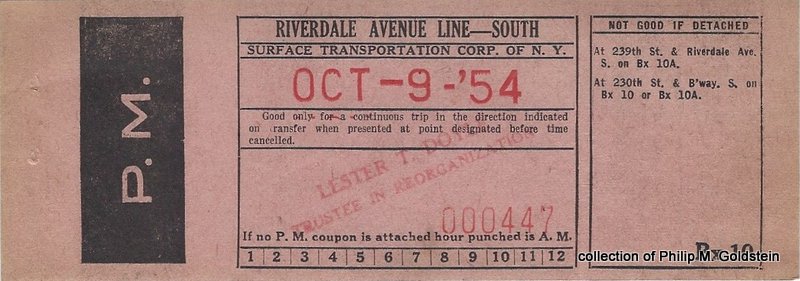 |
| North (green) hourly punch, detachable PM coupon Surface Transportation Corp of NY (receivership, Lester T. Doyle trustee) (Smith Patent copy) |
South (pink) hourly punch, detachable PM coupon Surface Transportation Corp of NY (receivership, Lester T. Doyle trustee) (Smith Patent copy) |
| Southern Boulevard | |
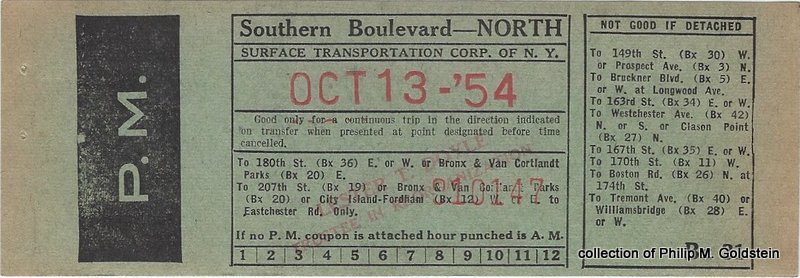 |
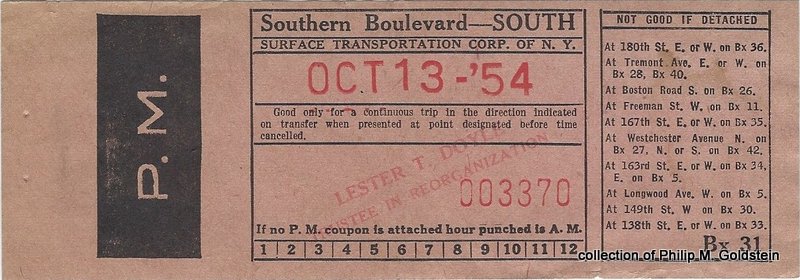 |
| North (green) hourly punch, detachable PM coupon Surface Transportation Corp of NY (receivership, Lester T. Doyle trustee) (Smith Patent copy) |
South (pink) hourly punch, detachable PM coupon Surface Transportation Corp of NY (receivership, Lester T. Doyle trustee) (Smith Patent copy) |
| St. Ann's Avenue |
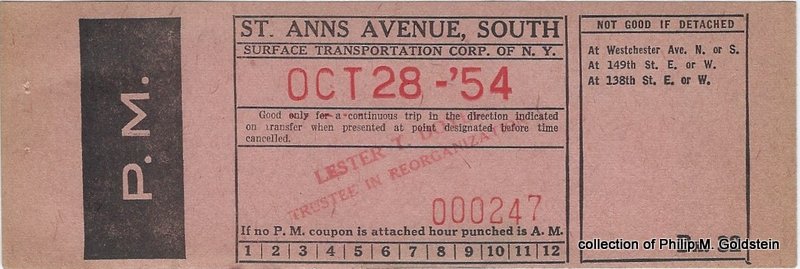 |
| South (pink) hourly punch, detachable PM coupon Surface Transportation Corp of NY (receivership, Lester T. Doyle trustee) (Smith Patent copy) |
| Throggs Neck Line |
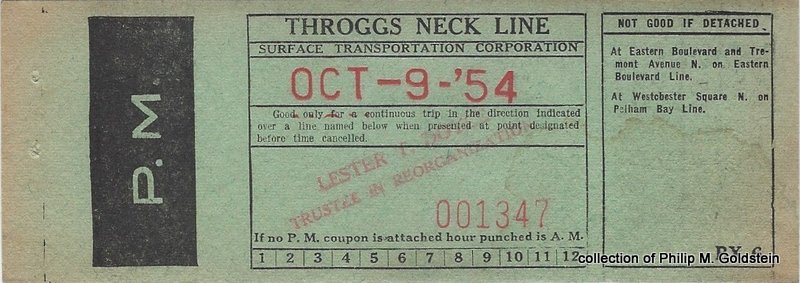 |
| (direction not specified) (green) hourly punch, detachable PM coupon Surface Transportation Corp of NY (receivership, Lester T. Doyle trustee) (Smith Patent copy) |
| Third & Amsterdam |
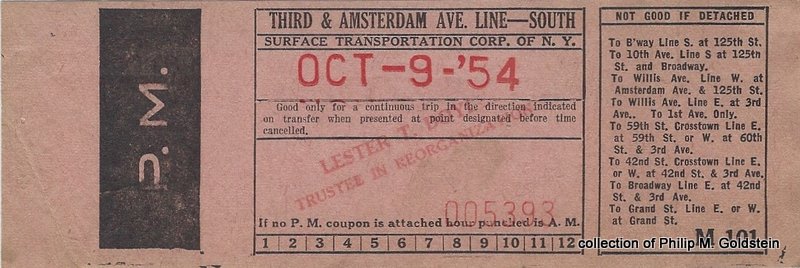 |
| South (pink) hourly punch, detachable PM coupon Surface Transportation Corp of NY (receivership, Lester T. Doyle trustee) (Smith Patent copy) |
| Tremont Avenue | |
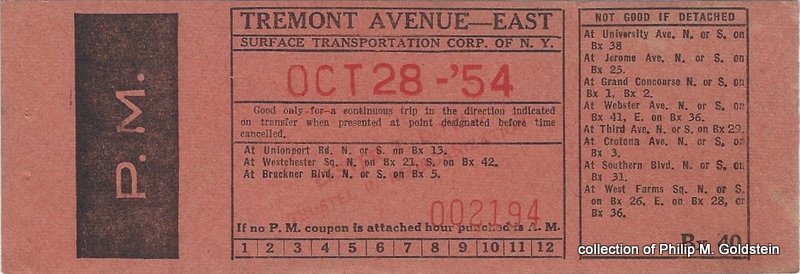 |
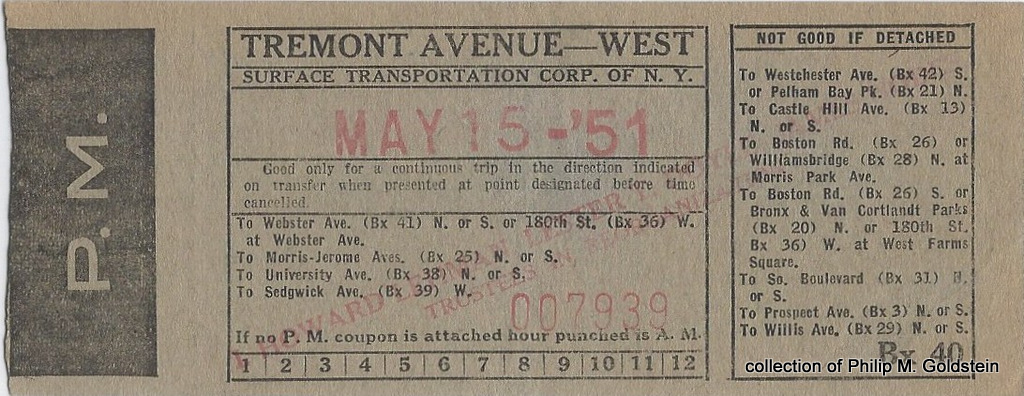 |
| East (orange) hourly punch, detachable PM coupon Surface Transportation Corp of NY (receivership, Lester T. Doyle trustee) (Smith Patent copy) |
West (green) hourly punch, detachable PM coupon Surface Transportation Corp of NY (receivership, Lester T. Doyle trustee) (Smith Patent copy) |
| Westchester Avenue |
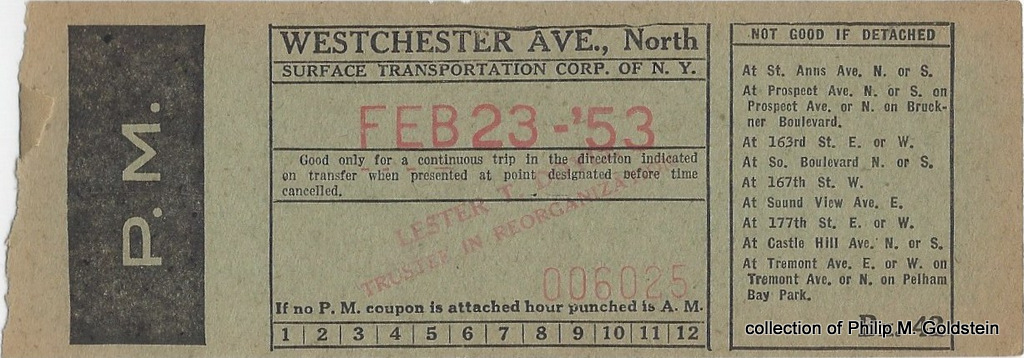 |
| North (green) hourly punch, detachable PM coupon Surface Transportation Corp of NY (receivership, Lester T. Doyle trustee) (Smith Patent copy) |
| Williamsbridge |
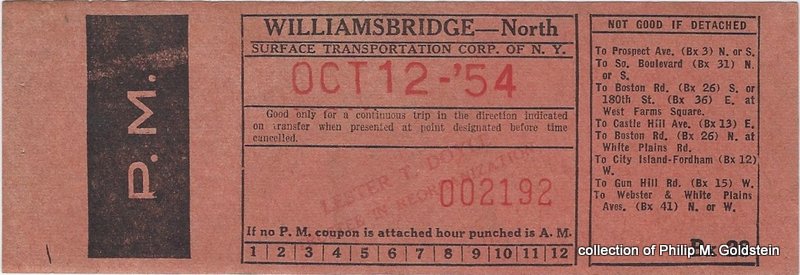 |
| North (orange) hourly punch, detachable PM coupon Surface Transportation Corp of NY (receivership, Lester T. Doyle trustee) (Smith Patent copy) |
| Willis Avenue | |
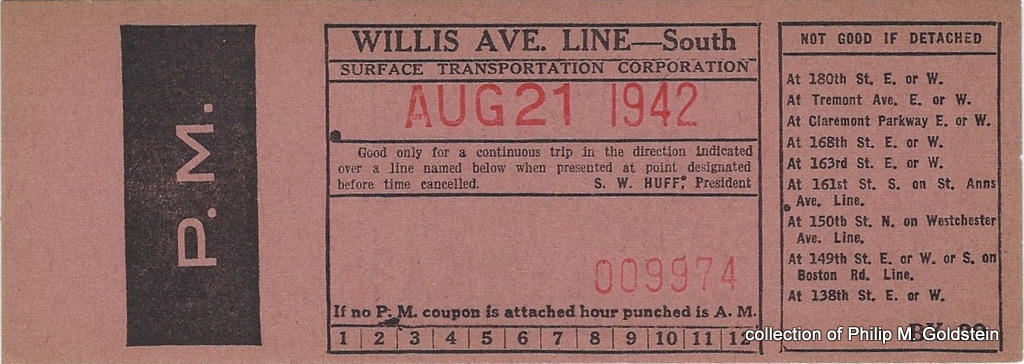 |
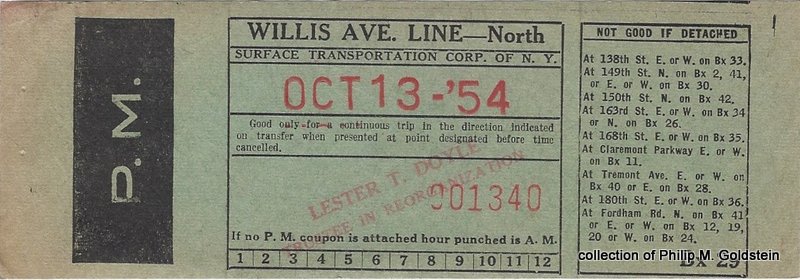 |
| South (pink) hourly punch, detachable PM coupon Surface Transportation Corp of NY (receivership, Lester T. Doyle trustee) (Smith Patent copy) |
North (green) hourly punch, detachable PM couponn Surface Transportation Corp of NY (receivership, Lester T. Doyle trustee) (Smith Patent copy) |
| 138th Street Crosstown |
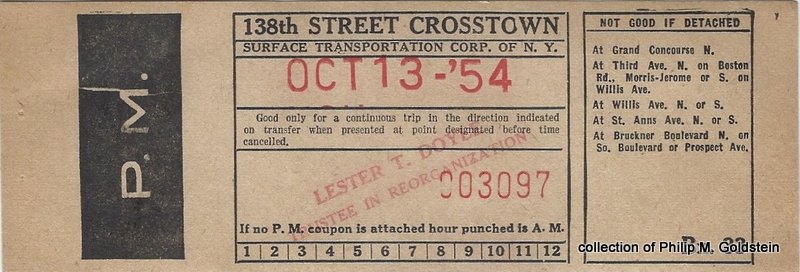 |
| (direction not specified) (buff) hourly punch, detachable PM coupon Surface Transportation Corp of NY (receivership, Lester T. Doyle trustee) (Smith Patent copy) |
| 149th Street Crosstown |
 |
| (direction not specified) (buff) hourly punch, detachable PM coupon Surface Transportation Corp of NY (receivership, Lester T. Doyle trustee) (Smith Patent copy) |
| 163rd Street Crosstown | |
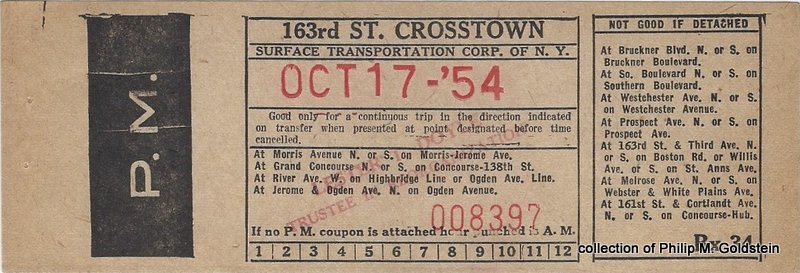 |
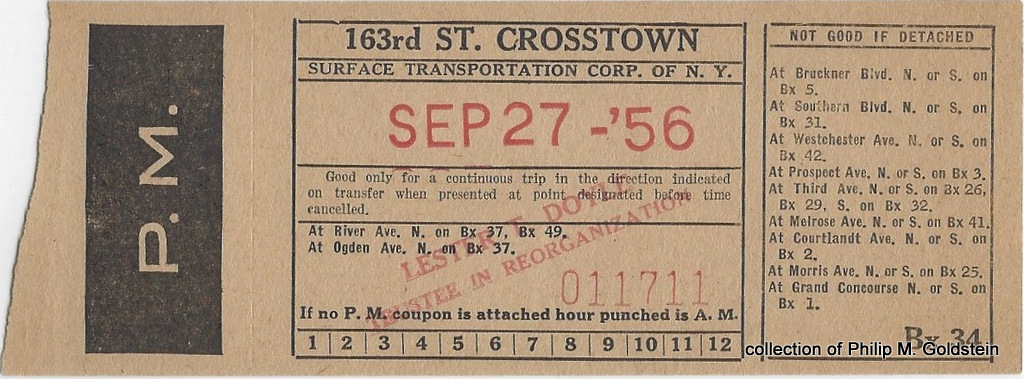 |
| (direction not specified) (buff) hourly punch, detachable PM coupon Surface Transportation Corp of NY (receivership, Lester T. Doyle trustee) (Smith Patent copy) |
(direction not specified) (buff) - different transfer points in center section hourly punch, detachable PM coupon Surface Transportation Corp of NY (receivership, Lester T. Doyle trustee) (Smith Patent copy) |
| 167th Street Crosstown | |
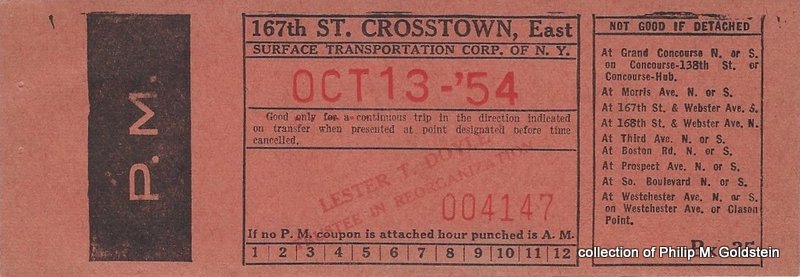 |
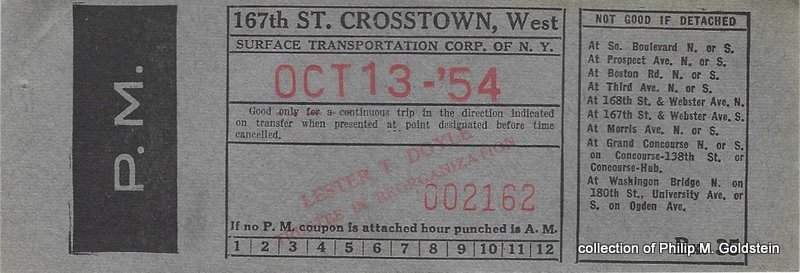 |
| East (buff) hourly punch, detachable PM coupon Surface Transportation Corp of NY (receivership, Lester T. Doyle trustee) (Smith Patent copy) |
West (blue) hourly punch, detachable PM coupon Surface Transportation Corp of NY (receivership, Lester T. Doyle trustee) (Smith Patent copy) |
| 170th Street Crosstown |
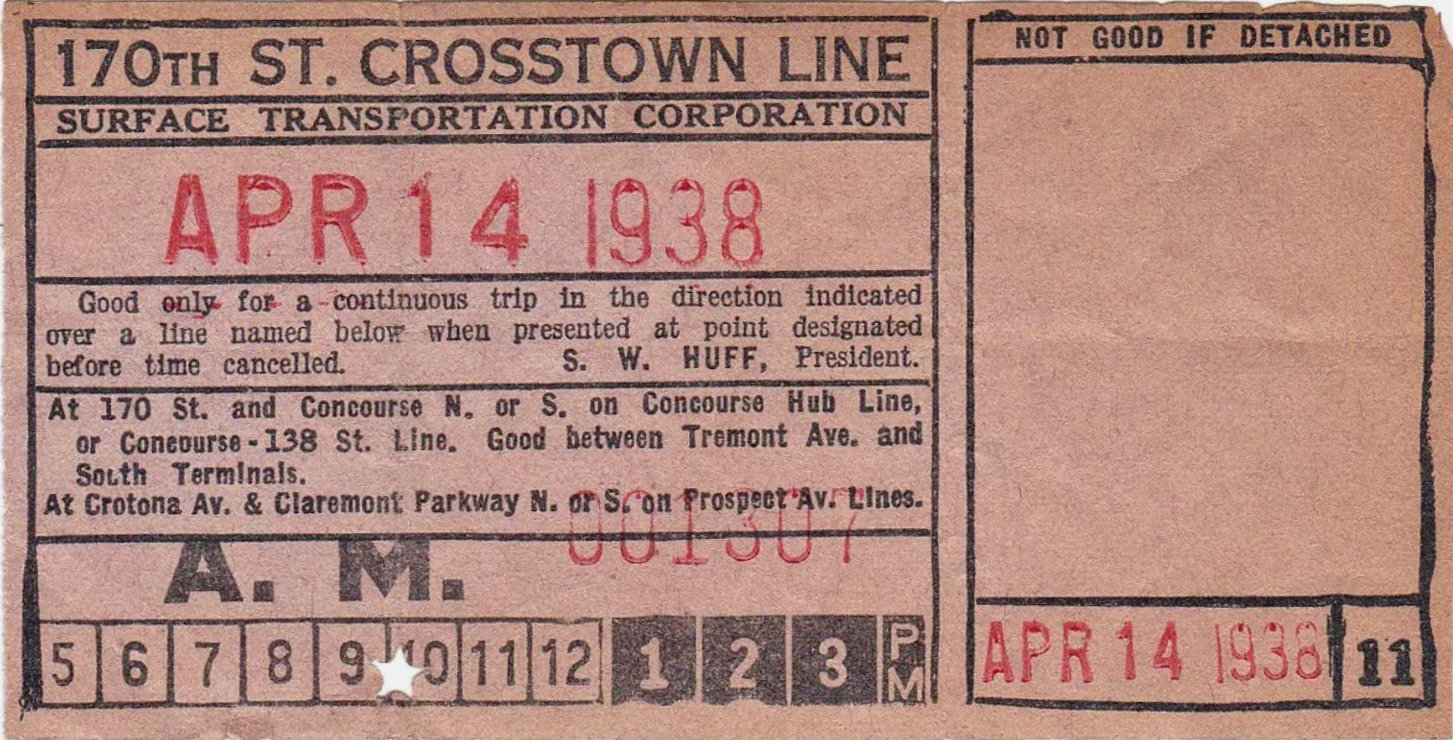 |
| (orange) hourly punch, AM Surface Transportation Corp of NY S. W. Huff, president (Smith Patent copy) |
| 180th Street Crosstown | |
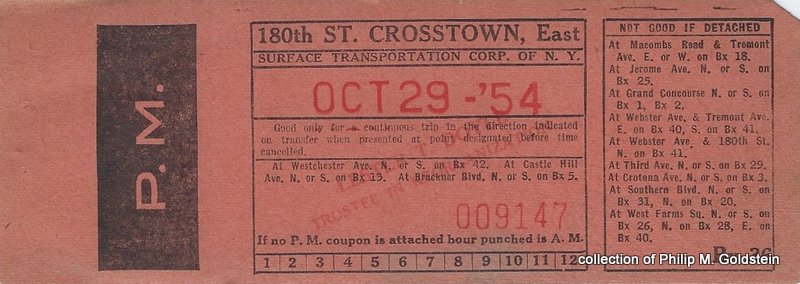 |
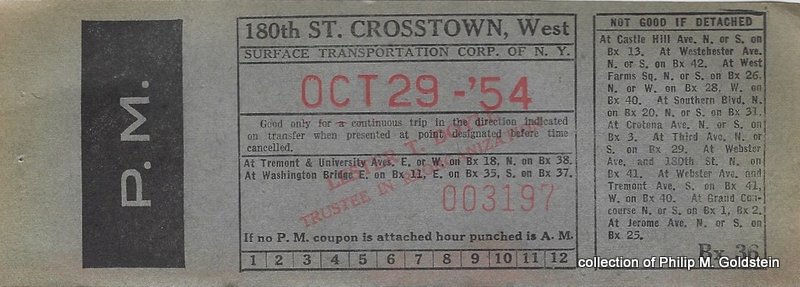 |
| East (orange) hourly punch, detachable PM coupon Surface Transportation Corp of NY (receivership, Lester T. Doyle trustee) (Smith Patent copy) |
West (blue) hourly punch, detachable PM coupon Surface Transportation Corp of NY (receivership, Lester T. Doyle trustee) (Smith Patent copy) |
| 170th Street Crosstown Line |
 |
| East (orange) hourly punch, detachable PM coupon Surface Transportation Corp of NY (receivership, Lester T. Doyle trustee) (Smith Patent copy) |
 |
 |
 |
| Operators Identification Check, no date any Point in City Island Zone S. W. Huff, president |
Operators Identification Check, August 8, 1941 between Pelham Bay and Eastchester Road or eastbound between between White Plains Road & Eastchester Road S. W. Huff, president It is believed that this ticket was for the Williamsbridge Road route where it intersects the Pelham Parkway route, as at this point the Pelham Parkway route was split into omni directional running along Pelham Parkway North (westbound) and Pelham Parkway South (eastbound) between White Plains Road and Eastchester Road. This would have prevented a passenger from getting a free round trip. |
Operators Identification Check, April 23, 1944 betweenTremont Avenue and Fordham Road S. W. Huff, president There were only four bus routes in operation in 1944, with a route that had these points as listed along their route:
|
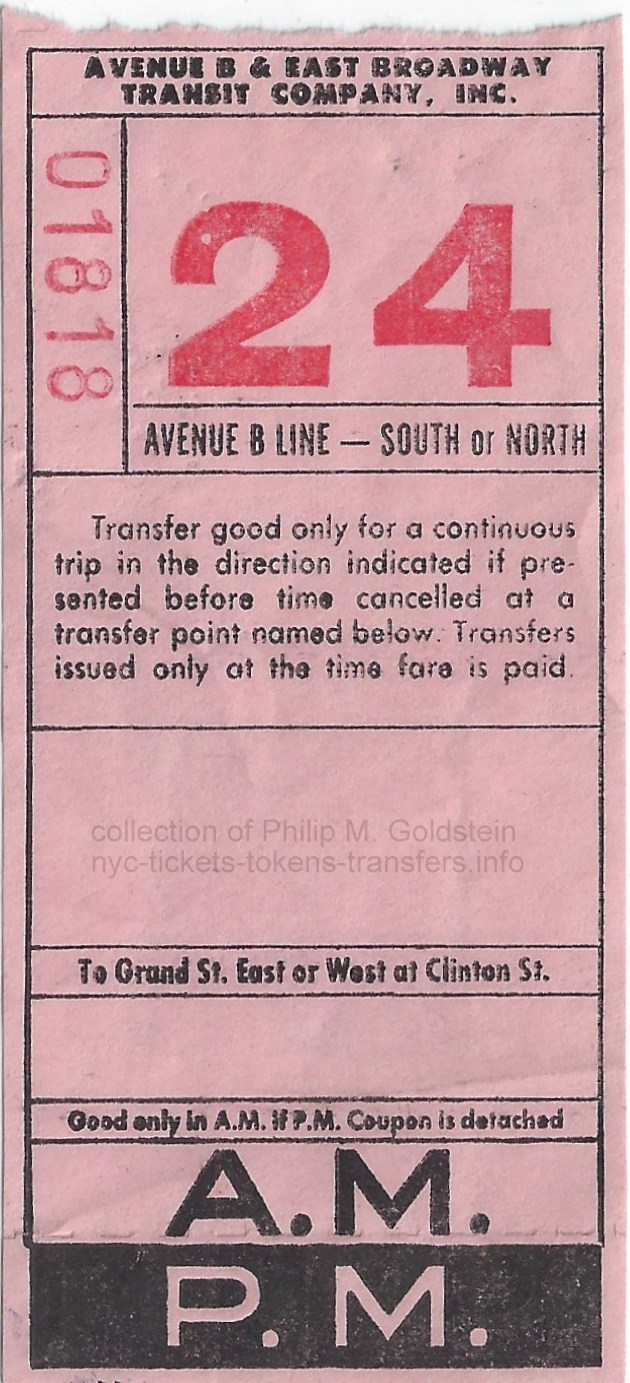 |
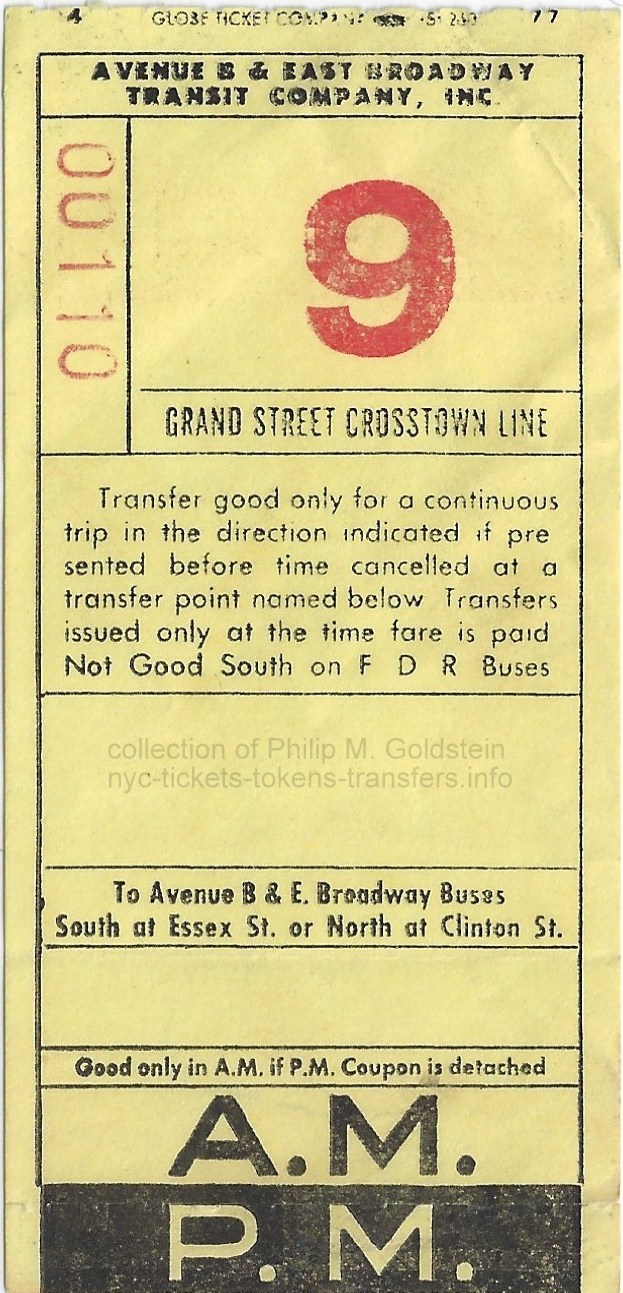 |
| Avenue B Line - south or north (pink) date code: 22 AM/PM tab Globe Ticket Co. |
Grand Street Crosstown Line (yellow) date code: 9 AM/PM tab Globe Ticket Co. |
| old route number | current number | route name | previous streetcar operator |
|---|---|---|---|
| M11 | M31 | York Avenue | Second Avenue |
| M12 | (discontinued) | 86th Street - York Avenue | Second Avenue |
| M13 | M15 | First Avenue | (never a streetcar) |
| M14 | (discontinued) | First-Second Avenues | Second Avenue |
| M15 | M15 | Second Avenue | Second Avenue |
 |
| .First Avenue Line North M-13 - Free Transfer - December 7, 1948 detachable PM coupon |
| . |
 |
| First Avenue Line North M-13 - Free Transfer - September 24, 1948 detachable PM coupon Journal Bus overstamp |
| . |
 |
| First Avenue Line - Two Cent Transfer - December 7, 1948 detachable PM coupon 2 cent transfer to Comprehesive Omnibus, to New York City Omnibus E. J. Fennelly, treasurer |
| . |
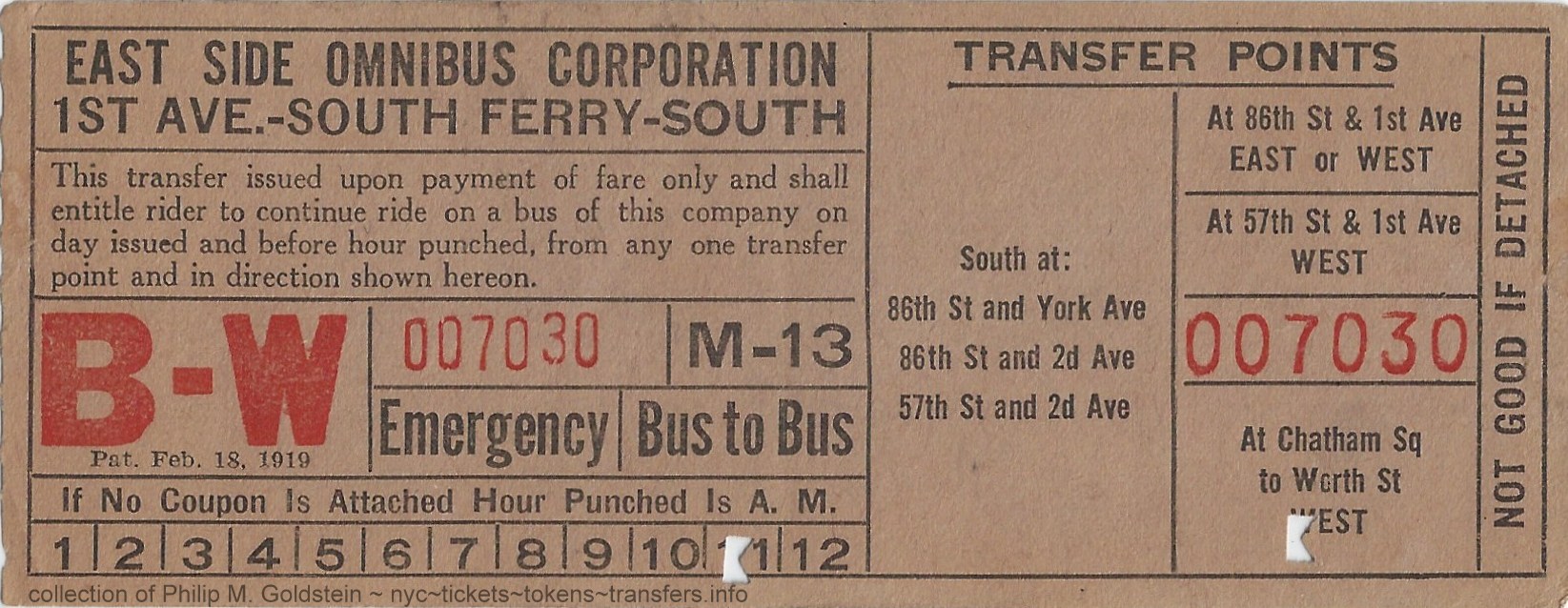 |
| .1st Ave - South Ferry - South hour punch, detachable PM coupon pat Feb 18, 1919 |
| . |
 |
| Second Avenue Line South - Free Transfer - July 14, 1945 (buff) hour punch, detachable PM coupon |
| . |
 |
| Second Avenue Line North M15 - Free Transfer - August 6 (1949) (green) hour punch, detachable PM coupon |
 |
| York Avenue / 57th Street Line - August 6, 1938 detachable PM coupon 2 cent transfer to New York City Omnibus E. J. Fennelly, treasurer |
| . |
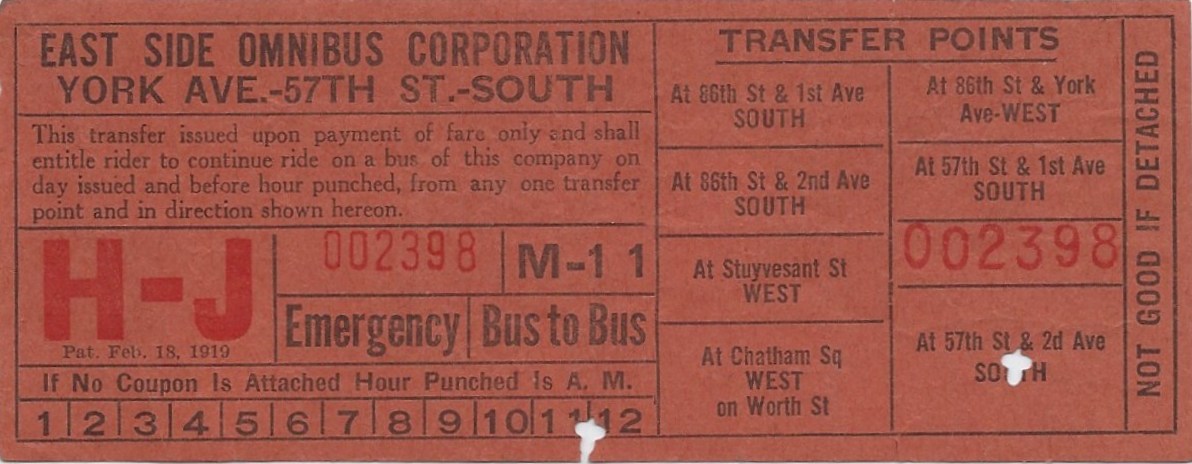 |
| York Avenue / 57th Street Line M-11 - ca. 1939 intersection punch box: at 57th Street & Second Avenue Pat February 18, 1919 |
| . |
 |
| York Avenue / 57th Street Line South M-11 - Free - March 8, 1944 hour punch, detachable PM coupon |
![]()
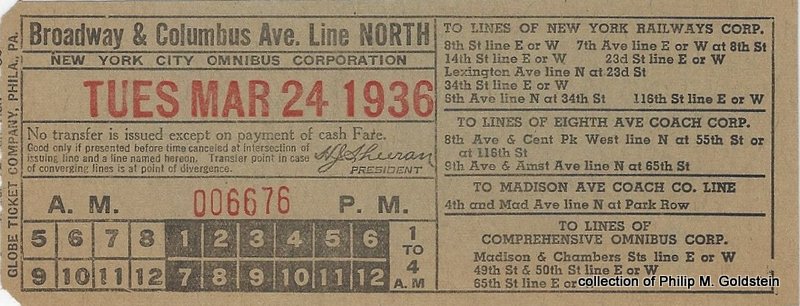 |
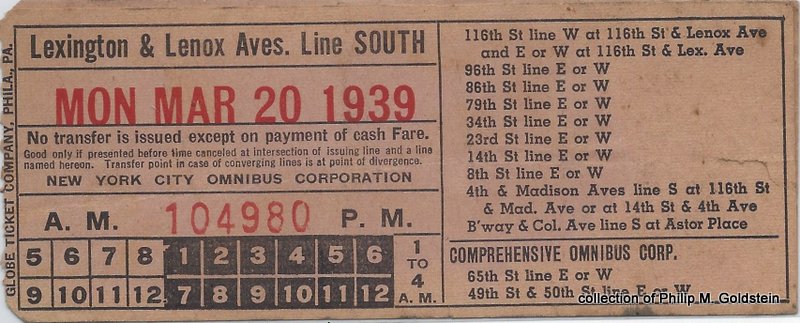 |
| Broadway & Columbus Avenue Line North - AM/PM (green) - March 24, 1936 H. J. Sheeran, president AM/PM punch (no patent) Globe Ticket (note on back: new bus replaced streetcar) |
Lexington & Lenox Avenues Line South - AM/PM (salmon) - Monday, March 20, 1939 AM/PM punch no signature (no patent) Globe Ticket |
| . | |
 |
 |
| 6th Avenue Line - North - AM/PM (green) - September 9, 1957 detachable PM coupon |
6th Avenue Line - South - AM/PM (salmon) - November 12, 1958 detachable PM coupon |
| . | |
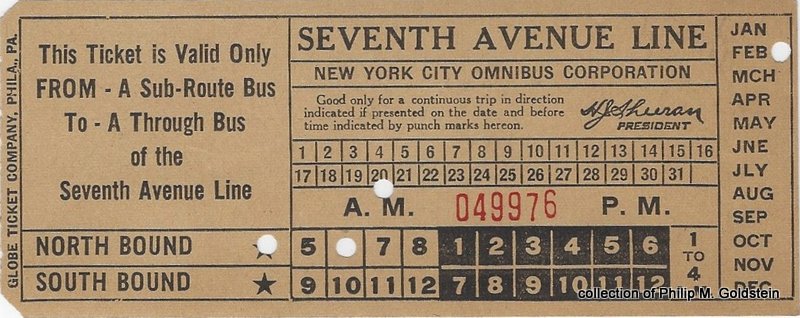 |
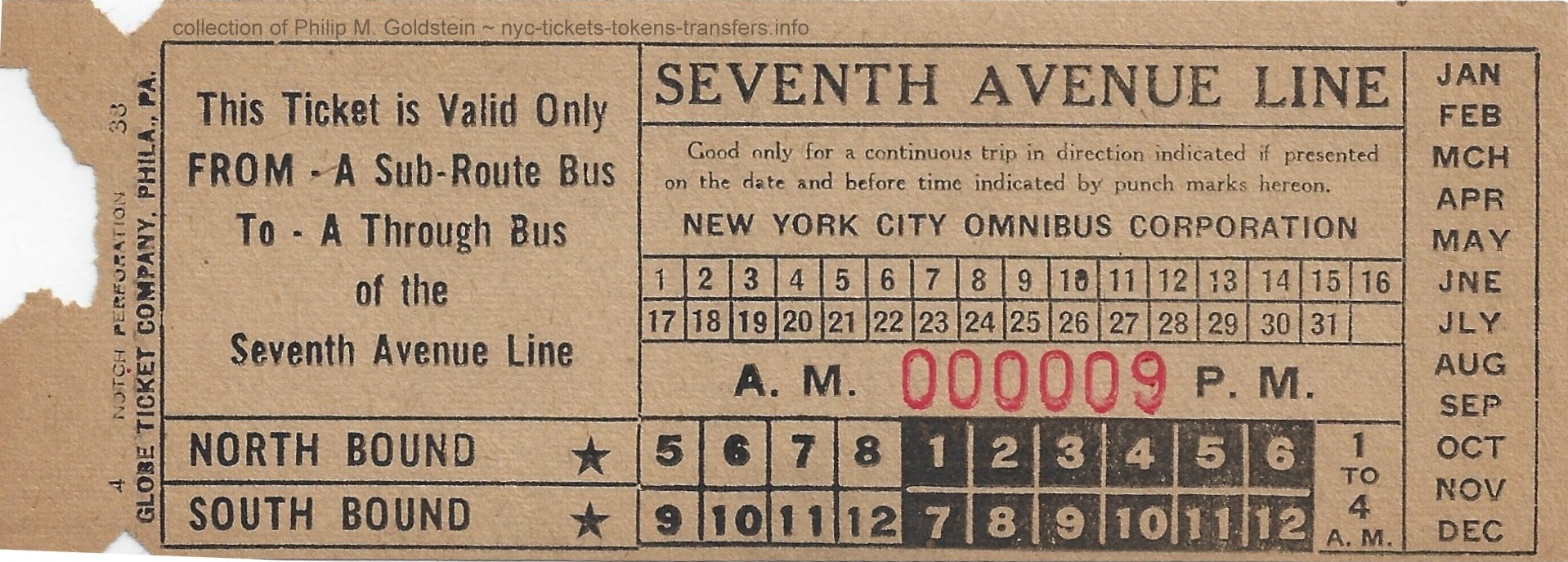 |
| Seventh Avenue Line - (buff) - February 20, from Sub-Route to Through Route H. J. Sheeran, president month, day, AM/PM, direction punch (no patent) Globe Ticket (note on back: bus) |
Seventh Avenue Line - (buff) - unused from Sub-Route to Through Route month, day, AM/PM, directionpunch (no patent) Globe Ticket 4-38 |
| . | |
.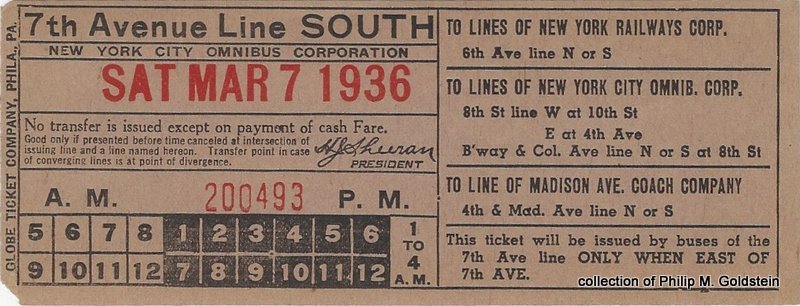 |
intentionally left blank |
| 7th Avenue Line - South - AM/PM (buff) - Saturday, March 7, 1936 H. J. Sheeran, president AM/PM punch (no patent) Globe Ticket |
|
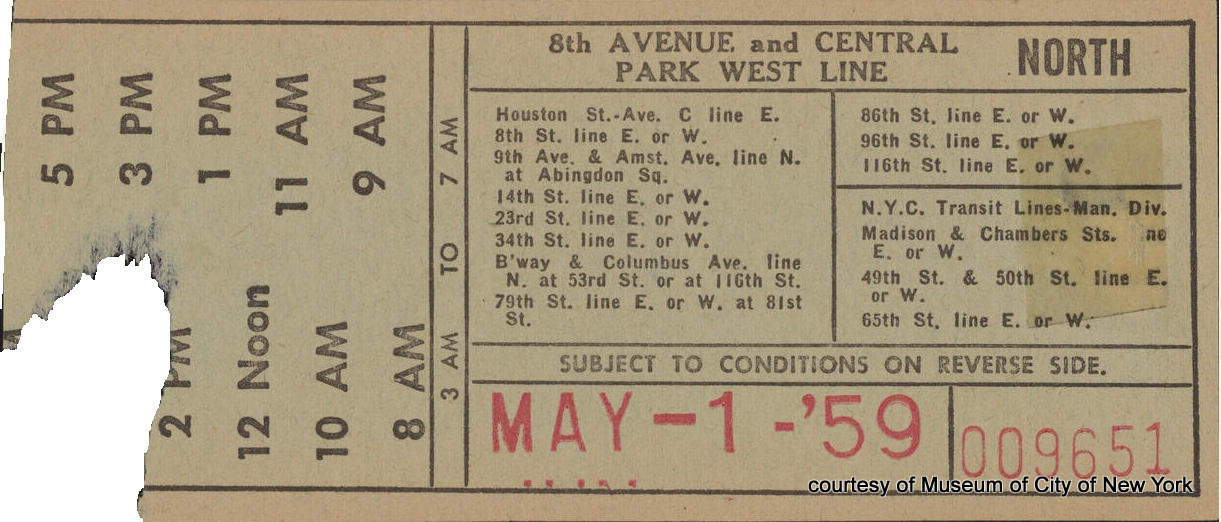 |
intentionally left blank |
| Eighth Avenue and Central Park West Line - North - (green) - May 1, 1959 | |
| . | |
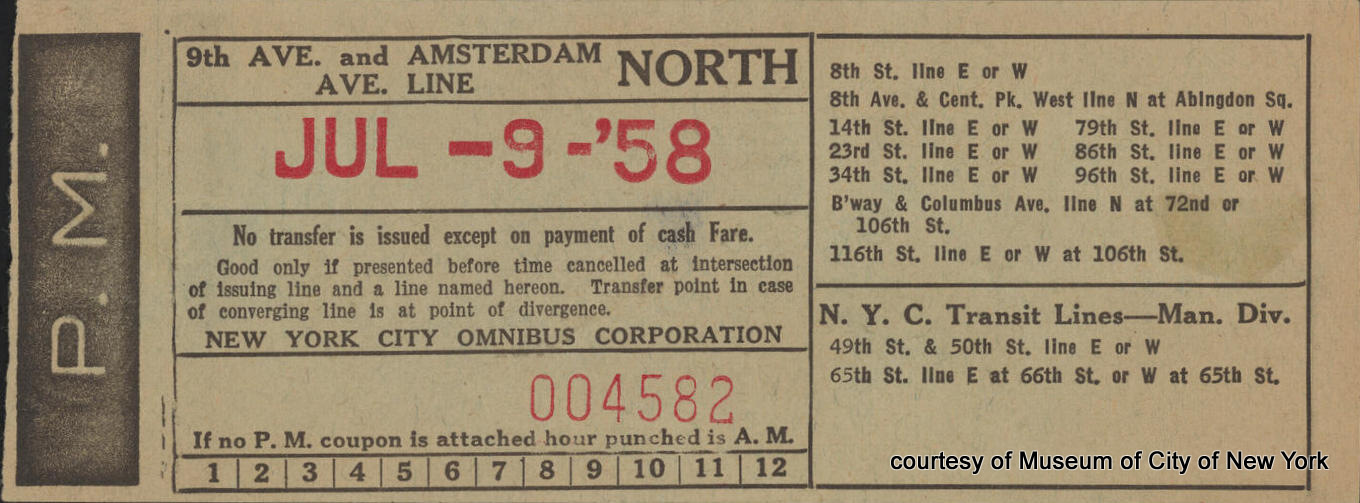 |
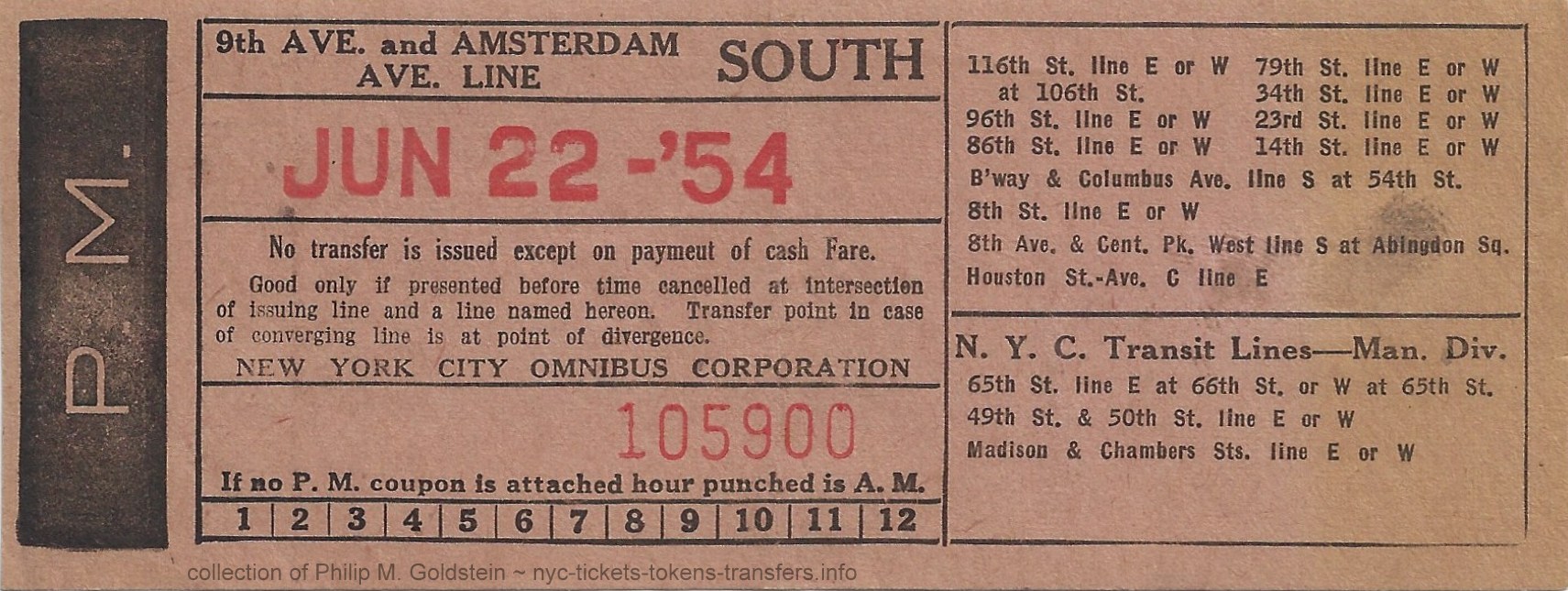 |
| Ninth Avenue and Amsterdam Avenue Line North - AM/PM (green) - July, 9, 1958 detachable PM coupon |
Ninth Avenue and Amsterdam Avenue Line South - AM/PM (pink) - June 22, 1954 detachable PM coupon |
| . | |
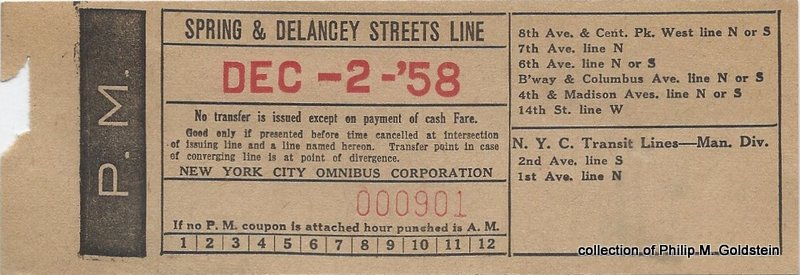 |
intentionally left blank |
| Spring & Delancey Streets Line (direction not specified) - buff - AM/PM - December 2, 1958 detachable PM coupon |
|
| . | |
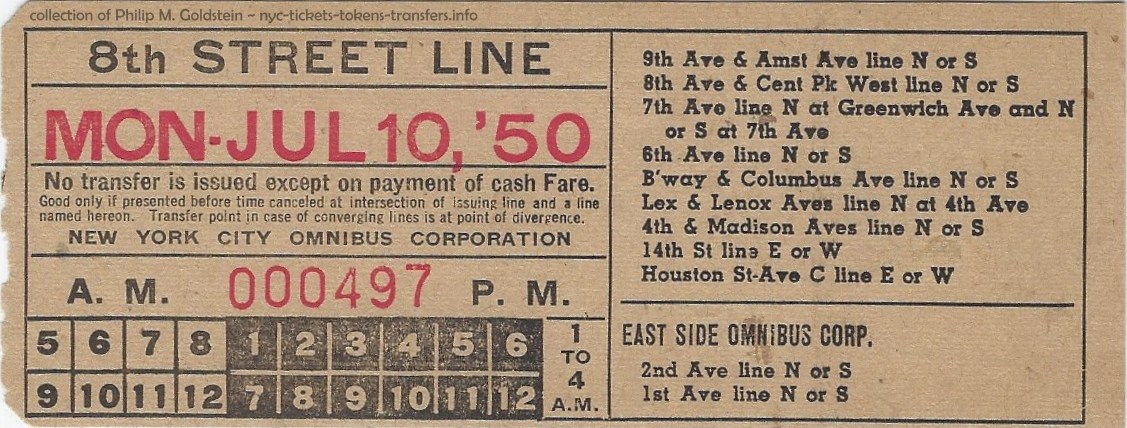 |
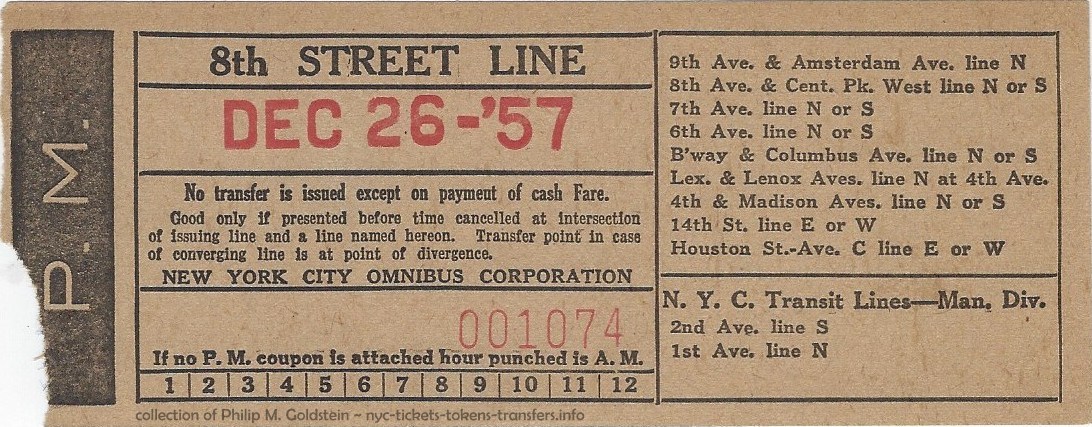 |
| 8th Street Line - buff - AM/PM - Monday, July 10, 1950 AM/PM punch |
8th Street Line - buff - AM/PM only - December 26, 1957 detachable PM coupon |
| . | |
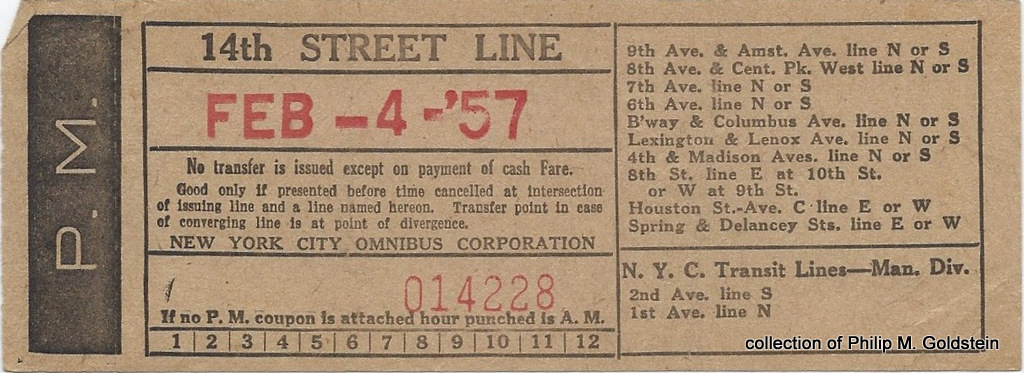 |
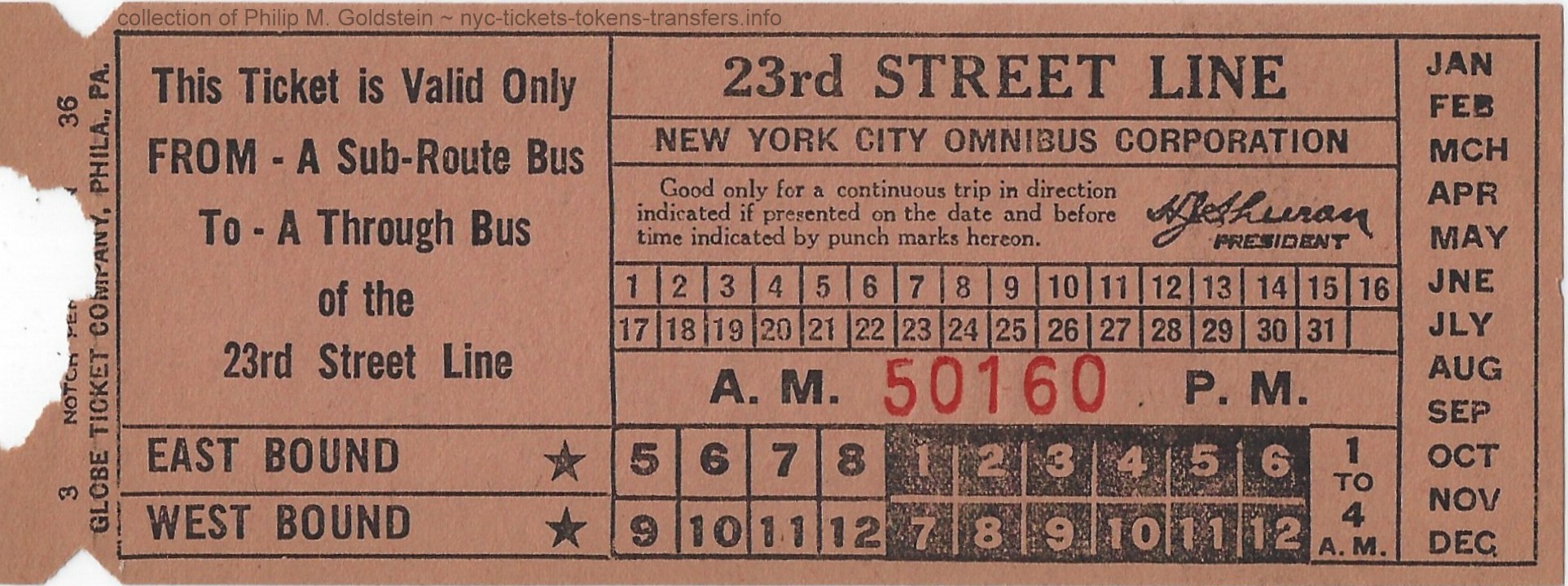 |
| 14th Street Line (direction not specified) - AM/PM (buff) - February 4, 1957 detachable PM coupon |
23rd Street Line (direction not specified) - AM/PM (pink) - ca. March 1936 AM/PM punch Globe Ticket Co. (no patent) |
| . | |
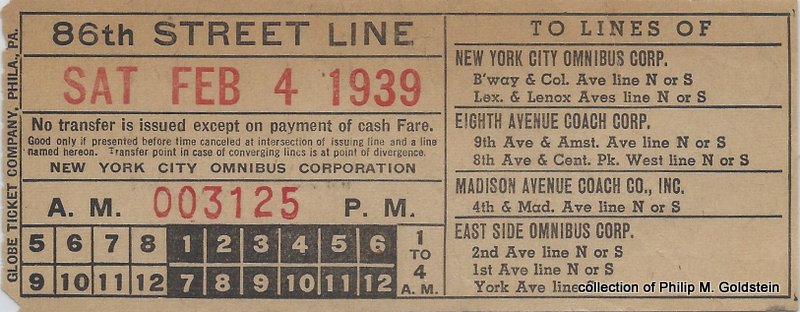 |
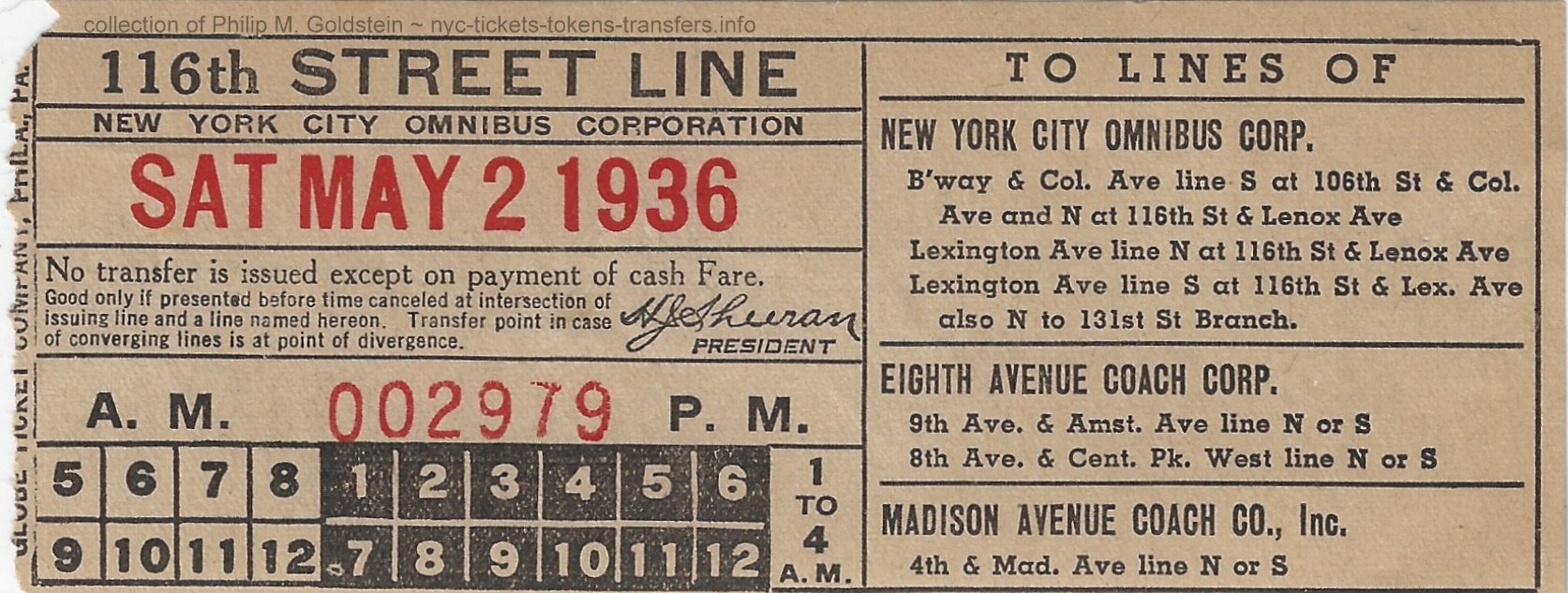 |
| 86th Street Line (direction not specified) - AM/PM (buff) - Saturday, February 4, 1957 New York City Omnibus Corp AM/PM punch Globe Ticket Co. (no patent) |
116th Street Line (direction not specified) - AM/PM (buff) - Saturday, May 2, 1936 New York City Omnibus Corp AM/PM punch Globe Ticket Co. (no patent) |
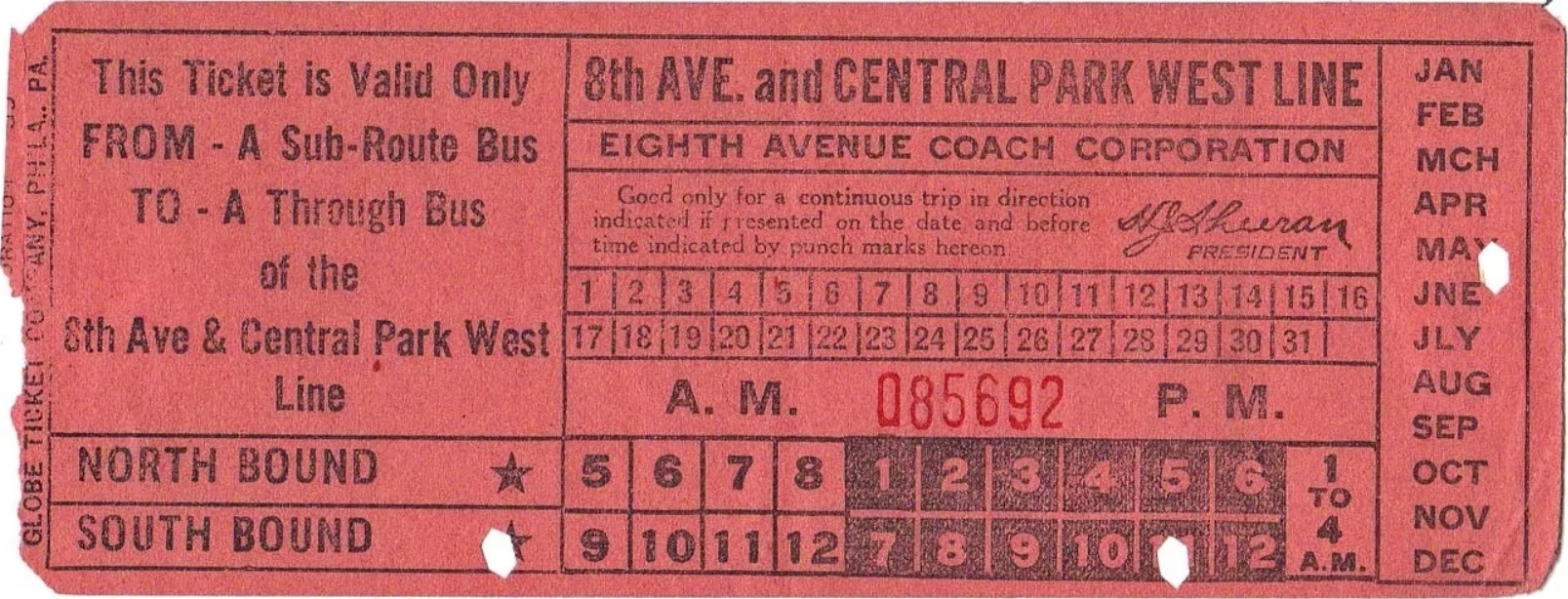 |
|
| 8th Ave and Central Park West Line June - 11 pm AM/PM hourly, month/day / direction punch H. J. Sheeran, president Globe Ticket Co. |
|
| . | |
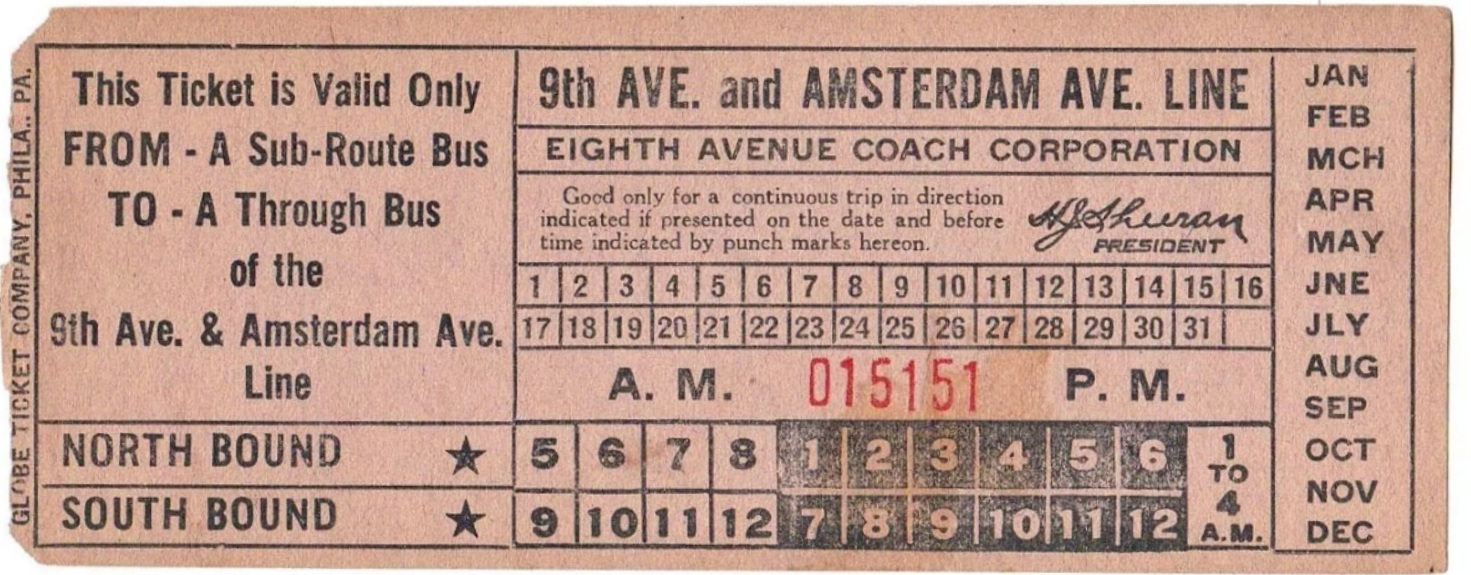 |
|
| 9th Ave and Amsterdam Avenue Line AM/PM hourly, month/day / direction punch H. J. Sheeran, president Globe Ticket Co. |
|
![]()
| route # | southern terminal | northern terminal | route of travel |
| 1 | Washington Square Park | Harlem Fifth Avenue & 138th Street |
Fifth Avenue |
| 2 | Madison Square | Washington Heights Broadway and 167th Street |
Fifth Avenue, Seventh Avenue, Edgecombe Avenue |
| 3 | Washington Square Park | Washington Heights St. Nicholas Avenue and 193rd Street |
Fifth Avenue, St. Nicholas or Convent Avenues |
| 4 | Pennsylvania Station | The Cloisters | Fifth Avenue, Central Park North / Cathedral Parkway, Riverside Drive, Broadway & Fort Washington Avenue |
| 5 / 19 | Washington Square Park | Washington Heights Broadway and 167th Street |
Fifth Avenue, West 57th Street, Broadway, Riverside Drive, Broadway: Route 5 through Hamilton Heights or Riverside Drive: Route 19 through Hamilton Heights |
| 6 | Upper West Side West 72nd Street & Central Park West |
Yorkville East 72nd Street and York Avenue |
Broadway, West 57th Street, Fifth Avenue, East 72nd street |
| 9 | Washington Square Park | Upper West Side West 72nd Street & Central Park West |
Fifth Avenue, West 57th Street, Broadway |
| 15 | Madison Square | Jackson Heights - Queens Northern Boulevard |
Fifth Avenue, Queensboro Bridge, Queens Boulevard, Roosevelt Avenue |
| 15 | Madison Square | Corona - Queens Flushing Meadows - Corona Park |
Fifth Avenue, Queensboro Bridge, Queens Boulevard, Roosevelt Avenue |
| 16 | Jackson Heights Northern Boulevard and 81st Street |
Elmhurst - Queens Broadway and Queens Boulevard |
81st / 82nd Streets, Baxter Avenue, Broadway |
| 20 | Hell's Kitchen 12th Avenue & West 55th Street |
Sutton Place Sutton Place & East 59th Street |
57th Street Crosstown |
 |
|
| Fifth Avenue, Seventh Avenue, St. Nicholas, Cathedral Parkway, Convent & Fort Washington Avenue Lines Sunday, February 2 (1936) AM/PM punch (coupon-transfer-coupon) Globe Ticket Co. (2-33) |
|
| . | |
 |
|
| Fifth Avenue, Seventh Avenue, St. Nicholas, Cathedral Parkway, Convent & Fort Washington Avenue Lines Sunday, May 9, (1937) AM/PM punch (transfer-coupon-coupon) Globe Ticket Co. (2-33) |
|
| . | |
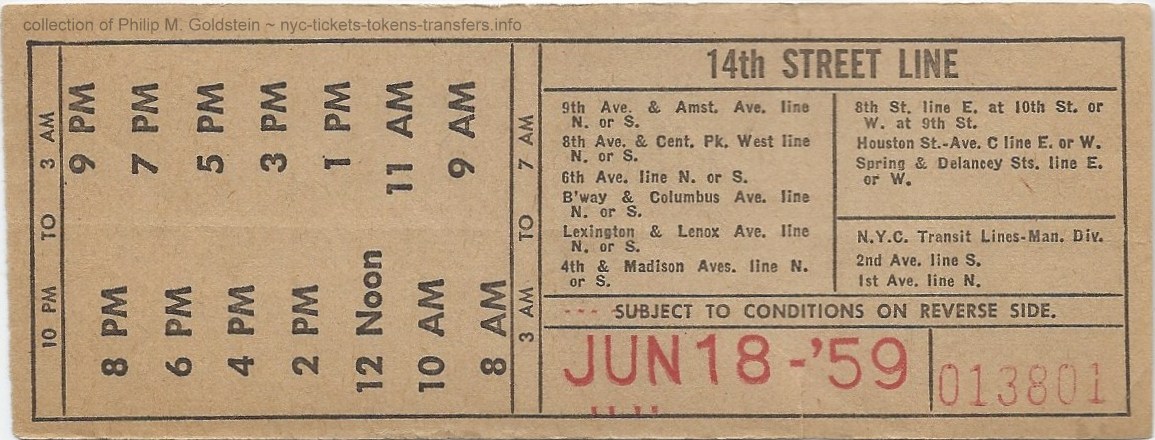 |
|
| 14th Street Line - June 18, 1959 | |
| . | |
 |
|
| 72nd Street Line - Saturday, September 6 (ca.1930's-40's) AM/PM punch Globe Ticket Co. |
|
| . | |
 |
|
| 72nd Street Crosstown Line No. 6 - East - April 30, 1959 detachable PM coupon |
|
| . | |
 |
|
| Routes 5, 8 & 19 - Riverside Drive Northbound - June 29, 1927 PM tab |
|
| .. | |
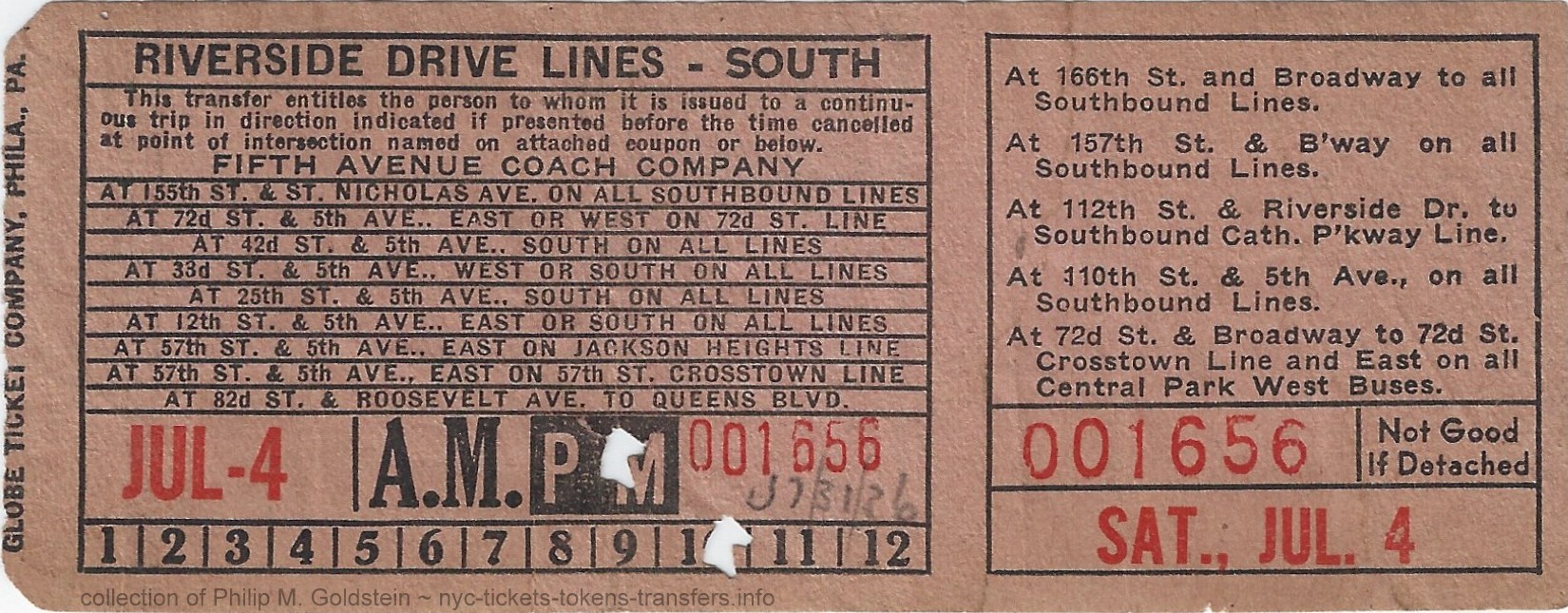 |
|
| Riverside Drive Lines - South - AM/PM (pink) - July 4, 1936 AM/PM punch Globe Ticket Co.  Riverside Drive Lines - North - AM/PM (green) - Saturday August 26, Fifth Avenue Coach co. (no patent) AM/PM punch Globe Ticket Co. |
|
| . | |
 |
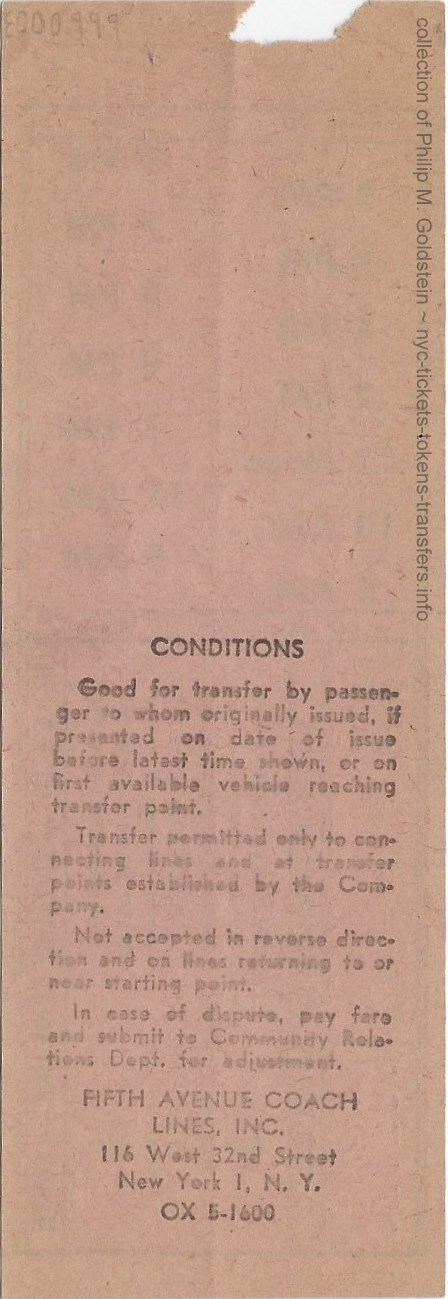 |
| Routes 5 & 19 - Riverside Drive South - March 8, 1960 | |
| . | |
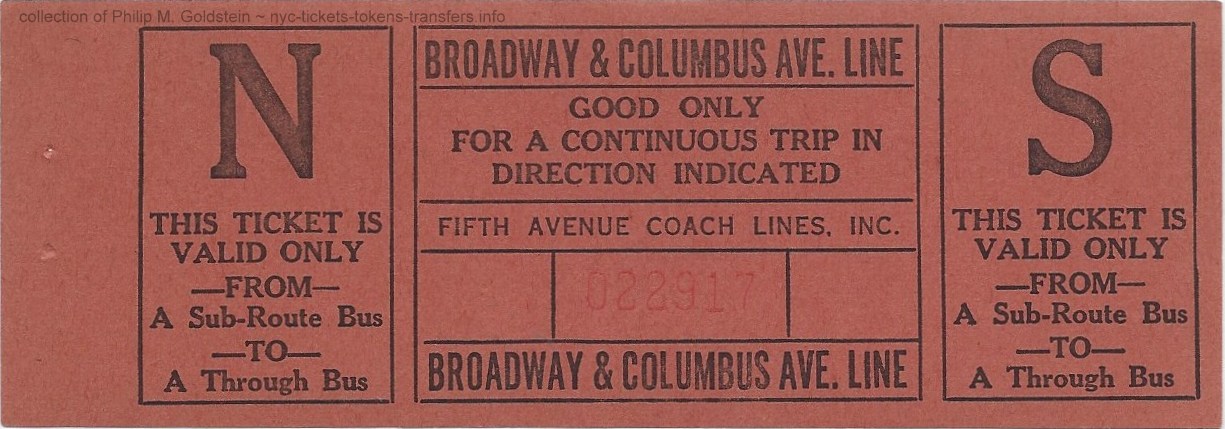 |
|
| Broadway & Columbus Avenue Line - Sub-Route to Through Route | |
| . | |
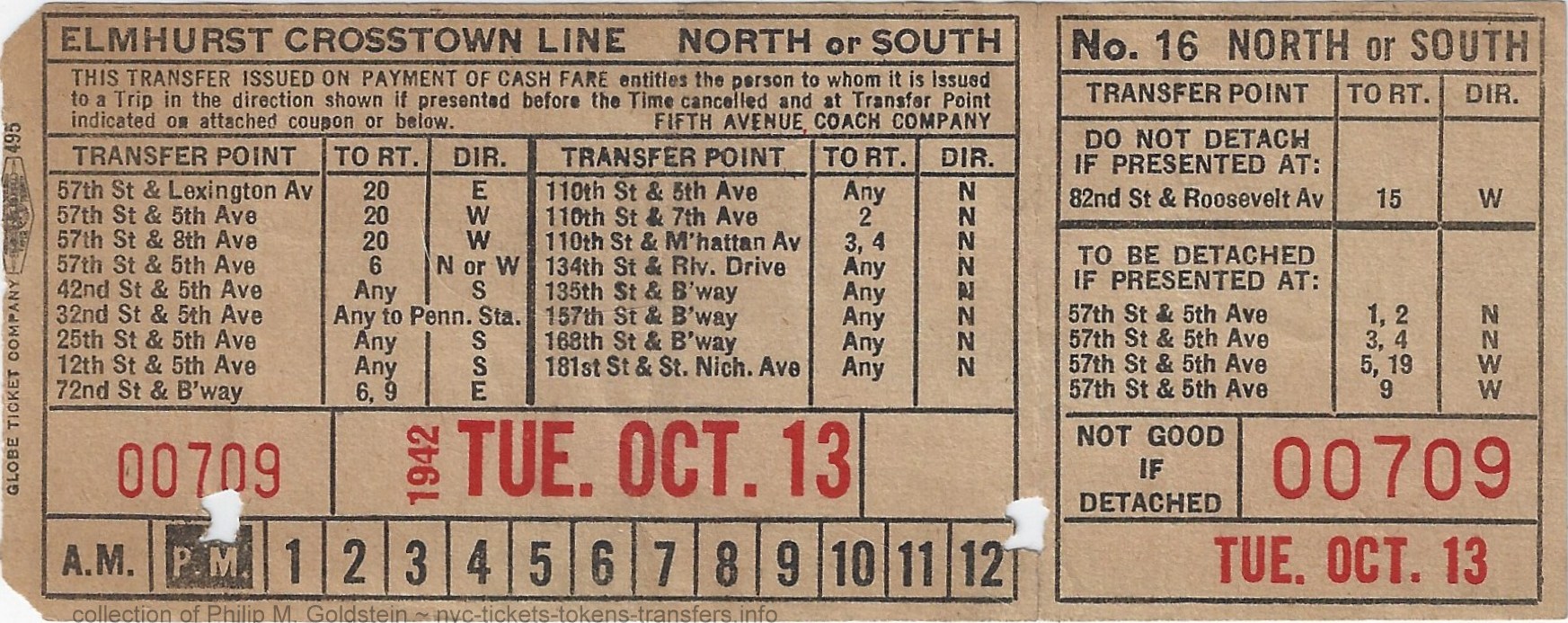 |
|
| Elmhurst Crosstown Line October 13, 1942 |
|
![]()
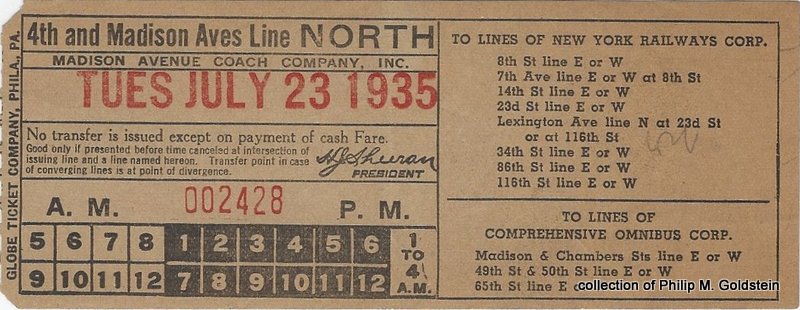
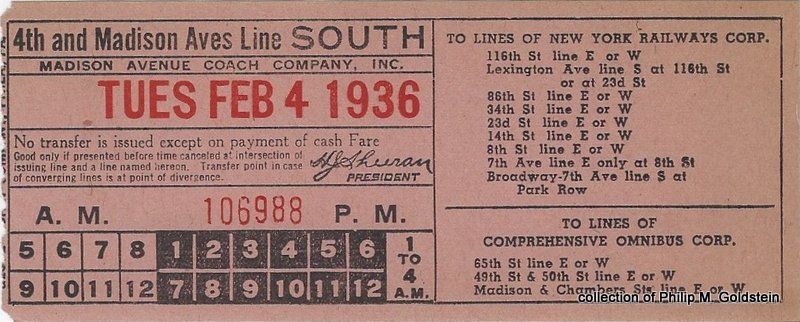
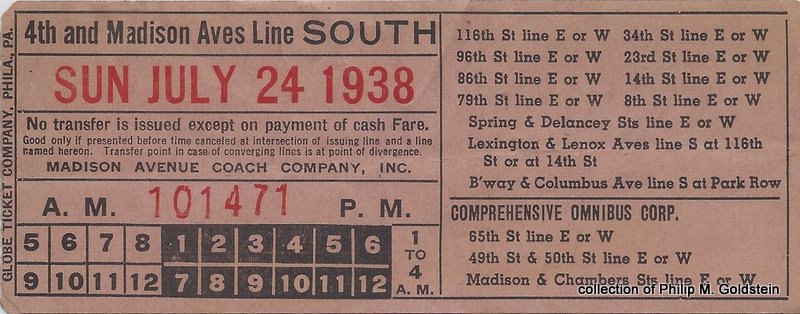
![]()
Surface Transportation Corp. - Manhattan
| Broadway |
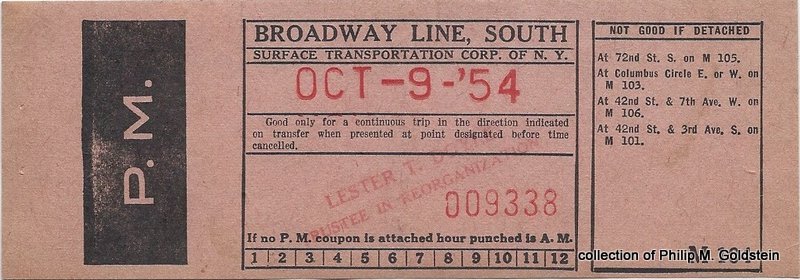 |
| South - PM (pink) - 1949-1956 detachable PM coupon Surface Transportation Corp of NY (receivership, Lester T. Doyle trustee) (Smith Patent copy) |
| 10th Avenue |
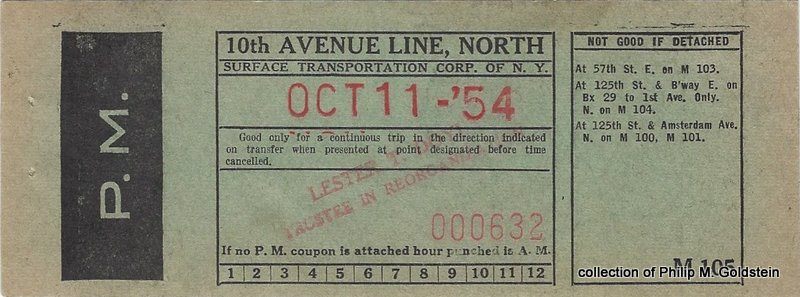 |
| (direction not specified) - PM (green) - 1949-1956 detachable PM coupon Surface Transportation Corp of NY (receivership, Lester T. Doyle trustee) (Smith Patent copy) |
| 42nd Street Crosstown |
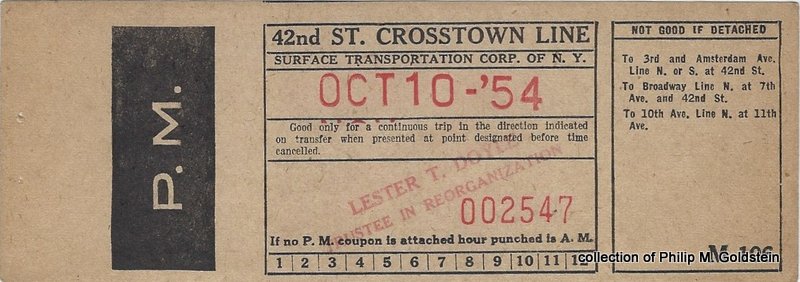 |
| (direction not specified) - PM (buff) - 1949-1956 detachable PM coupon Surface Transportation Corp of NY (receivership, Lester T. Doyle trustee) (Smith Patent copy) |
![]()
| 125th Street Crosstown Line |
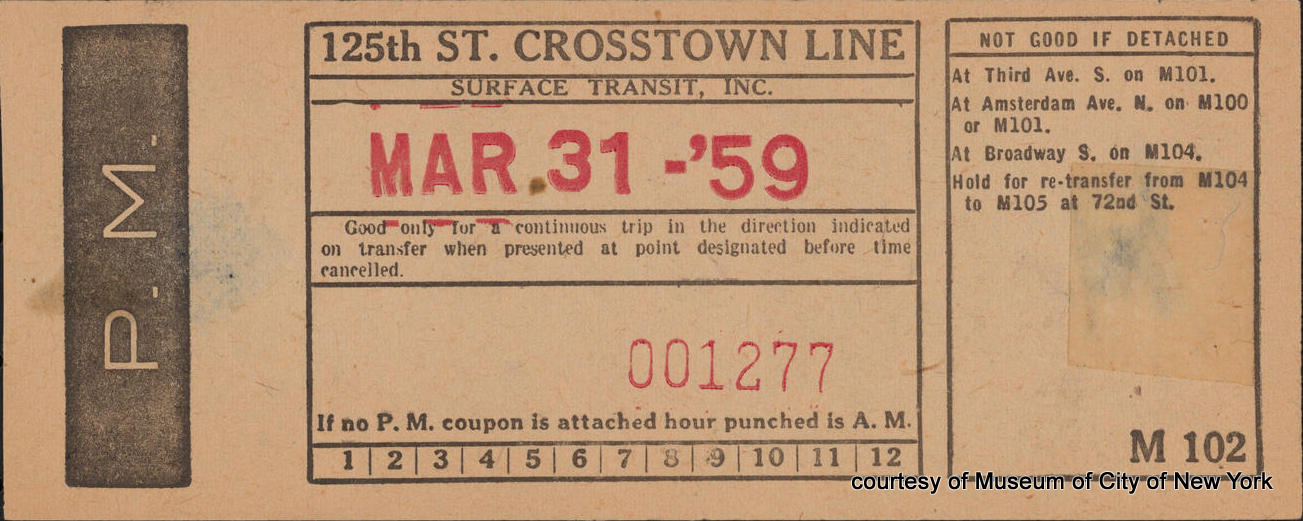 |
| (direction not specified) - PM (buff) - 1949-1956 detachable PM coupon Surface Transportation Corp of NY (receivership, Lester T. Doyle trustee) (Smith Patent copy) |
| . . |
| Third - Lexington - Amsterdam Avenues - South |
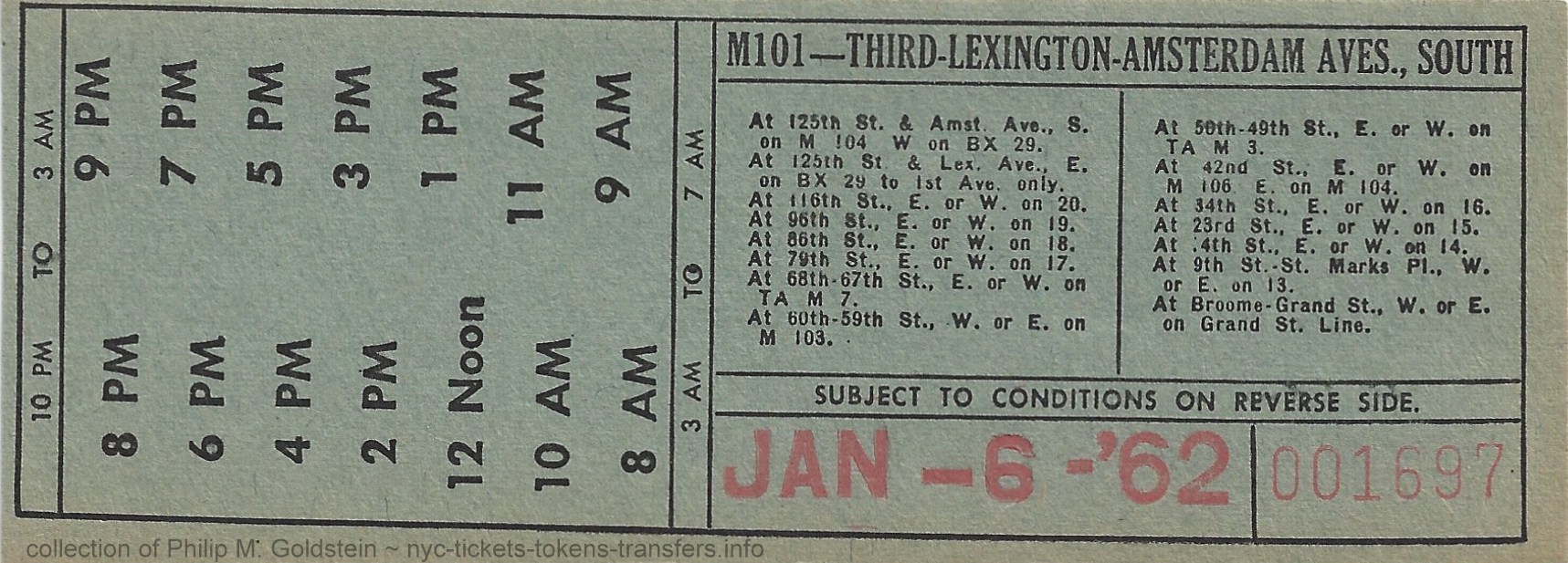 |
| M101 Third - Lexington - Amsterdam Avenues - South |
| . . |
 |
| Generic Month / Day / Hour / AM / PM tab From A Sub-route Bus to A Through Bus |
![]()
| Gouverneur & South Street Line |
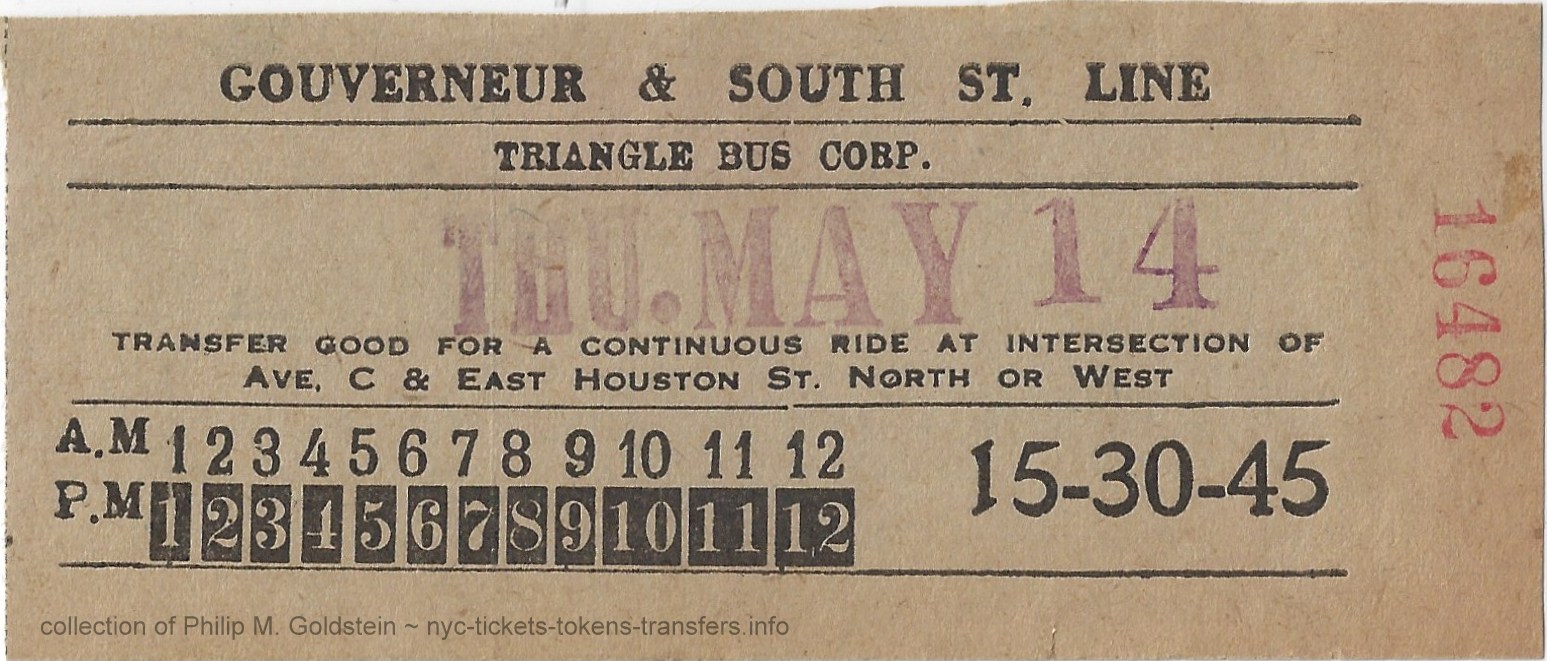 |
| intersection of Avenue C & East Houston Street North or West - Thursday, May 14, 1936 AM/PM hourly with quarter hour punch |
| . . |
| Avenue C & East Houston Street Crosstown |
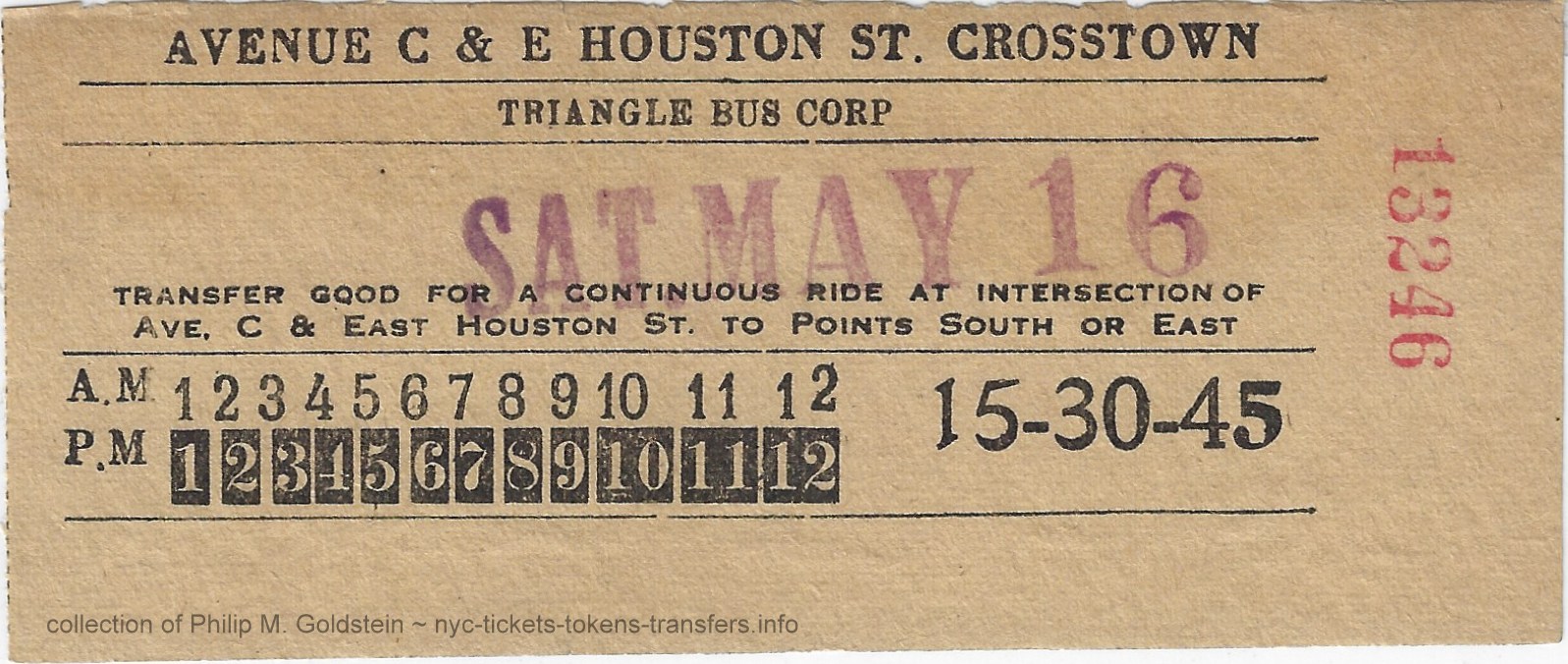 |
| intersection of Avenue C & East Houston Street to points South or East Saturday, May 16, 1936 AM/PM hourly with quarter hour punch |
| Affiliated Bus Transit |
Green Bus Lines | Jamaica Buses | North Shore Bus |
|
| . | ||||
| Queens Nassau Bus / Queens Transit |
Queens Transit |
Queens Surface Corp |
Steinway Transit |
Triboro Coach |
![]()
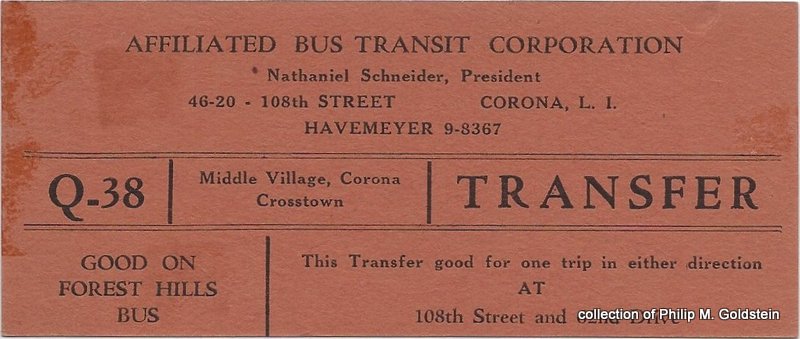 |
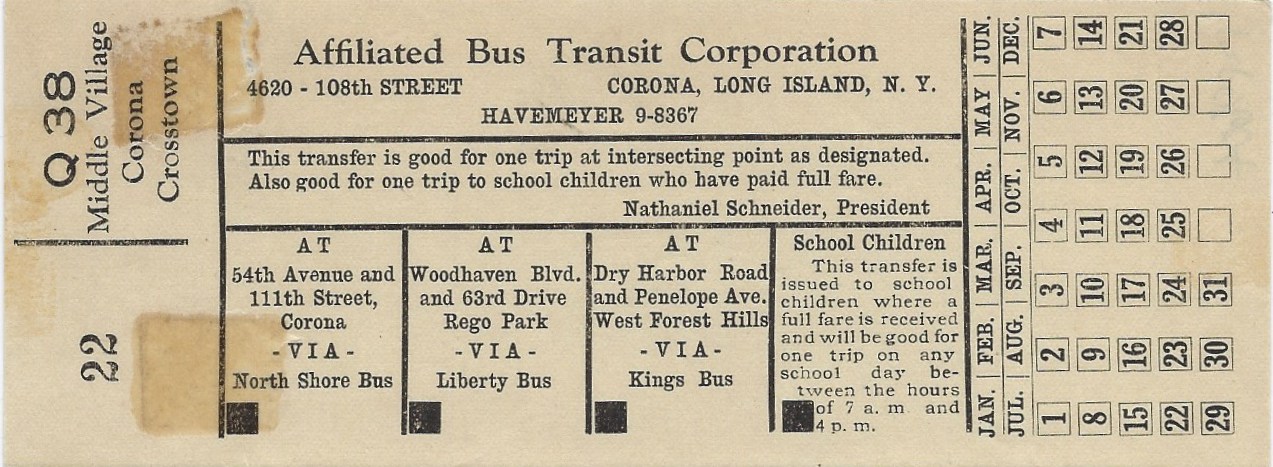 |
| Q-38 - Middle Village, Corona Crosstown good on Forest Hills Bus at 108th Street & 62nd Drive |
Q-38 - Middle Village, Corona Crosstown various points - unpunched |
| . | |
 |
|
| Q-38 - Middle Village, Corona Crosstown - September 23 various points - punched for 54th Avenue & 111th Street back of transfer states "copy", also this printed on a blue laid (ribbed) paper. Very unusual. |
![]()
 |
intentionally left blank |
| (red on buff paper) Q-6 Sutphin Blvd. - north to Jamaica day code: A hourly tear w/ detachable PM stub Kaymil Ticket |
|
| . | |
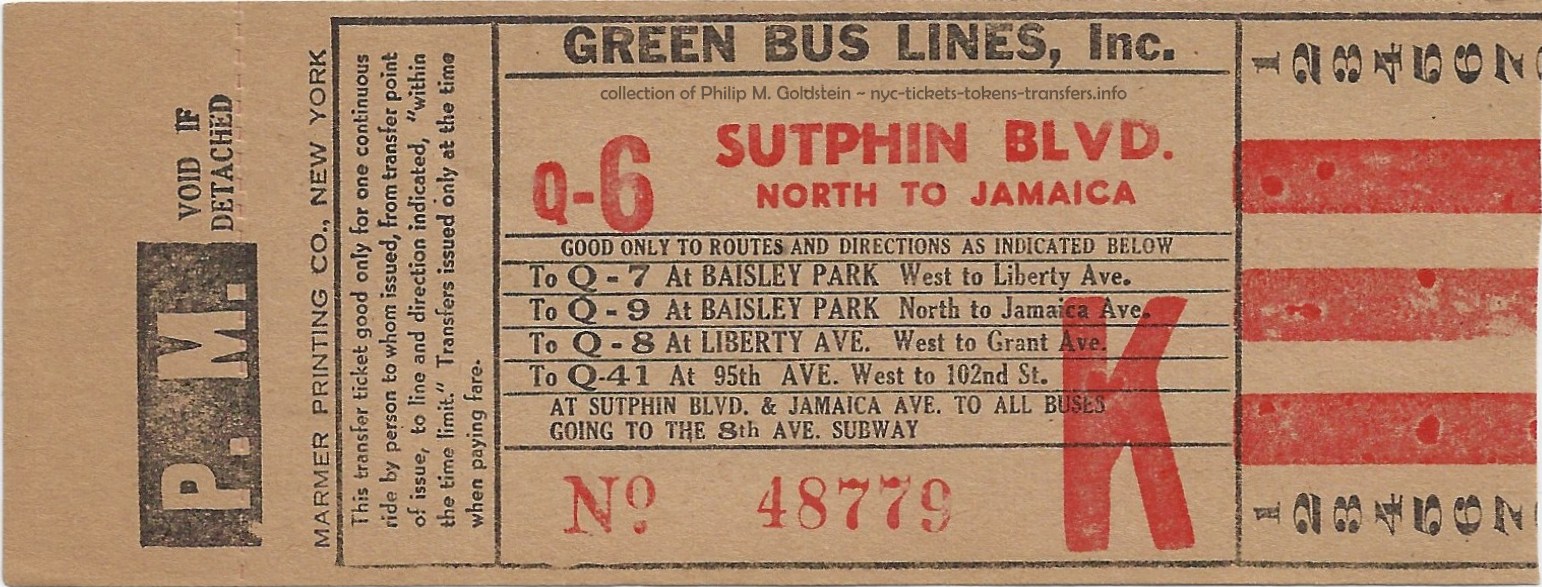 |
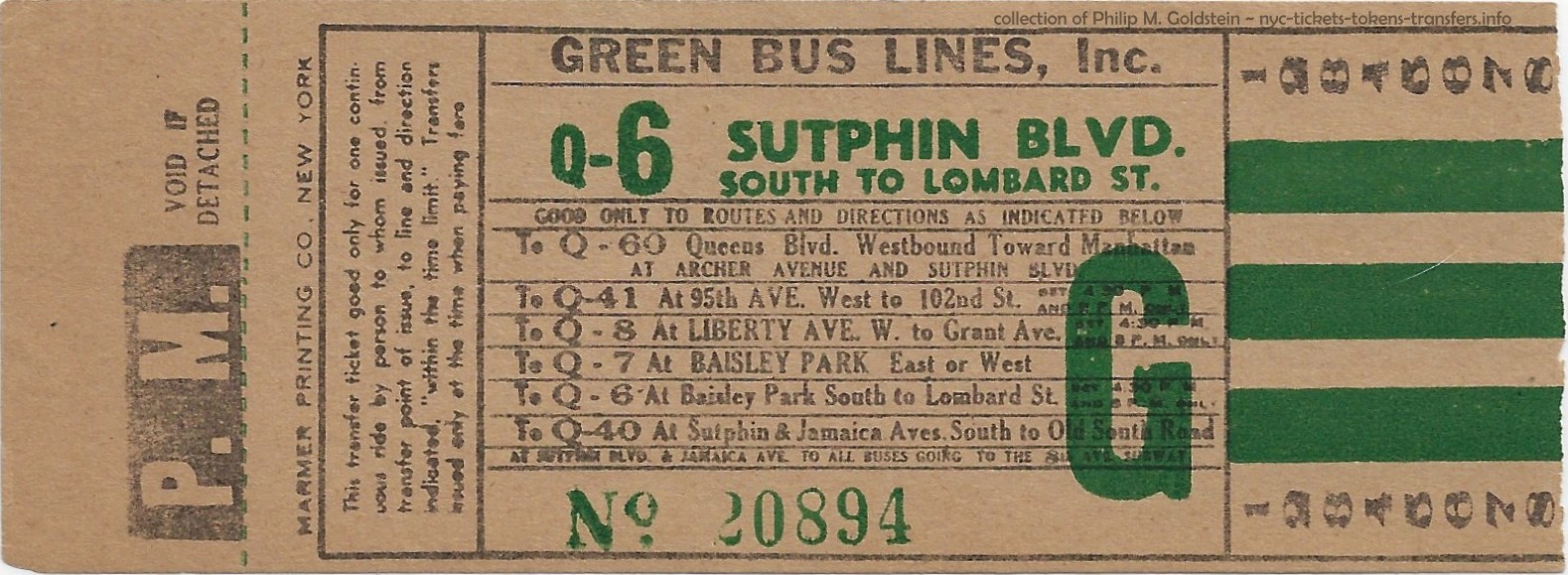 |
| (red on buff paper) Q-6 Sutphin Blvd. - north to Jamaica day code: K hourly tear w/ detachable PM stub Marmer Ticket |
(green on buff paper) Q-6 Sutphin Blvd. - south to Lombard St. day code: G hourly tear w/ detachable PM stub Marmer Ticket |
| . | |
| intentionally left blank | 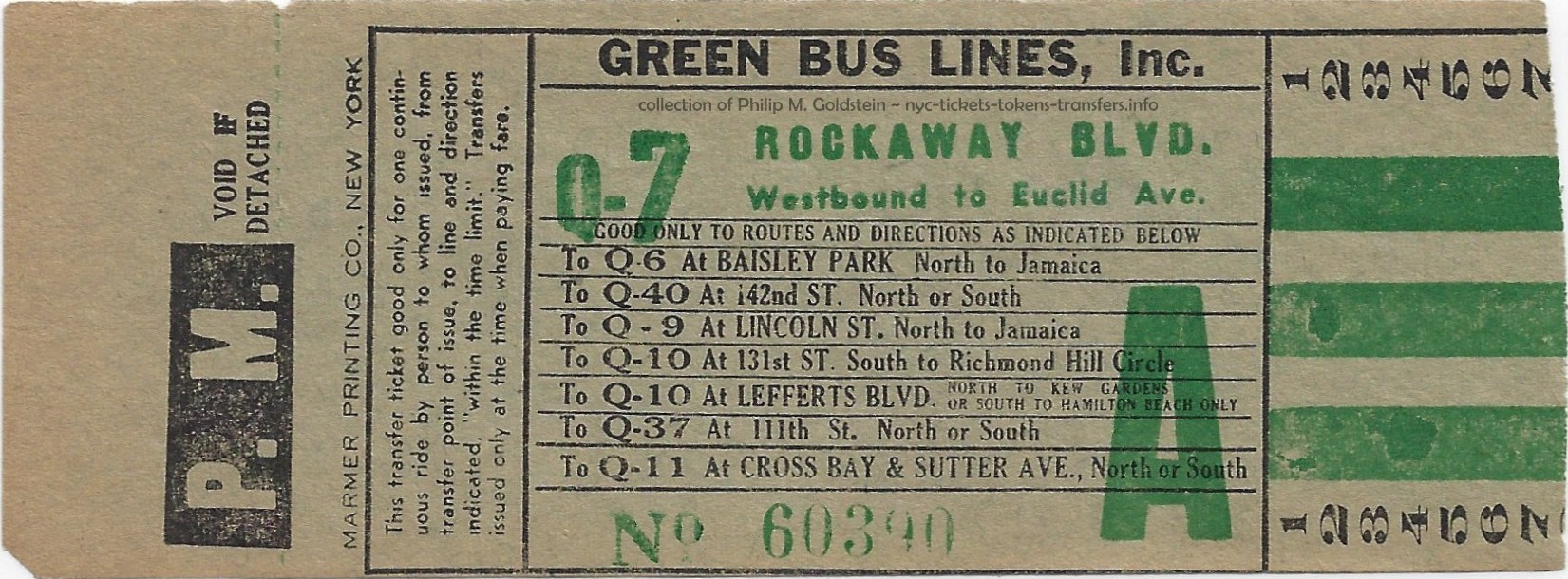 |
| (green on green paper) Q-7 - Rockaway Blvd - westbound to Euclid Ave. day code: A hourly tear w/ detachable PM stub Marmer Ticket |
|
| . | |
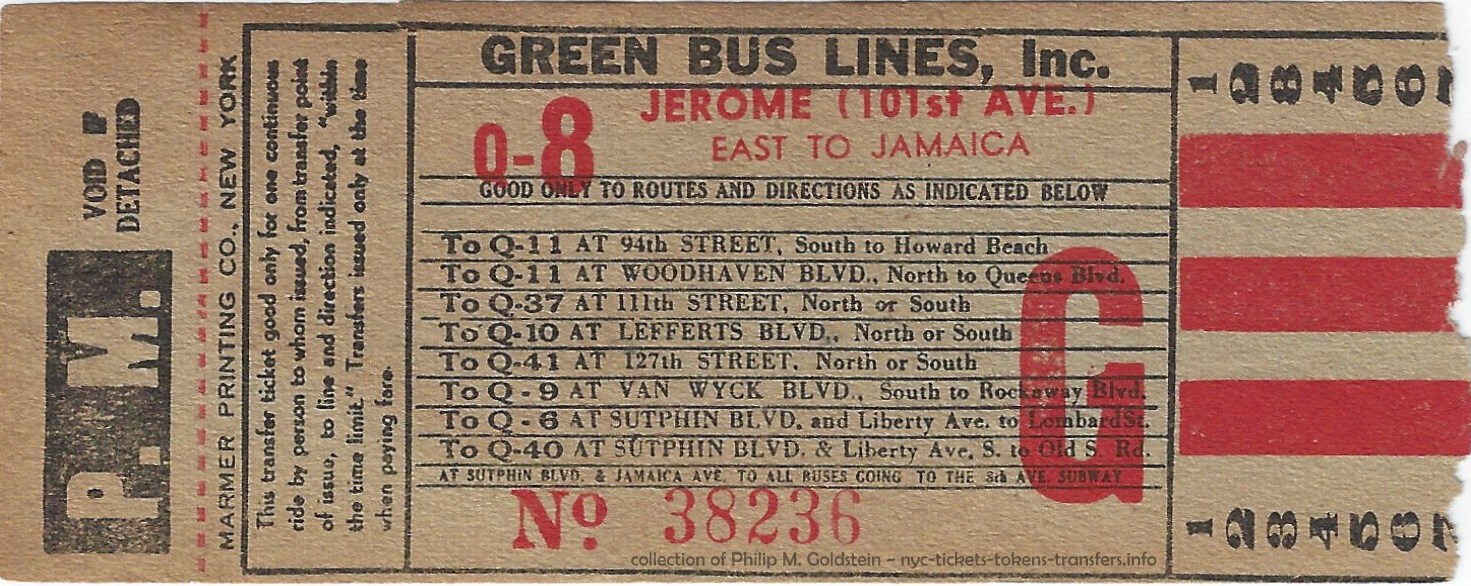 (red on buff paper)
Q-8 Jerome (101st Ave) - east to Jamaica day code: G hourly tear w/ detachable PM stub Marmer Printing |
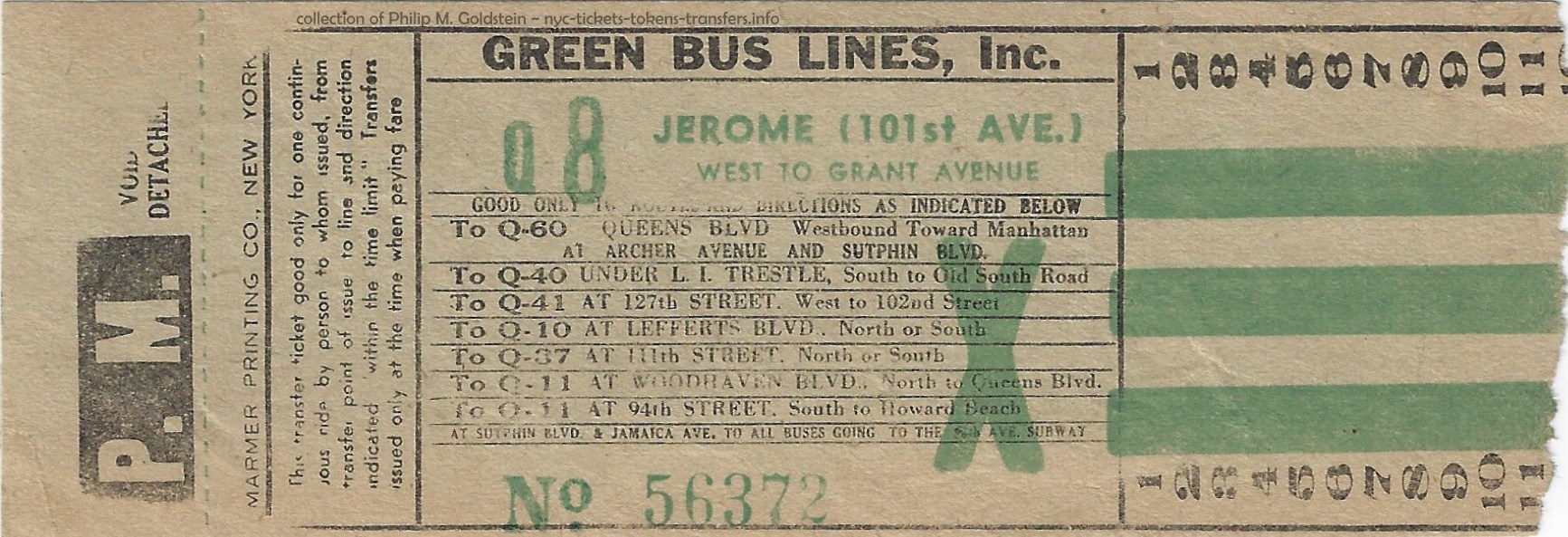 (green on green paper)
Q-8 Jerome (101st Ave) - west to Grant Avenue day code: X hourly tear w/ detachable PM stub Marmer Printing |
| . | |
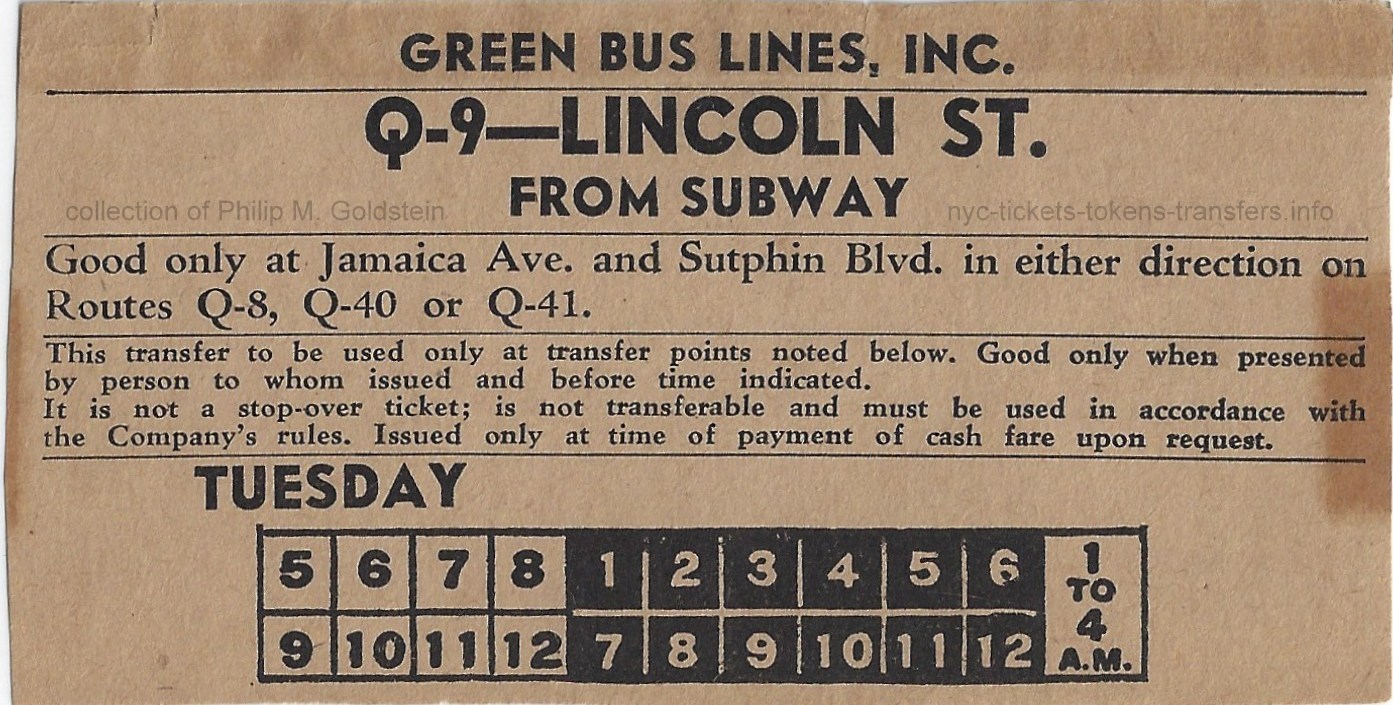 |
|
|
Q-9 Lincoln Street - from subway
Tuesday AM / PM hourly punch unknown printer - back marked "NY City 1935 obsolete" |
|
| . | |
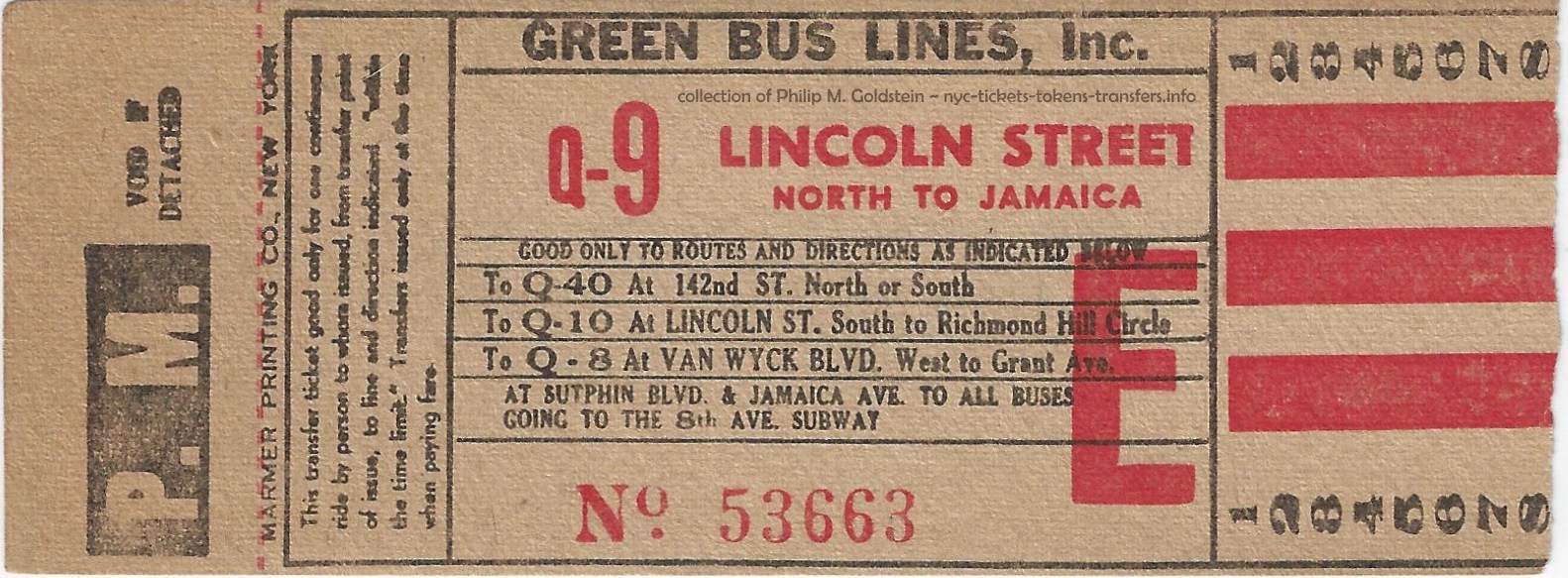 (red on buff paper)
Q-9 Lincoln Street - north to Jamaica day code: E hourly tear w/ detachable PM stub Marmer Printing |
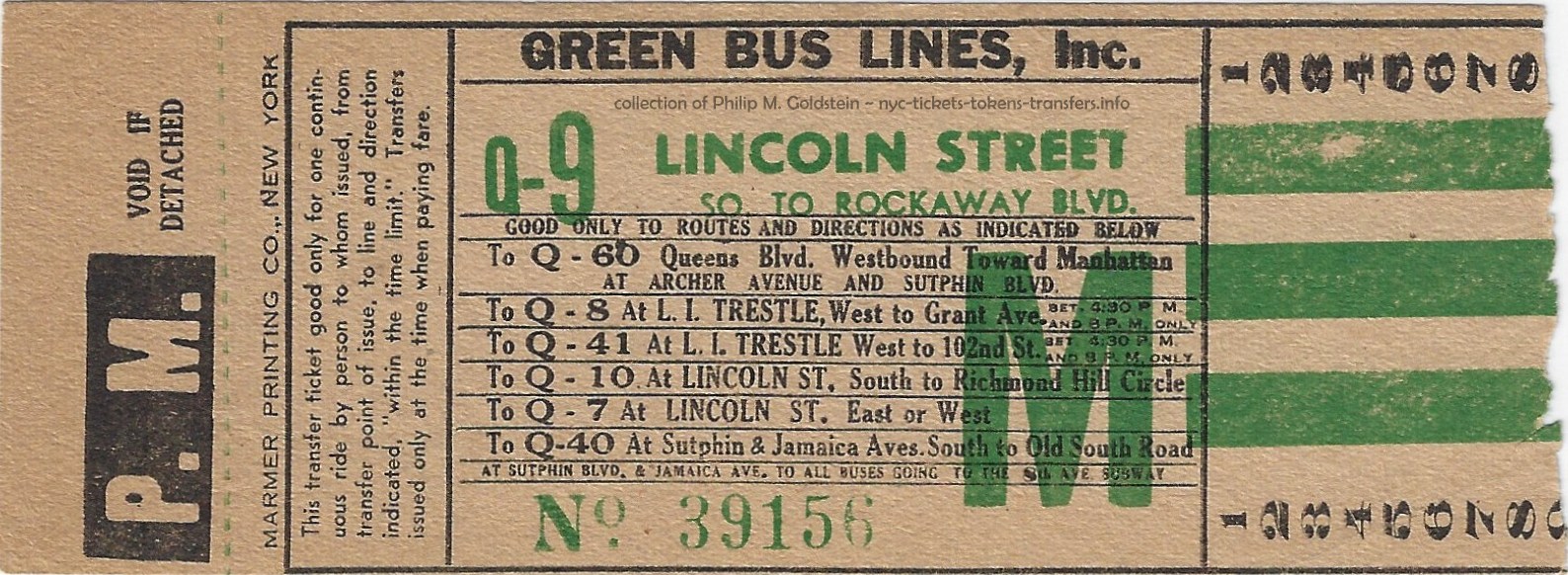 (green on buff paper)
Q-9 Lincoln Street - south to Rockaway Blvd day code: M hourly tear w/ detachable PM stub Marmer Printing |
| . | |
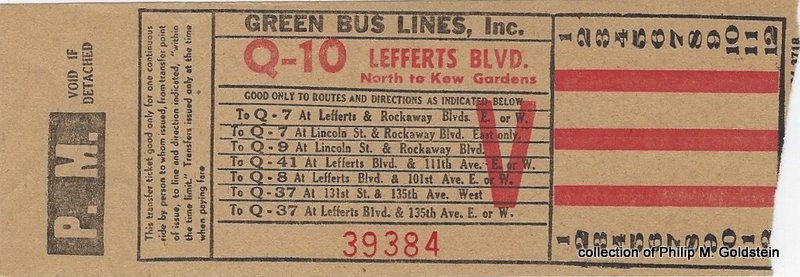 Q-10 Lefferts Blvd. - north to Kew Gardens day code: V hourly tear w/ detachable PM stub Kaymil Ticket |
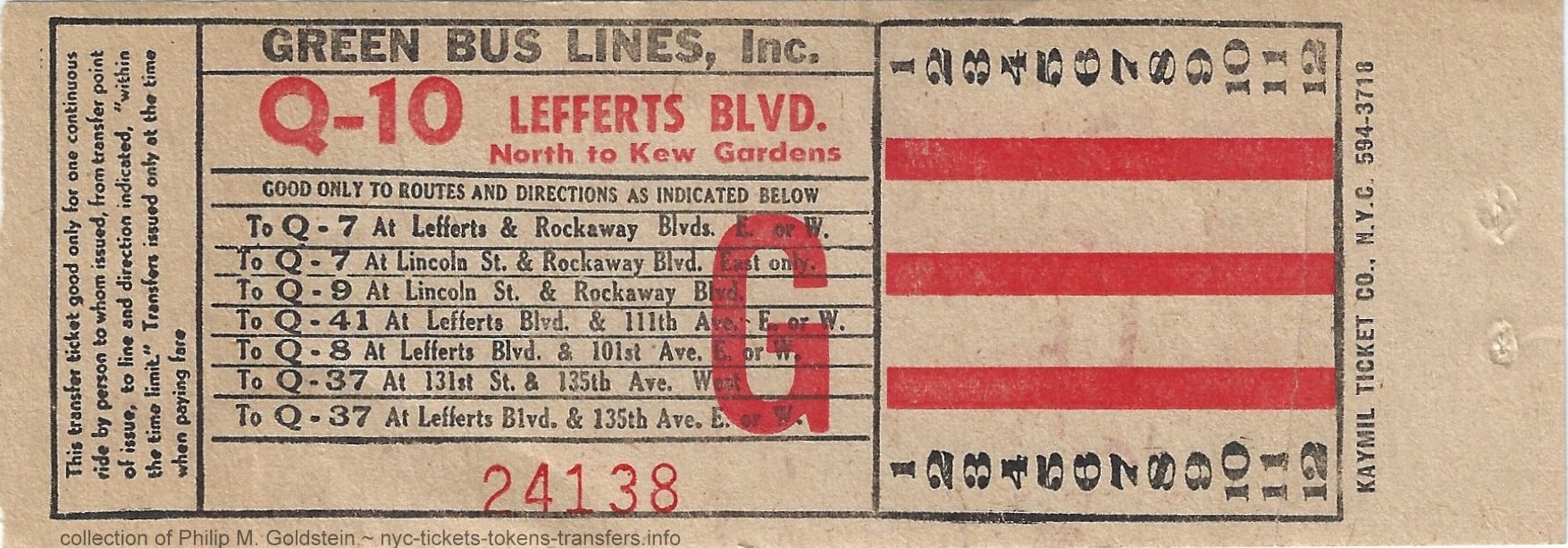 (red on buff paper) Q-10 Lefferts Blvd. - north to Kew Gardens day code: G hourly tear - no PM stub Kaymil Ticket |
| . | |
 (blue on buff paper)
Q-10 Lefferts Boulevard - Hamilton Beach day code: B hourly tear w/ detachable PM stub Marmer Printing |
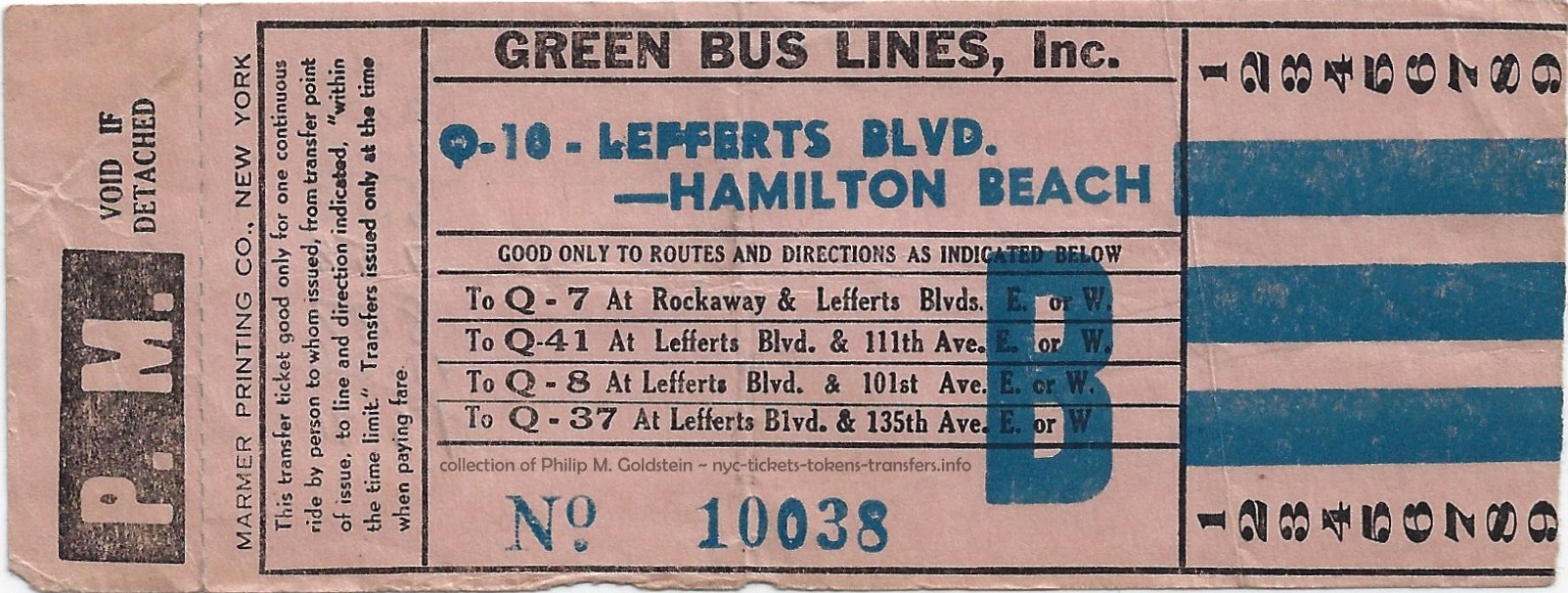 (blue on pink paper)
Q-10 Lefferts Boulevard - Hamilton Beach day code: B hourly tear w/ detachable PM stub Marmer Printing |
| . | |
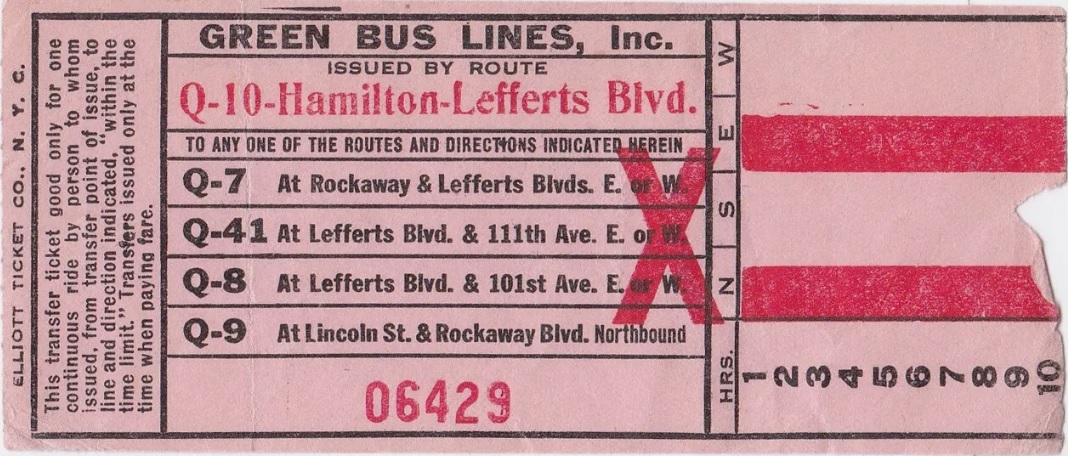 |
intentionally left blank |
|
(red on pink paper)
Q-10 Hamilton - Lefferts Boulevard day code: X hourly tear Elliott Printing |
|
| . | |
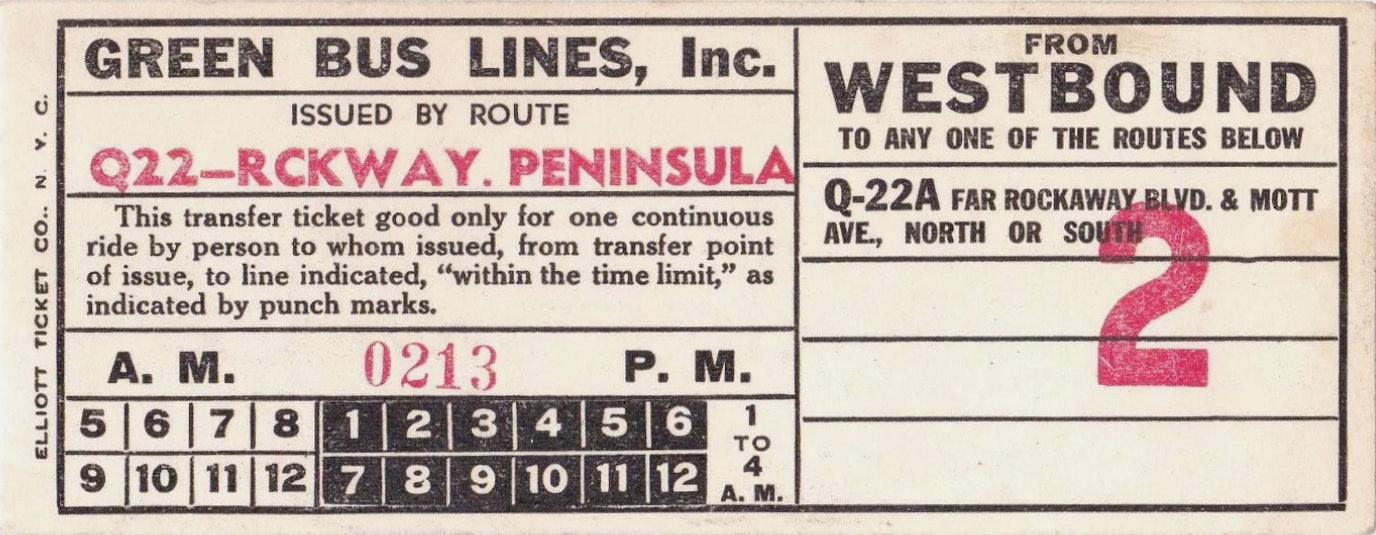 |
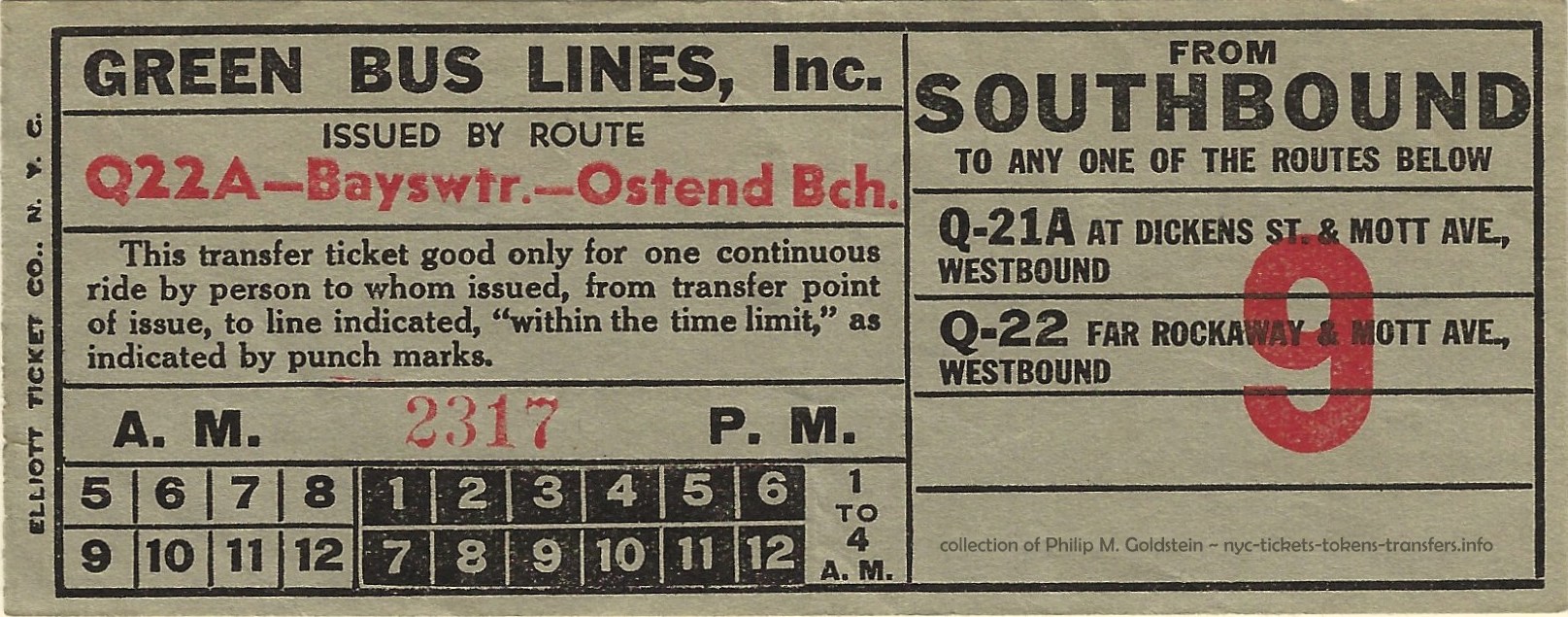 |
| (red on white paper) Q22 - Rockaway Penisula day code: 2 hourly punch AM / PM Elliott Ticket |
(red on green paper) Q22A Bayswater - Ostend Beach day code: 9 hourly punch AM / PM Elliott Ticket |
| . | |
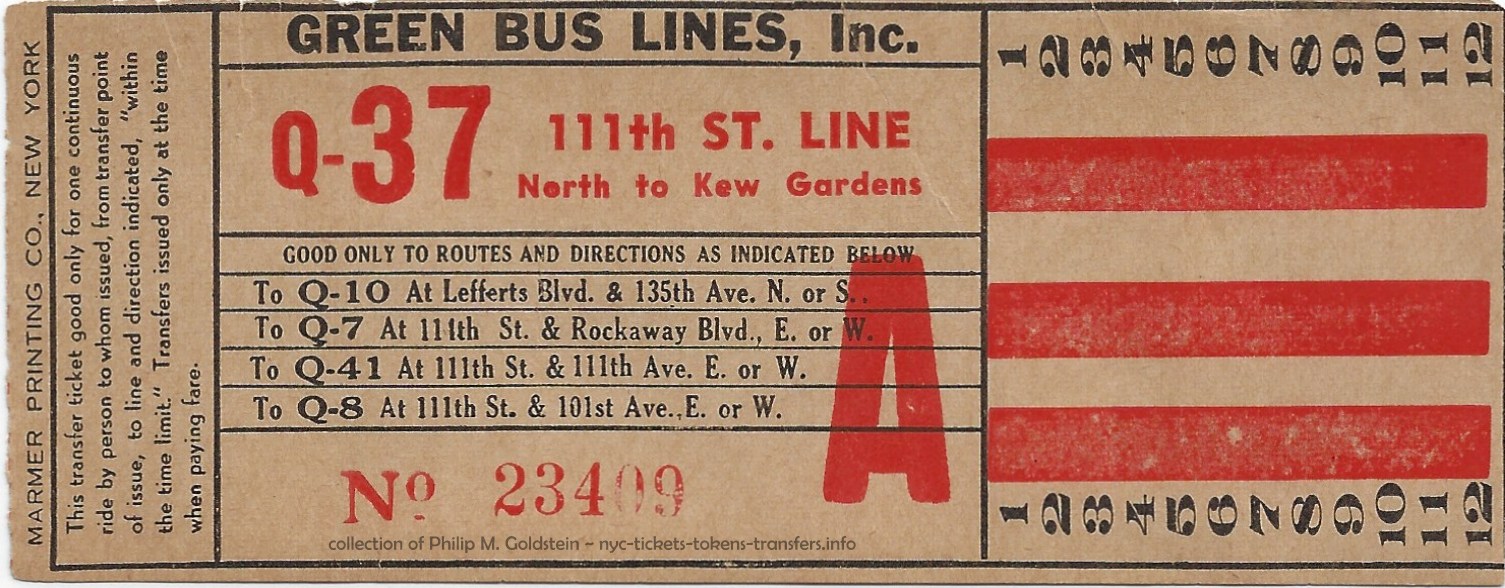 |
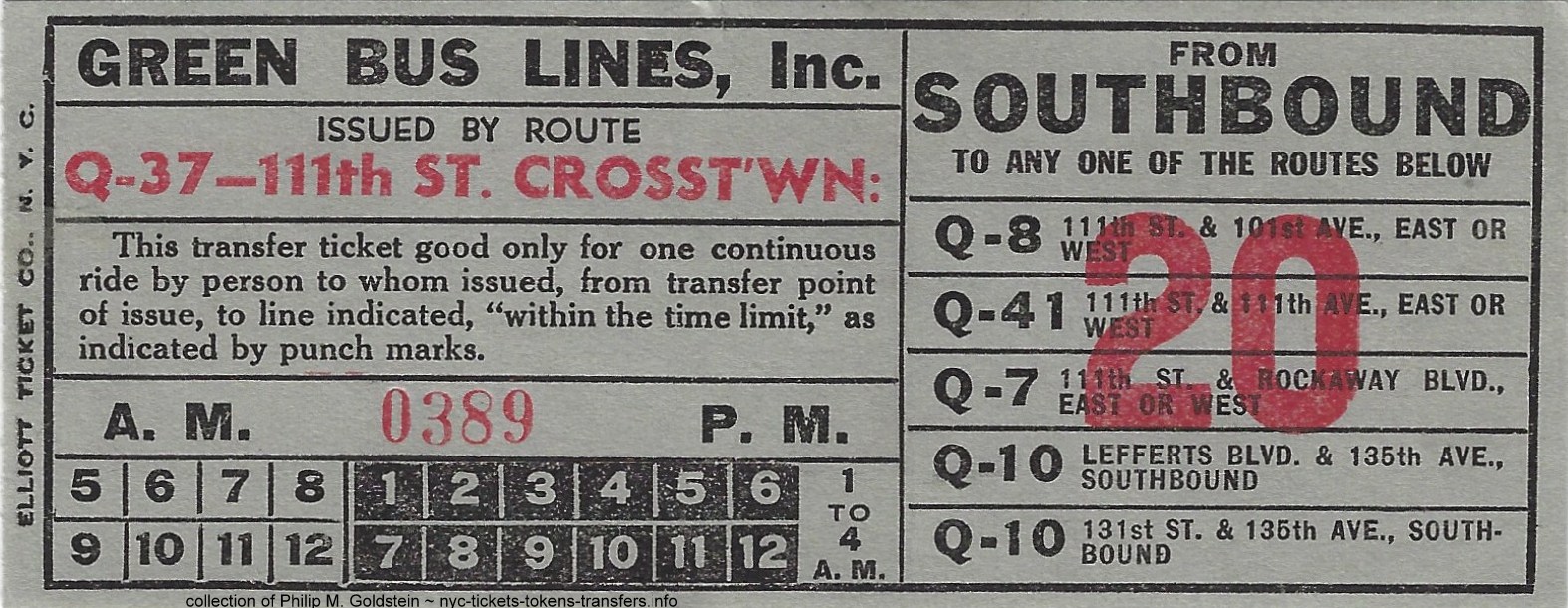 |
|
(red on buff paper)
Q-37 111th Street Line - north to Kew Gardens day code: A hourly tear Marmer Printing |
(black and red on green paper)
Q-37 111th Street Crosstown - southbound day code: 20 hourly punch AM / PM Elliott Ticket |
| . | |
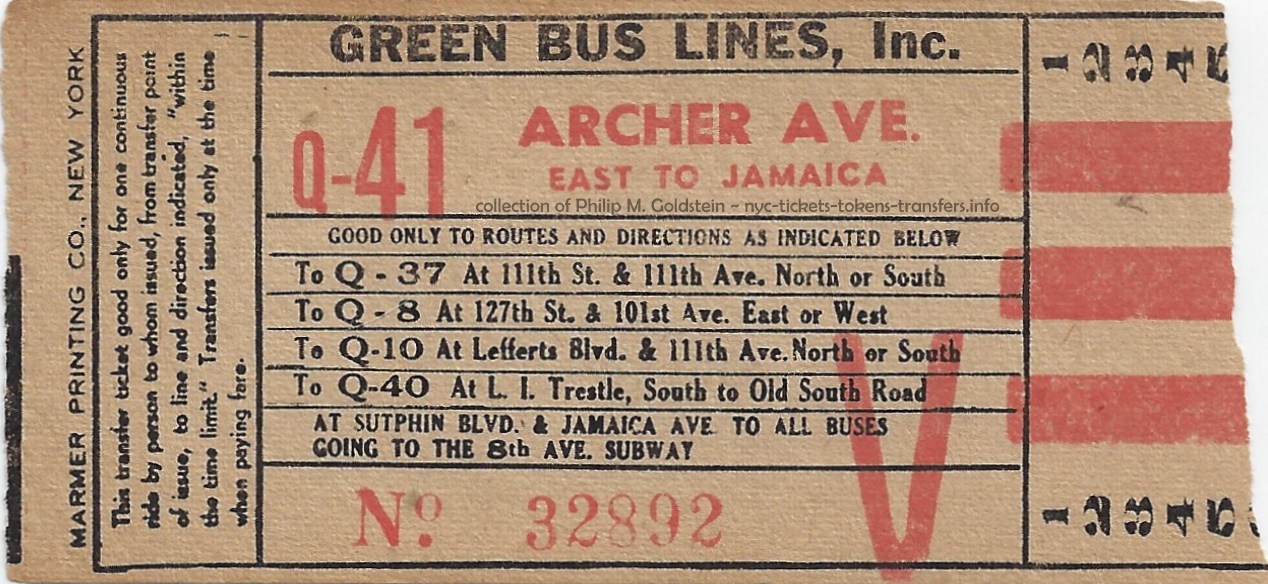 (red on buff paper)
Q-41 Archer Ave - east to Jamaica day code: V hourly tear w/ detachable PM stub Marmer Printing |
intentionally left blank |
 |
|
|
(green on thin white semi-gloss paper)
Q-41 Jamaica - Lindenwood, west to 157th Street and Cross Bay Boulevard day code: K hourly tear w/ detachable PM stub Marmer Printing |
|
![]()
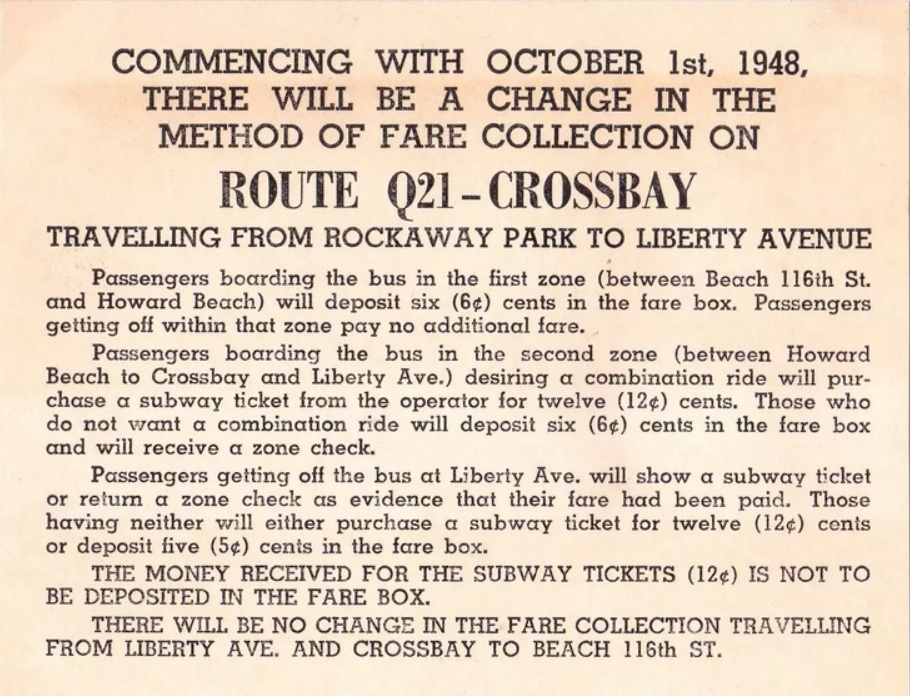 |
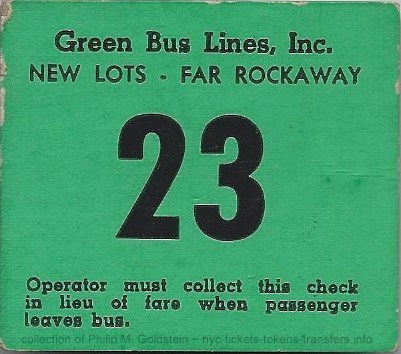 |
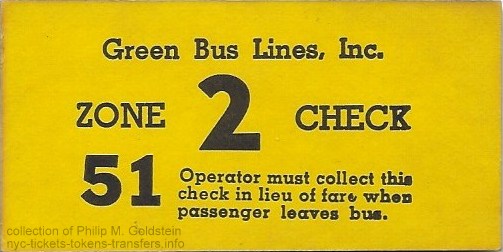 |
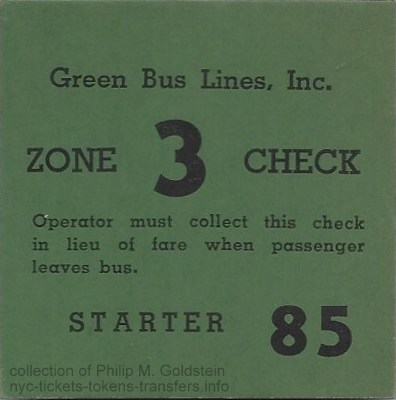 |
| New Lots - Far Rockaway 1 3/4" x 2" |
Zone 2 2 1/2" x 1 1/4" |
Zone 3 2" x 2" |
![]()
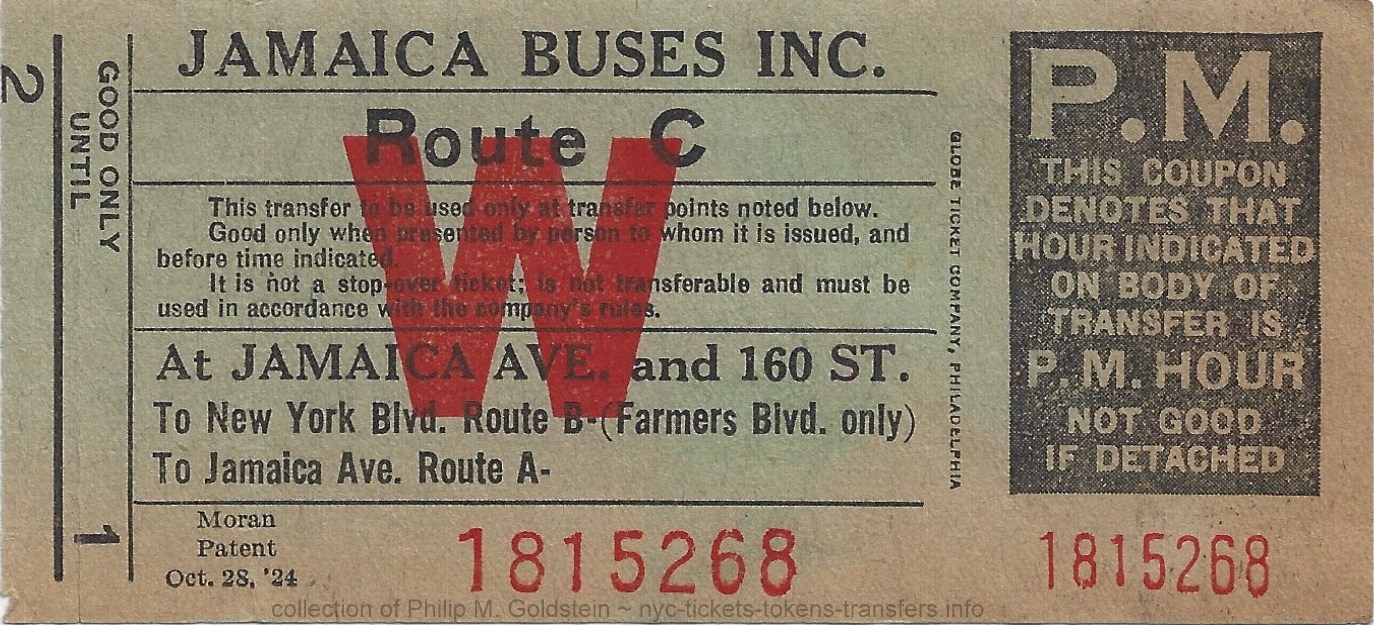 |
|
| Route C detachable PM coupon with tear off at hour Jamaica Avenue & 160th Street day code: W Moran Patent October 28, '24 |
|
| . | |
 Route Q-111 detachable PM coupon Jamaica Avenue & 160th Street day code: B Marmer Printing 7" x 2" |
|
 |
|
| Route Q-111 (off white paper) detachable PM coupon Jamaica Avenue & 160th Street day code: X (marked on back in pencil Kaymil Printing) 7" x 2" |
|
 |
 |
 |
| Q110 - Q112 East - ca. May 1990 Globe Ticket 9 1/4" x 2" |
Q110 - Q112 West - ca. May 1990 Globe Ticket 9 1/8" x 2" |
Q111 - Q113 North - ca. May 1990 Globe Ticket 9 1/4" x 2" |
![]()
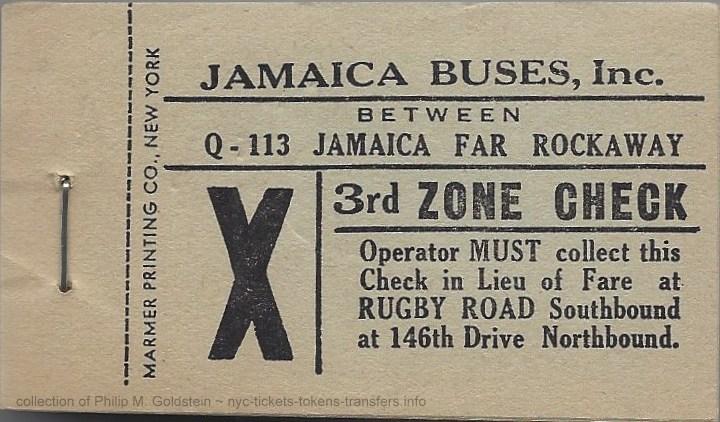

![]()
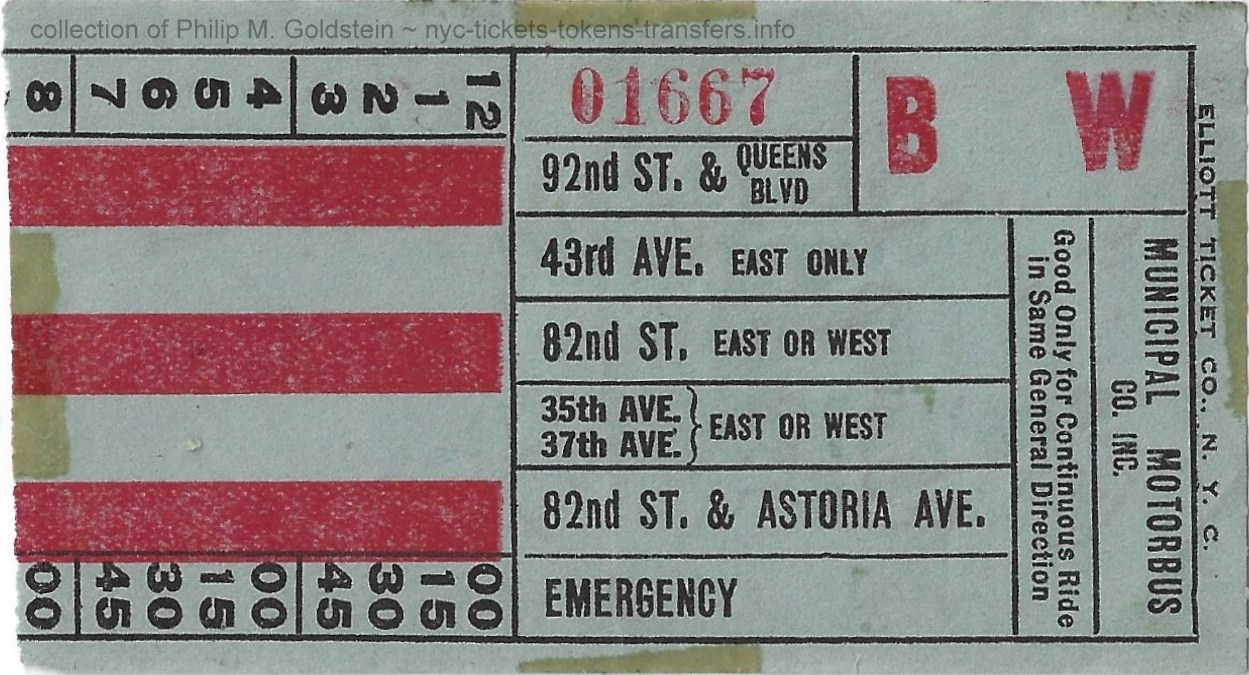
![]()
| Route List: | |||
| Route designation |
Terminals | via route | notes |
| Q1 | Jamaica - Hillside | former Bee Line | |
| Q2 | Jamaica - Hollis Avenue | Hempstead Avenue to Belmont Park | former Bee Line |
| Q3 | Jamaica - Hollis | JFK Airport via Farmers Blvd | former Bee Line |
| Q3A | Jamaica (Parsons Blvd. & Hillside Av.) St. Albans - Cambria Heights | Murdock & 113 Av. | former Bee Line; renumbered 1988 to Q83 by NYCTA |
| Q4 | Jamaica - Cambria Heights | Merrick & Linden Boulevards | former Bee Line |
| Q4A | Jamaica - Laurelton | Merrick Boulevard & 120 Avenue | former Bee Line; renumbered 1988 to Q84 by NYCTA |
| Q5 | Jamaica - Rosedale & Green Acres Shopping Mall | Merrick Boulevard | former Bee Line |
| Q5A | Jamaica - Rosedale | Rochdale Village and Bedell Street | former Schenck Transportation; renumbered 1988 to Q85 by NYCTA |
| Q5AB | Jamaica - Locust Manor LIRR Station | Springfield Gardens | former Schenck Transportation; combined with Q5A into Q85 in 1988 by NYCTA |
| Q5AS | Laurelton - Rosedale Shuttle | former Bee Line; renumbered 1988 to Q86 by NYCTA; then eliminated in 1995, low ridership, | |
| Q12 | Flushing - Little Neck | Sanford Avenue. & Northern Boulevard | |
| Q12A | Little Neck LIRR Station - Floral Park | Little Neck Parkway | 1933; renumbered to Q79 by NYCTA, then eliminated low ridership; reinstated via compromise as part of the extended Q36 in 2013 |
| Q13 | Flushing - Bayside - Fort Totten | Northern & Bell Boulevards | 1933 |
| Q14 | Flushing - Whitestone | 1933; eliminated 2010, budget cuts; subsequently replaced with the Q15A route | |
| Q15 | Flushing - Whitestone - Beechhurst | 1933 | |
| Q16 | Flushing - Clearview - Fort Totten | Bayside Avenue, Francis Lewis & Willets Point Boulevards or Utopia Parkway |
1933 |
| Q17 | Flushing - 188 Street & Jamaica | ||
| Q17A | Jamaica - Little Neck | Utopia Parkway & Horace Harding Boulevard | renumbered 1988 to Q30 by NYCTA |
| Q17-20 | combination of Q17 and Q20 routes which operated in the 1940s and 1950s | ||
| Q20 | Flushing - College Point Shuttle | renumbered to Q44FS, Re# Q20 1990; then to Q20A & Q20B 1999 by NYCTA extended to Jamaica | |
| Q23 | 108th Street, Corona-Ditmars Avenue (pre 1933) | originally North Shore, transferred first to Kings Coach Company (1931??), then to Triboro Coach Corporation in 1936?, then to MTA Bus Company in 2005 |
|
| Q26 | Flushing - Auburndale | Hollis Court Boulevard | |
| Q27 | Flushing - Rosewood – Queens Village & Cambria Heights | Springfield Boulevard | |
| Q28 | Flushing - Bayside West | before 1933 | |
| Q31 | Jamaica - Bayside West | ||
| Q35 | Flushing - College Point – Whitestone | substitute for LIRR Whitestone Branch; replaced by Q20 in 1937 | |
| Q32 | Queens Village LIRR - Creedmoor shuttle | ||
| Q36 | Jamaica - Floral Park | Hillside & Jamaica Avenues | |
| Q42 | Jamaica - Addisleigh Park | Sayres Avenue | |
| Q43 | Jamaica LIRR Station – Hillside Av. to City Line. | ||
| Q44 | Jamaica - Flushing – Bronx. | ||
| Q44A | Union Turnpike - Kew Gardens – Lake Success & Glen Oaks | renumbered 1990 to Q46 by NYCTA | |
| Q44B | Malba Shuttle | eliminated 1990, low ridership | |
| Q44VP | Union Turnpike - Kew Gardens & Vleigh Place Shuttle | renumbered 1990 to Q74 by NYCTA, eliminated 2010, budget cuts | |
| Q48 | Flushing - LaGuardia Airport | began operating April 5, 1940 | |
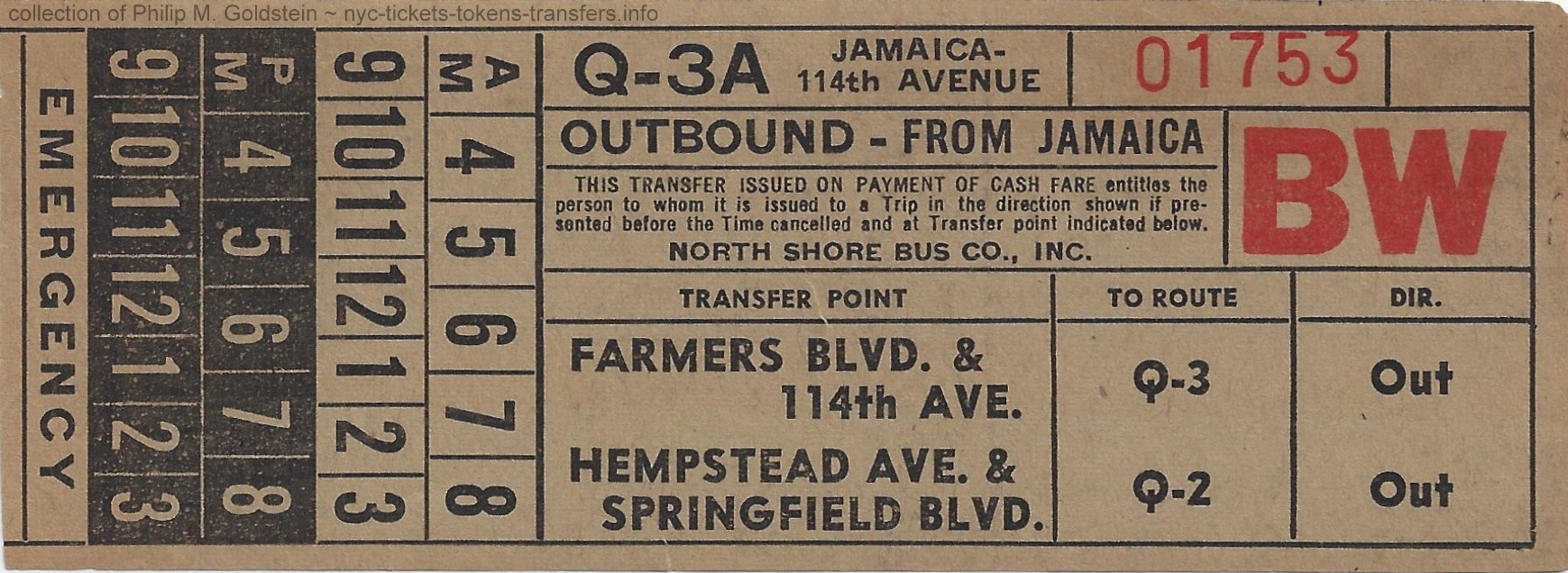 |
| unknown date day code: BW Q-3A Jamaica - 114th Avenue - Outbound from Jamaica |
| . |
 |
| ca. November 1942 day code: ZX Q-5 Merrick Boulevard - Inbound to Jamaica |
| . |
 ca. November 1942 day code: PK Q-43 Hillside Avenue - Inbound to Jamaica |
![]()
| Route List: | |||
| Route designation |
Terminals | via route | notes |
| Q25 | Flushing - Jamaica | Parsons Boulevard | Q25 service began in 1928, under the operation of the Flushing Heights Bus Company. This route was formally known as Route Q-25, Flushing-Jamaica via Parsons Boulevard Line. The original Q25 terminus was located in Flushing, and the original Q34 route was the College Point segment of the Q25. Subsequently The Q25 was combined with the then-Q34 route into College Point, and the Q34 was later rerouted to its current alignment in Whitestone and then extended along the Q25 route. |
| Q34 | Flushing - College Point | same |
On May 25, 1933, Queens–Nassau Transit received a one-year franchise for route "Q-34" from Flushing to College Point. The route began service in April 1933. |
| Q25-34 | College Point - Jamaica | Parson Boulevard | On July 16, 1937, Queens–Nassau Transit combined the Q25 and the Q34 to become the Q25-34 operating from College Point to Jamaica.[22] At this point, buses used the Q25/34 designation.[23] Toward College Point, the buses would use the sign Q25/34, and toward Jamaica the signs would use Q34/25. The Roosevelt Avenue short-turns would use Q25, while the through buses to College Point would use Q34. |
| Q65 | Jamaica 164th St - College Point | Northern Boulevard | Q65 bus service between Flushing − Main Street and 160th Street in Jamaica began with buses fully replacing trolley service on the Flushing–Jamaica Line on August 10, 1937. Initially, this route ran along Kissena Boulevard and Bowne Street between Horace Harding Boulevard and 46th Avenue, with 164th Street impassible by vehicles through Kissena Park. Service on the College Point trolley was abandoned on August 23 of that year, replaced by buses between 110th Street and Flushing. The Flushing-Jamaica buses were rerouted onto 164th Street after the road was paved and opened on August 10, 1938. The company's stock and property were transferred to its subsidiary Queens-Nassau Transit Lines company, which operated the buses. By 1940, the Q65 route ran between College Point and Jamaica. That year, the company applied for an extension of the route north along 122nd Street (College Point Boulevard), which was never implemented. |
| Q66 | Northern Boulevard | Bus service began on September 5, 1937, replacing trolley operation. Prior to 1989, the route ran from Flushing-Main Street to 51st Street in Woodside. In 1989, due to the opening of the IND 21st Street–Queensbridge station ("F" line), the Q66 was extended to Long Island City to promote the opening of the 63rd Street Tunnel. |
|
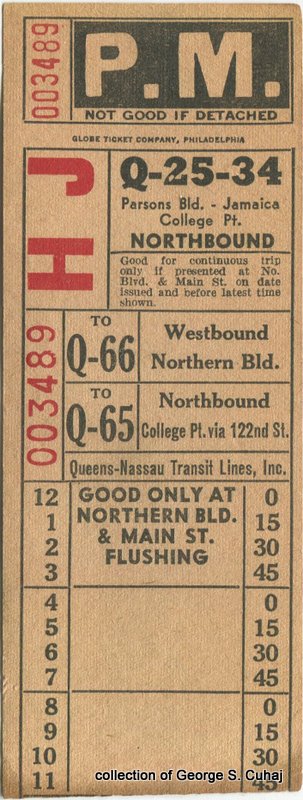 |
 |
| 1926-1957 detachable PM coupon Q-25-34 Parsons Bld. / Jamaica / College Point - Northbound day code: HJ good only at Northern Boulevard & Main Street Flushing to Q-66 Westbound Northern Boulevard to Q-65 Northbound College Point via 122nd Street Globe Ticket |
1926-1957 detachable PM coupon Q-65 Jamaica / 164th Street / College Point - Northbound day code: UD good only at Northern Boulevard & Main Street Flushing to Q-66 Westbound Northern Boulevard to Q-34 Northbound College Point via Airport Globe Ticket |
![]()
 |
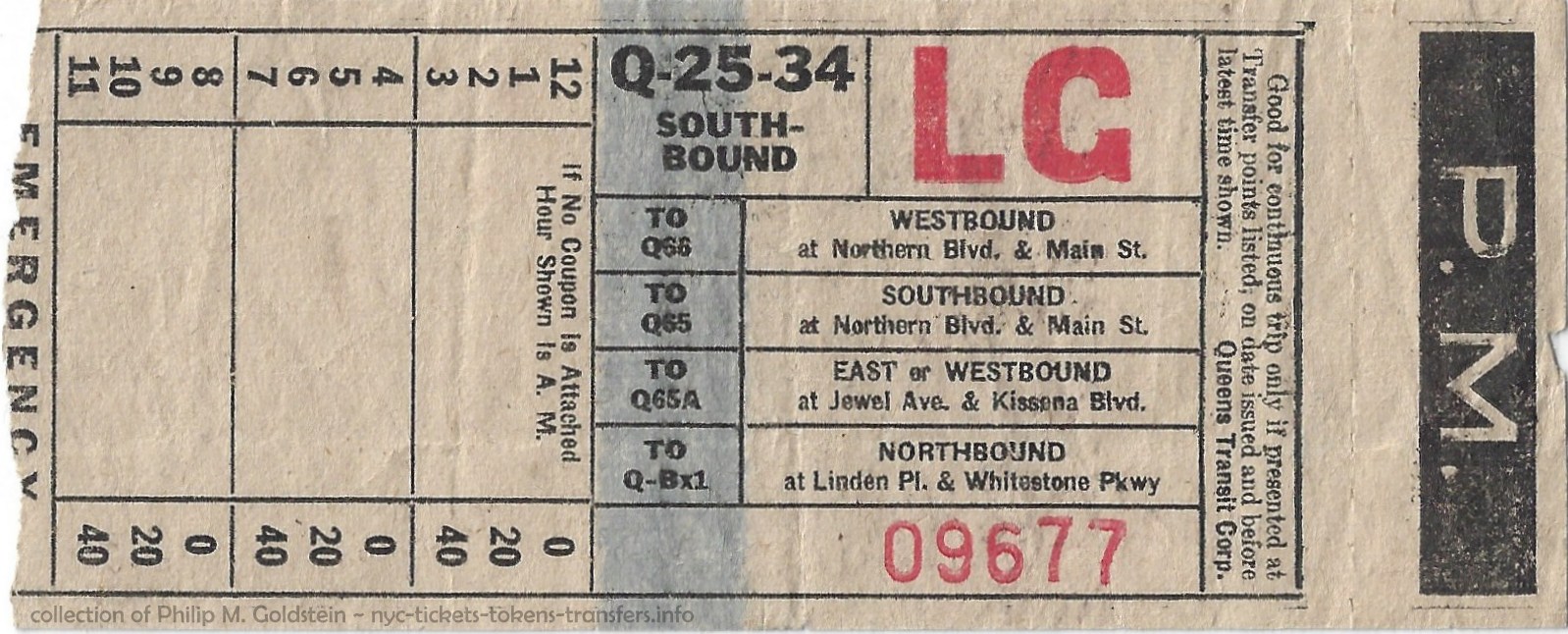 |
| Q-25-34 Southbound detachable PM coupon day code: VY |
Q-25-34 Southbound day code: LG |
| . | |
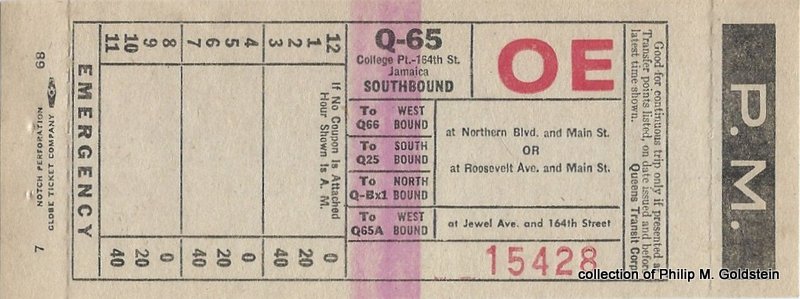 Q-65 Southbound detachable PM coupon day code: OE College Point - 164th St Jamaica at Northern Boulevard and Main Street or Rossevelt Ave. and Main Street |
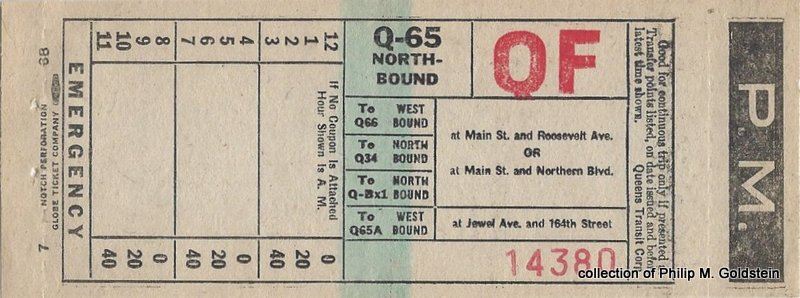 Q-65 Northbound day code: QF Main Street and Roosevelt Ave. or Main Street and Northern Boulevard at Jewel Avenue and 161st St. |
| . | |
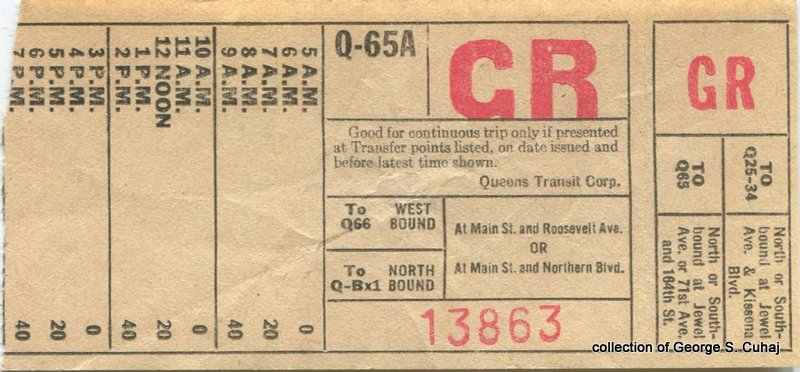 Q-65A day code: GR at Main Street and Roosevelt Avenue or Main Street and Northern Blvd. |
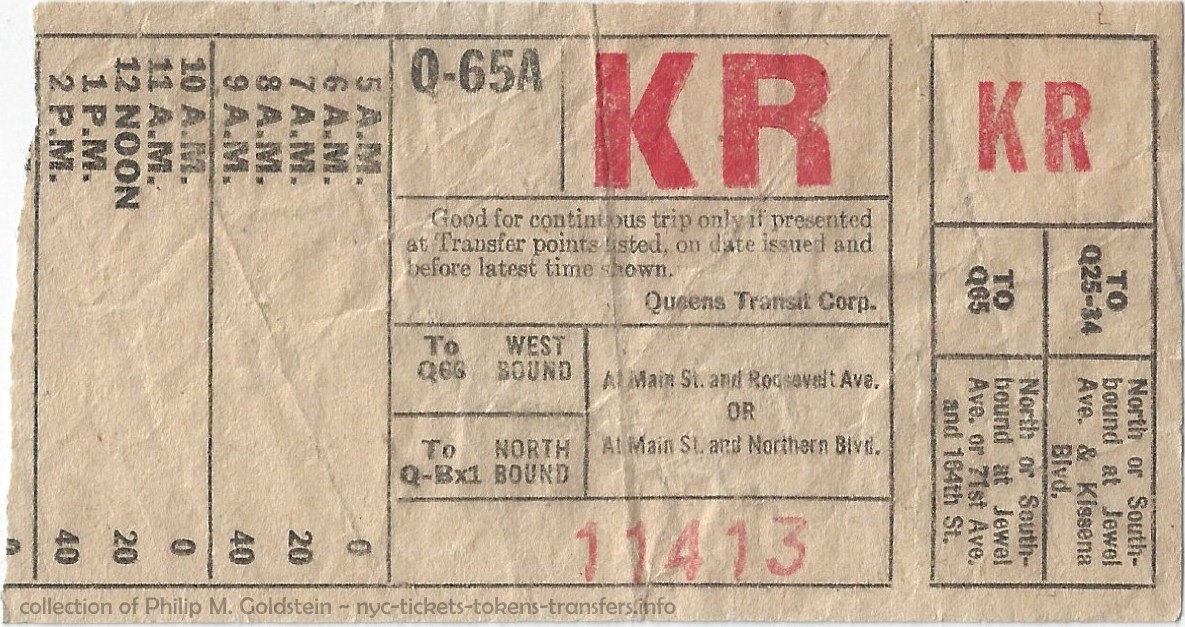 Q-65A detachable PM coupon day code: KR at Main Street and Roosevelt Avenue or Main Street and Northern Blvd. |
| . | |
Q-66 - Eastbound to Q-65A day code: KR Westbound at Jewel Avenue and 164th St. East or Westbound at Kissena Blvd & Jewel Avenue |
|
| . | |
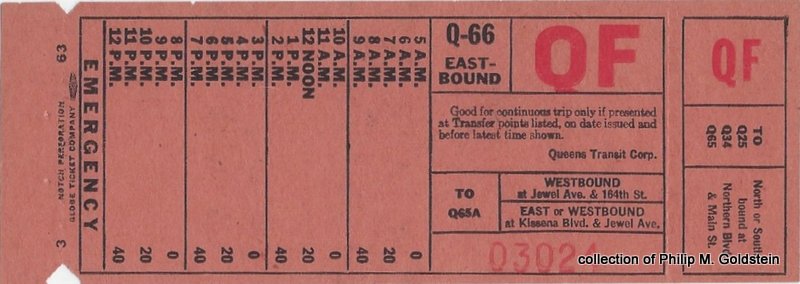 Q-66 - Eastbound day code: QF Westbound at Jewel Avenue and 164th St. East or Westbound at Kissena Blvd & Jewel Avenue |
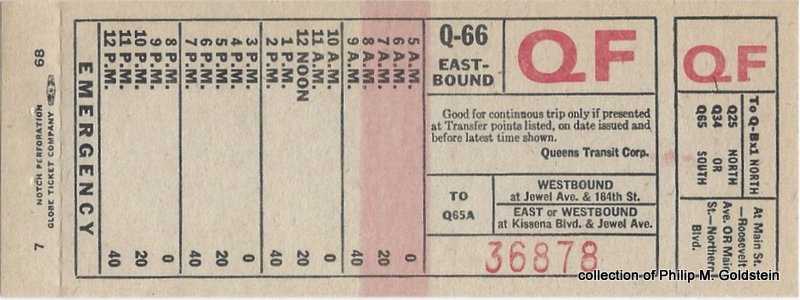 Q-66 - Eastbound day code: QF Westbound at Jewel Avenue and 164th St. East or Westbound at Kissena Blvd & Jewel Avenue. |
![]()
 Generic for: Q65A / Q66 / Q101 / Q102 / Q104 / Wall Street - Eastbound Globe Ticket |
![]()
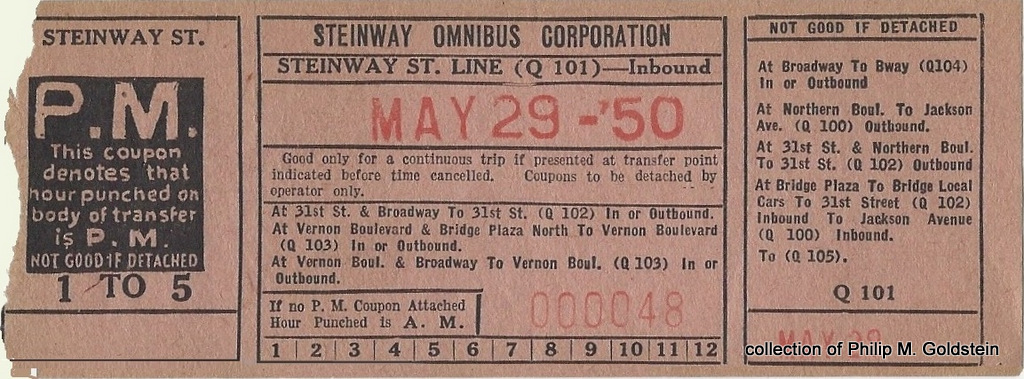 |
 |
|
| Steinway St Line (Q101) Inbound - May 29, 1950 detachable PM coupon |
31st Street Line (Q102) Outbound - May 2, 1957 detachable PM coupon |
|
| . | ||
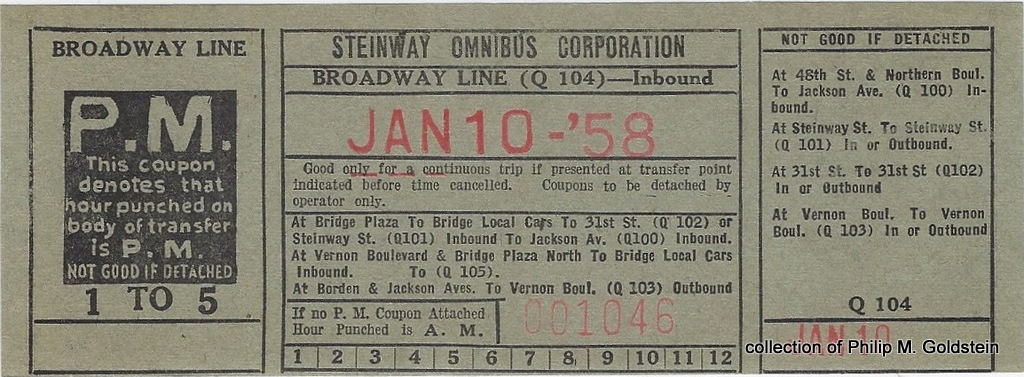 |
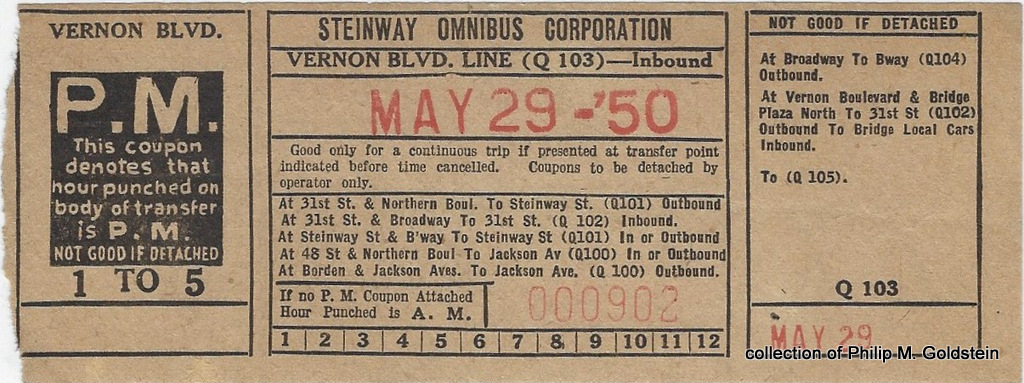 |
|
| Broadway Line (Q104) Inbound - January 10, 1958v |
Vernon Boulevard (Q103) Inbound - May 29, 1950 detachable PM coupon |
|
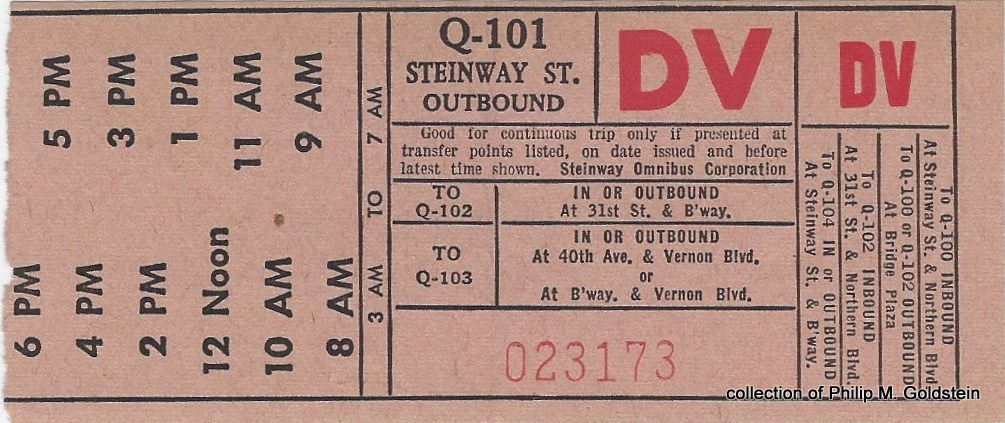 Q101 - Steinway Street Outbound day code: DV |
intentionlly left blank |
![]()
| Route List: | |||
| Route designation |
Terminals | via route | notes |
| Q101 | 59th St. & 2nd Ave. Manhattan - North Beach | Jackson Avenue, Northern Boulevard, Steinway Street, and 19th Avenue | formerly Steinway Street Line, abandoned 1939 now the bus |
| Q102 | Long Island City - Astoria Ferry | Jackson Avenue, 31st Street, Newtown Avenue, and Astoria Boulevard | 31st Street Line, abandoned 1939 now the bus |
| Q103 | Hunters Point - Astoria Ferry | Vernon Boulevard | Vernon Boulevard Line, abandoned 1939 now the bus |
| Q104 | Astoria Ferry - Woodside | Broadway | Broadway Line, abandoned 1939 now the bus |
| Q100 | Hunters Point - Woodside | Jackson Avenue, Northern Blvd | Jackson Avenue Line, now abandoned |
| Triboro Coach Q19 | Astoria Ferry - Bowery Bay | Astoria Boulevard | Flushing Avenue Line, abandoned 1935 - route later taken over by Triboro Coach Q19, Astoria-Corona |
 |
intentionally left blank |
| Q-101 Steinway Street - Inbound datecode: BA |
|
| . | |
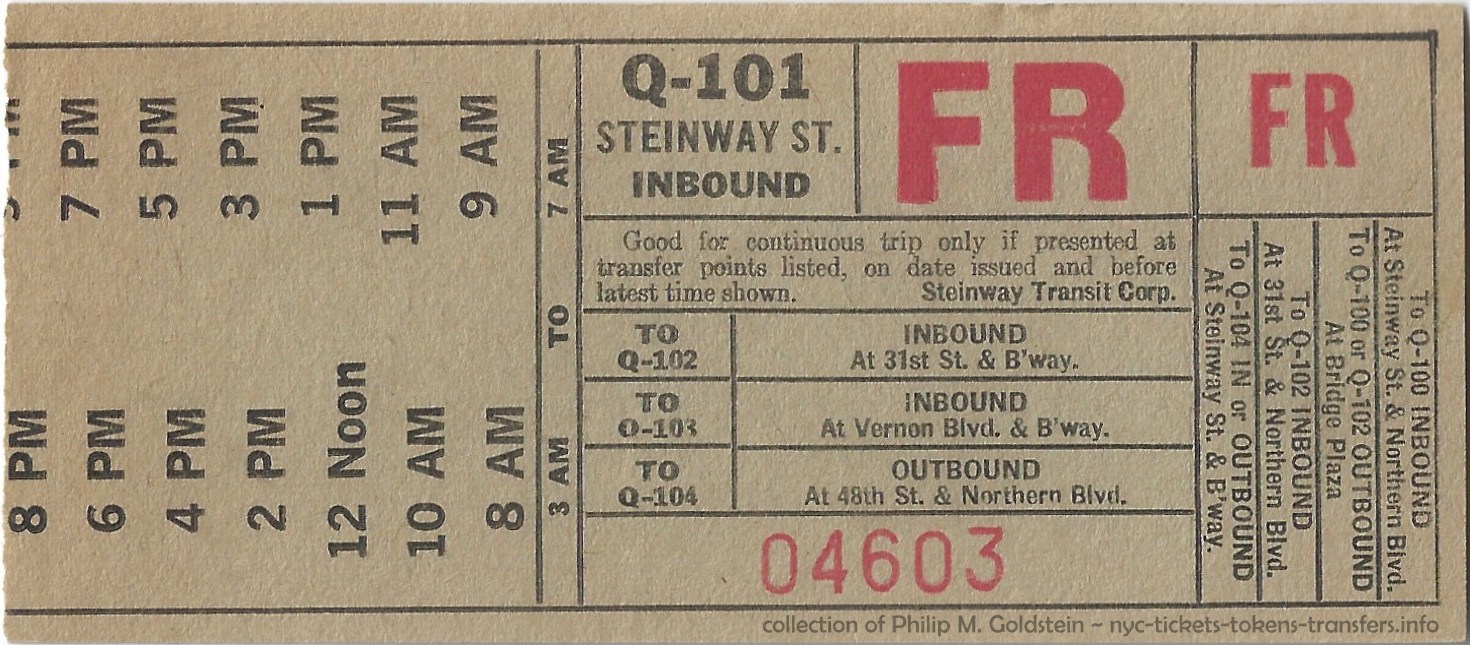 |
intentionally left blank |
| Q-101 Steinway Street - Inbound date code: FR |
|
| . | |
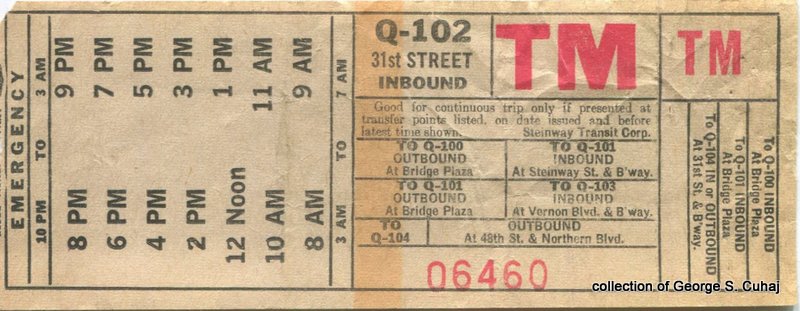 Q-102 31st Street - Inbound date code: TM |
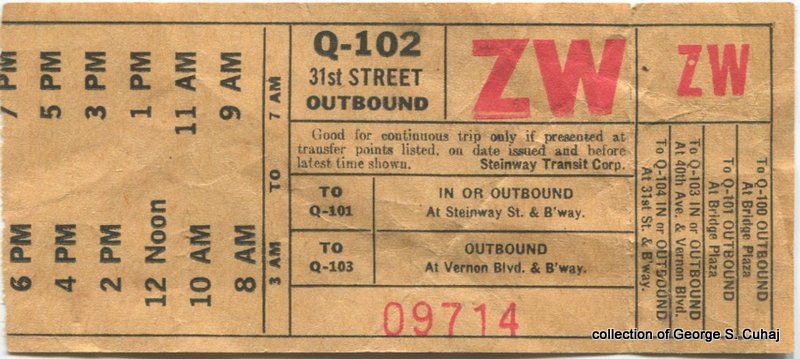 Q-102 31st Street - Outbound date code: ZW |
| . | |
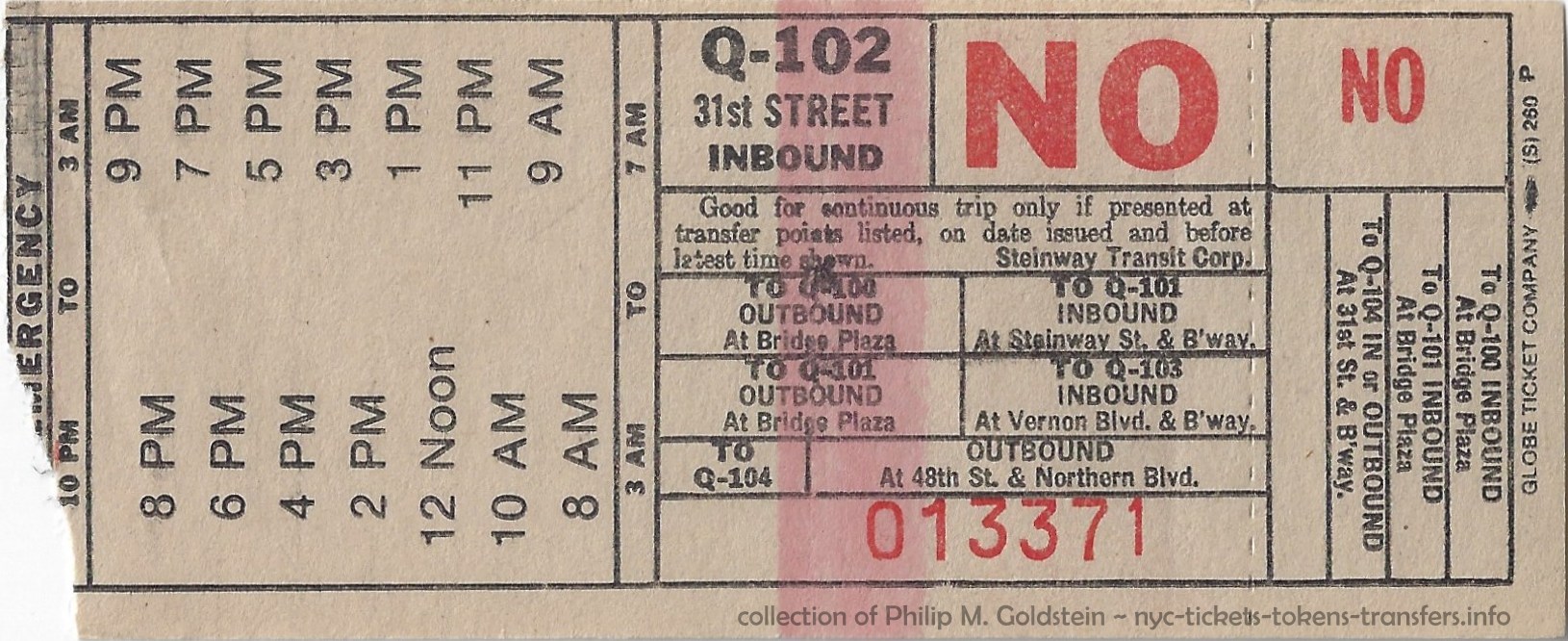 |
intentionally left blank |
| Q-102 31st Street - Inbound date code: NO |
|
| . | |
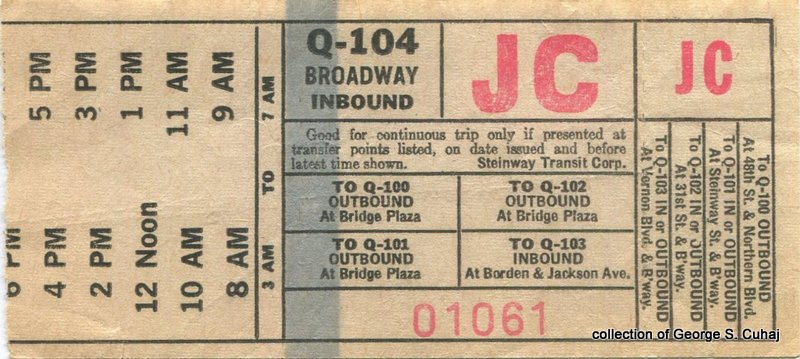 Q-104 Broadway - Inbound date code: JC |
Q-104 Broadway - Outbound
date code: YU |
| . | |
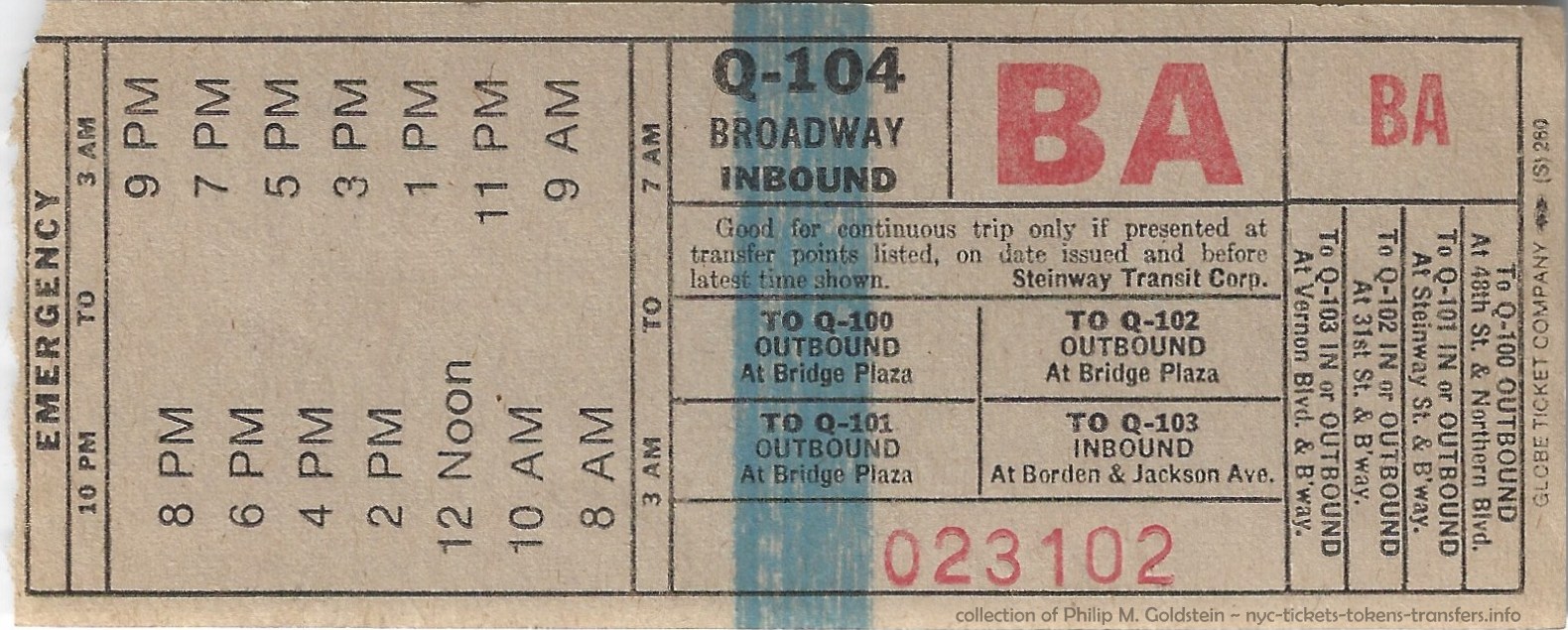 |
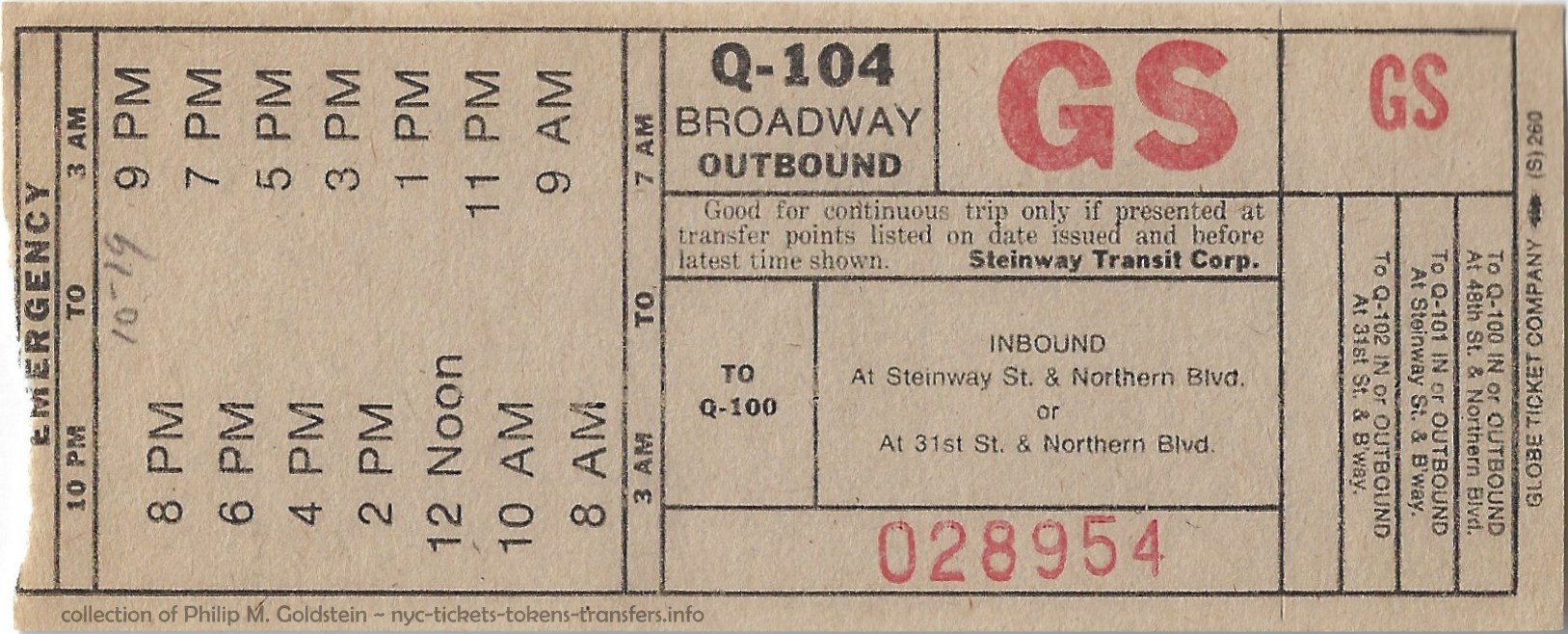 |
| Q-104 Broadway - Inbound date code: BA |
Q-104 Broadway - Outbound date code: GS |
| . | |
 |
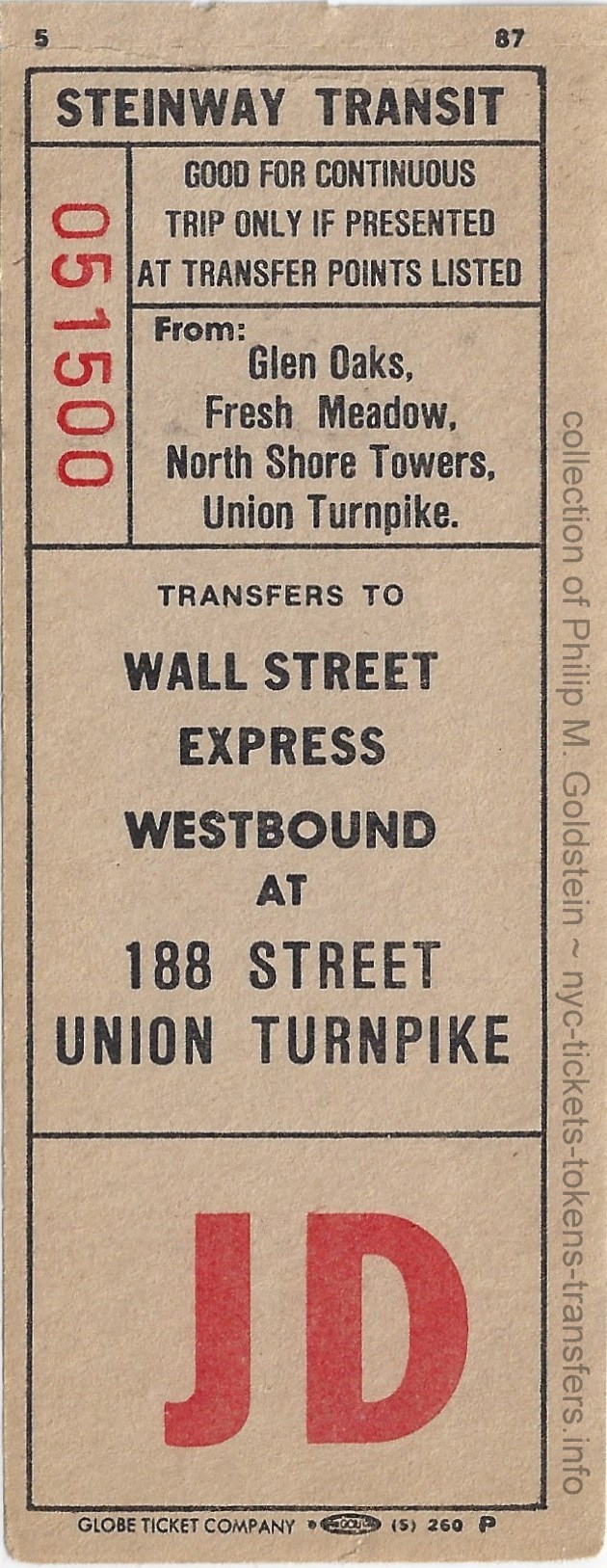 |
| ca. 1970's Wall Street Express transfers to Fresh Meadows, Glen Oaks, North Shore Towers, Union Turnpike to eastbound at Cheve Chast Street and Union Turnpike no date code: JD (plate code 5 87) Globe Ticket Co. |
May 1987 from Glen Oaks, Fresh Meadow, North Shore Towers Union Turnpike transfers to Wall Street Express - westbound at 188th Street Union Turnpike date code: JD (plate code 5 87) Globe Ticket Co. |
![]()
| Route List: | |||
| Route designation |
Terminals | via route | notes |
| Q18 | Astoria - Maspeth | 30th Avenue, 58th Street, Woodside Avenue, 65th Place, 69th Street | Formerly Steinway Transit Corporation Flushing Line; Q18 Astoria-Woodside and Q24 Woodside-Maspeth; combined into Q18 |
| Q19 | Astoria - Flushing | Astoria Boulevard | Salvatore Fornatora's original bus route from Corona into Flushing formed during April 1919 |
| Q19A | Long Island City - Jackson Heights | 21st Street, Ditmars Boulevard | Originally ran from Queens Plaza to the Astoria–Ditmars Boulevard El station Renumbered to Q69 in 2008 |
| Q19B | Jackson Heights - East Elmhurst | 35th Avenue, 35th Avenue, 89th/90th Streets, Astoria Boulevard | Renumbered to Q49 in 2008 |
| Q23 | East Elmhurst - Forest Hills | 108th Street | Acquired in 1936 from North Shore Bus Company. |
| Q29 | Jackson Heights - Glendale | 80th Street | Acquired in 1936 from Kings Coach Company |
| Q33 | Jackson Heights - LaGuardia Airport Central Terminal | 82nd/83rd Streets, 23rd Avenue, 94th Street | Acquired in 1936 from Municipal Motorbus Company via 82nd / 83rd Streets Since shortened due to new Q70 bus to LaGuardia airport |
| Q38 | Middle Village - Rego Park - or - Corona | Eliot and Penelope Avenues | Acquired in 1936 from Affiliated Bus Transit Corporation |
| Q39 | Long Island City - Ridgewood | Forest Avenue | Acquired in 1936 from National City Bus Lines |
| Q45 | Jackson Heights - Middle Village / Juniper Valley Park | 69th Street | Merged into an extended Q47 in 2011 |
| Q45X | Rego Park - or - Corona - Middle Village / 69th Street |
Eliot Avenue | Rego Park: Woodhaven & Queens Boulevards / Rego Center Corona: 98th Street and 60th Avenue Established in 1943 Q45X short for "Q45 Extension". This later became the first version of Q50; now part of Q38. |
| Q47 | Jackson Heights - LaGuardia Airport Marine Air Terminal |
69th Street and 80th Street | Now including former Q45 |
| Q53 | Woodside / LaGuardia Airport - Rockaway Park | Woodhaven Boulevard, Cross Bay Boulevard, Rockaway Beach Boulevard | Created as replacement for the partially abandoned Long Island Rail Road Rockaway Beach Branch in 1950. Was named the "Rockaway Park Express," despite the fact that technically, it was never a true express bus. |
| Q72 | Rego Park - LaGuardia Airport | Junction Boulevard | Originally the North Beach and Junction Boulevard trolley lines in 1894 Acquired in 1961 from New York City Transit Authority |
Queens-Manhattan Express Routes |
|||
| QM10 | Midtown Manhattan - Lefrak City | Manhattan: 3rd Ave branch: 34th St, 3rd Ave, 57th St 6th Ave branch: 34th St, 6th Ave, 57th St Queens: Queens Blvd, Linden Blvd, 63rd Road, 57th Ave |
LeFrak City Express Former 3rd Avenue service relabeled QM40 in early September 2016 |
| QM11 | Financial District / Wall Street - Lefrak City | Manhattan: Water St, Church St via 3rd Ave or 6th Ave Queens: Queens Blvd, 63rd Rd, 57th Ave |
Former downtown branch of the QM10 |
| QM12 | Midtown Manhattan - Forest Hills | Manhattan: 3rd Ave, 34th St, 6th Ave, 57th St Queens: Queens Blvd, Yellowstone Blvd |
Forest Hills Express Stops east of 71 Avenue in Forest Hills discontinued in January 2011 Third Avenue service was split off into QM42 in September 2016. |
| QM22 | Midtown Manhattan - Jackson Heights | Manhattan: 3rd Ave branch: 3rd Ave, 59th Stt 6th Ave branch: 34th St, 6th Ave, 57th St Queens: 21st St, 21st Ave, Ditmars Blvd |
Jackson Heights Express Discontinued in June 2010, due to budget crisis |
| QM24 | Midtown Manhattan - Glendale | Manhattan: 8th Ave or 3rd Ave Queens: Queens Blvd |
Glendale Express |
| QM24W | Financial District / Wall St - Glendale (Myrtle Ave and 73rd St) | Manhattan: 23rd St, Madison Ave, 57th St Queens: Queens Blvd |
Glendale - Wall Street Express Renumbered as QM25 in June 2010 |
| Q57 | Queensbridge at 21st Street and 41st Avenue to LaGuardia Airport | a/k/a "QT" for Quick Trip LaGuardia Express. 1990 to May 1991. Discontinued due to lower than expected ridership. The fare was $5, in addition to the $1.15 subway fare. The buses had luggage racks, air conditioning and padded seats.[20] | |
 Q-18 - no date detachable PM coupon day code: A American Printing Specialty |
|
| . | |
 Q-18 - October 3, 1961 detachable PM coupon day code: B American Printing Specialty |
|
| . | |
 Q-18 - October 10, 1961 detachable PM coupon day code: E American Printing Specialty |
|
| . | |
 Q-19A - no date detachable PM coupon day code: A American Printing Specialty |
|
| . | |
 |
|
| Q-19B - no date detachable PM coupon day code: K Globe Ticket |
|
| . | |
 Q-23 - no date detachable PM coupon day code: K American Printing Specialty |
|
| . | |
 Q-33 - no date detachable PM coupon day code: G American Printing Specialty |
|
| . | |
 Q-33 - no date detachable PM coupon day code: G American Printing Specialty |
|
| . | |
 Q-72 detachable PM coupon day code: E Globe Ticket |
|
Transfer issues from the independent bus operators and not as common as with NYCTA issues
$2.50 to $4.00 each with selvage.
Complete books are not widely seen for older pre-1980 issues, $20.00 per book
Complete books for newer issues widely seen; and prolific for 1980-2000 issues. No more than $7.50 to $10.00 per book.

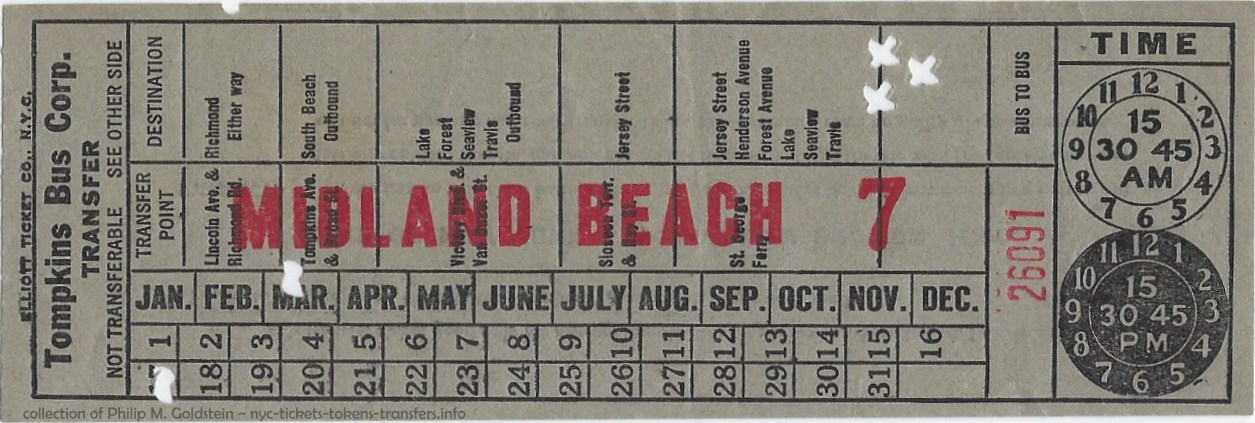 |
 |
| Midland Beach 7 - March 17, year? Elliott Ticket Co. 6" x 2" w/o selvage |
|
| . | |
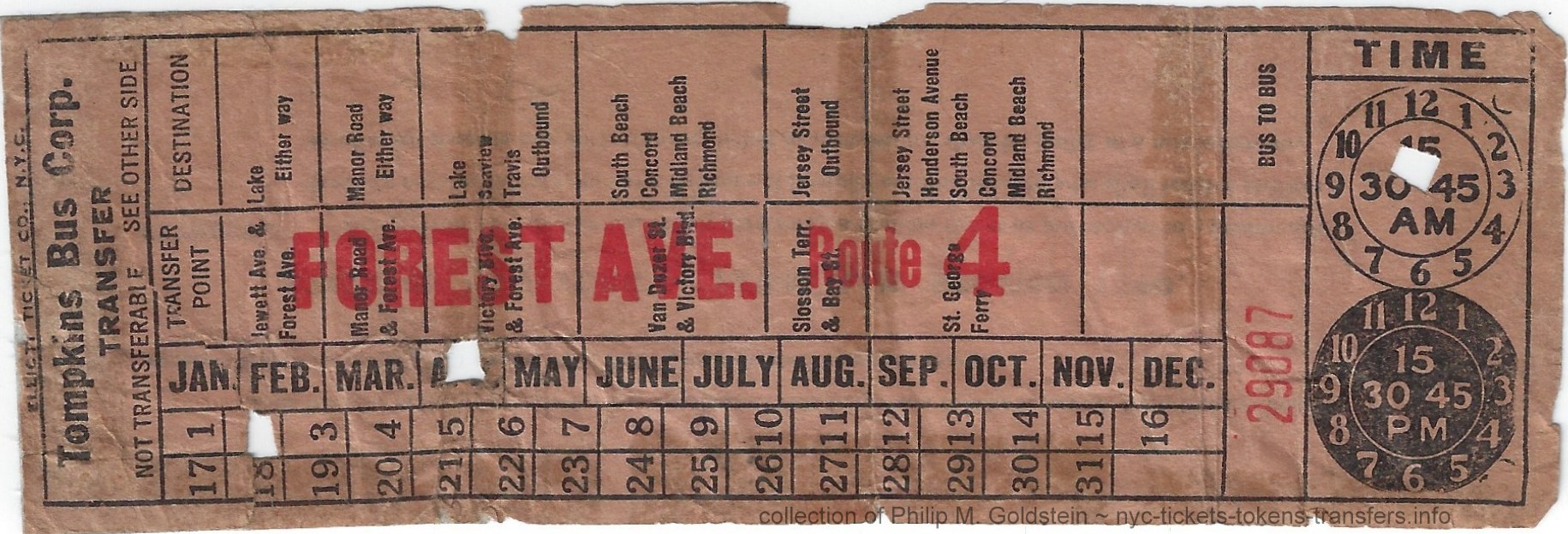 |
|
| Forest Avenue - Route 4 - , year? Elliott Ticket Co. 6" x 2" w/o selvage |
|
![]()
|
The Staten Island Coach Company was formed in 1925 as a
subsidiary of Richmond Light & Railroad Co. in which to operate buses, which
were then beginning to replace streetcars operated by the parent company in Staten
Island (the borough of Richmond in New York City).
However, it was only in 1933 that the authority to operate motor buses was actually granted by the City of New York; and by which time the Richmond Light & Railroad Co. had been reorganized, with its streetcar operations now renamed Richmond Railways. Throughout 1933 and 1934, Staten Island Coach Co. bus routes gradually began to replace the streetcars of Richmond Railways. At this point in time, two separate bus systems now operated in Staten Island, the other being Tompkins Bus Co. In 1937, the Staten Island Coach Co. took over the Tompkins Bus Co. routes; and those former Tompkins Bus Co. routes were given new route numbers, and being numbered in the hundreds; i.e.: R101, R102, etc In 1946, the Staten Island Coach Co. went bankrupt; and the Isle Transportation Company began operating the buses on Staten Island. This company was organized by a group of former Staten Island Coach Co. employees. Isle Transportation Co. itself did not last long, going bankrupt the next year in 1947, Upon this, the City of New York took over the bus operations on February 23 of that year. This was the first city-operated bus service (other than the Williamsburg Bridge line, which retained city operation under the Board of Transportation) after the end of the Department of Plant and Structures. |
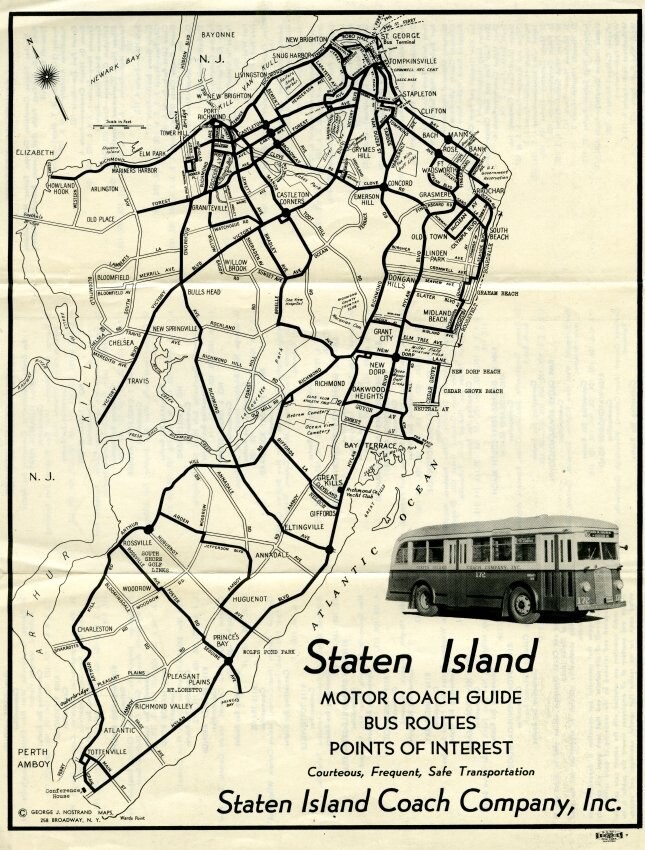 |
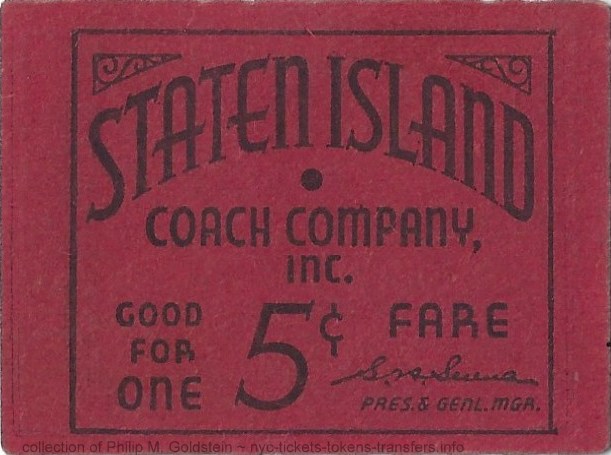 |
| 5 cent fare ticket Samuel H. Serena, president 1½" x 2" |
| . |
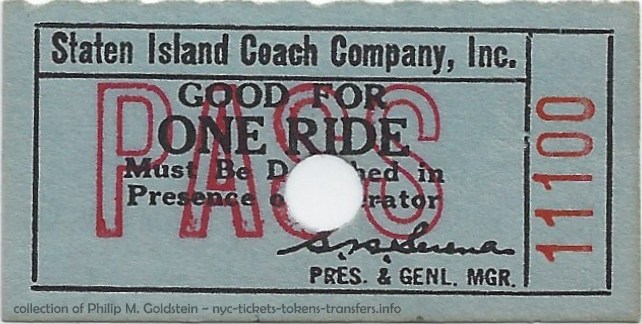 |
| Ticket, Good For One Ride (unknown purpose) Samuel H. Serena, president unknown printer 2" x 1" |
 |
| No. 1 - Elizabeth Ferry - ca. 1937 detachable PM coupon day code: NL Free Samuel H. Serena, president Globe Ticket Co. 6¼" x 2" w/o selvage |
| . |
  |
| No. 6 - Victory Boulevard - ca. 1943 detachable PM coupon day code: KR Free Samuel H. Serena, president Globe Ticket Co. 6¼" x 2" w/o selvage |
| . |
 |
| R103 - Tottenville - Northbound (IN) - ca. 1938 detachable PM coupon day code: AO Globe Ticket Co. 9¼" x 2" w/o selvage |
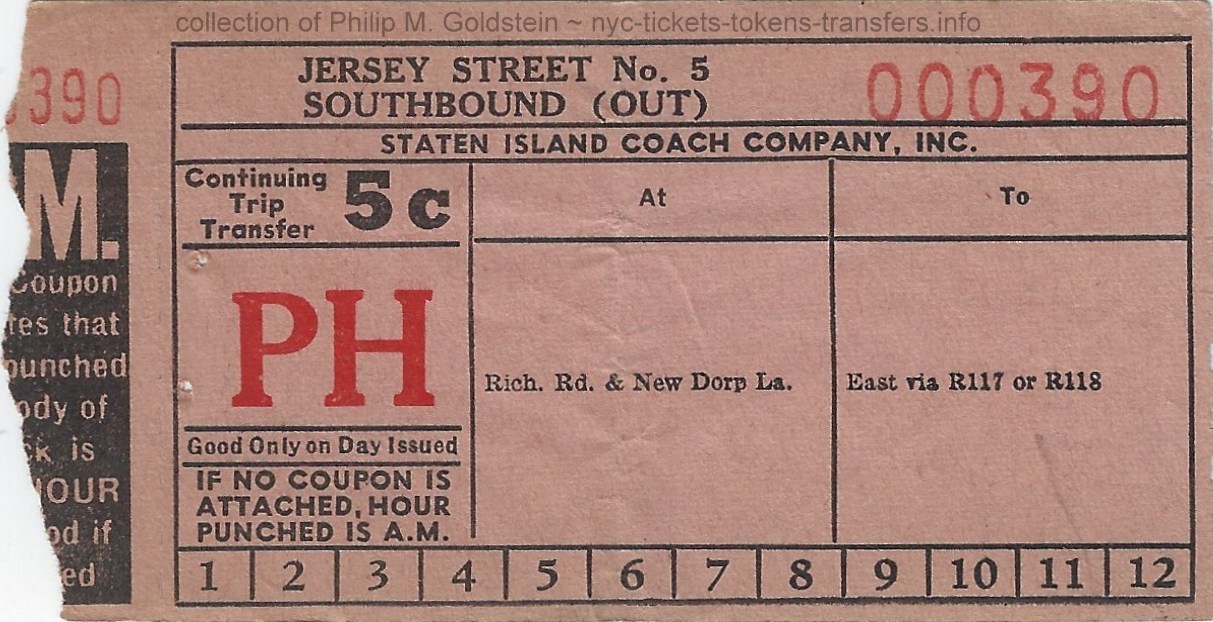 |
| R103 - Tottenville - Southbound (Out) - ca. 1938 detachable PM coupon day code: PH Globe Ticket Co. |
| . |
 |
 |
| R104 - South Beach - Tompkins Avenue - Northbound (IN) - ca. 1938 detachable PM coupon day code: AO (transfer points continued on back) Globe Ticket Co. 9¼" x 2" w/o selvage |
| . |
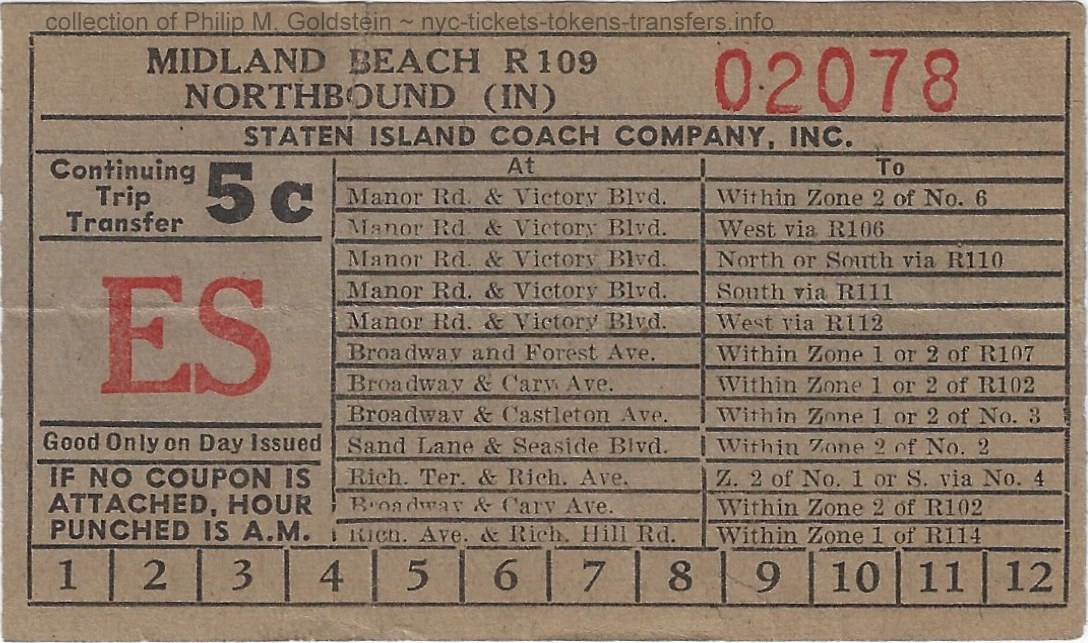 |
| R109 - Midland Beach - Northbound (IN) - unknown date (PM coupon detatched) day code: ES Continuing Trip Transfer - 5 cents Globe Ticket Co. 3½" x 2 1/16" w/o selvage |
| . |
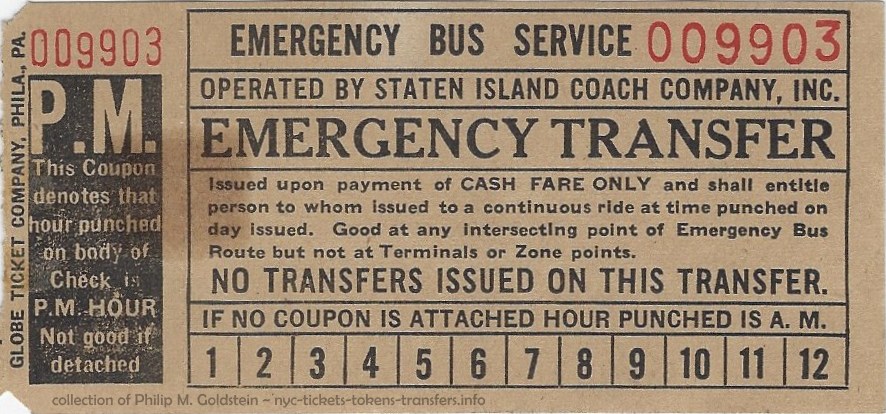 |
| Emergency Transfer - 1937 detachable PM coupon Globe Ticket Co. 4 5/16" x 2" w/o selvage |
 |
| Ticket, Good For One Ride (unknown purpose) - unknown date (pre-1946 bankruptcy) unknown printer 2" x 1" |
![]()
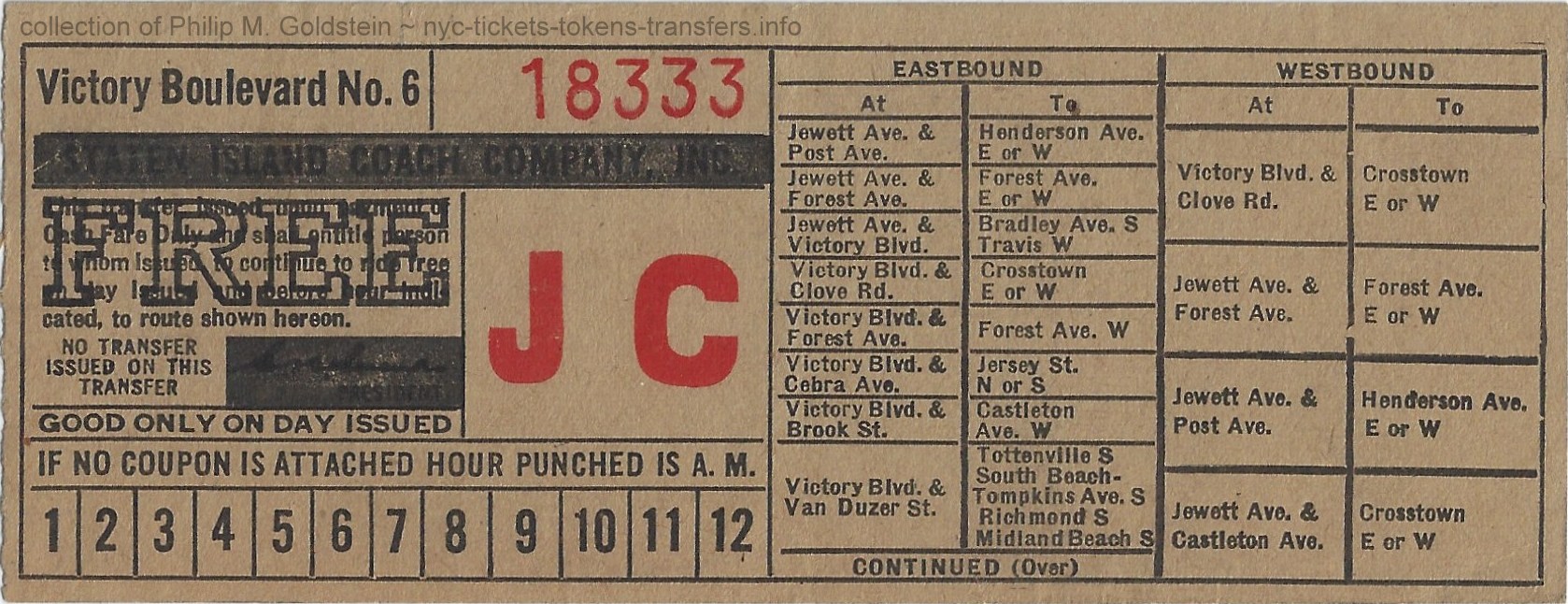 |
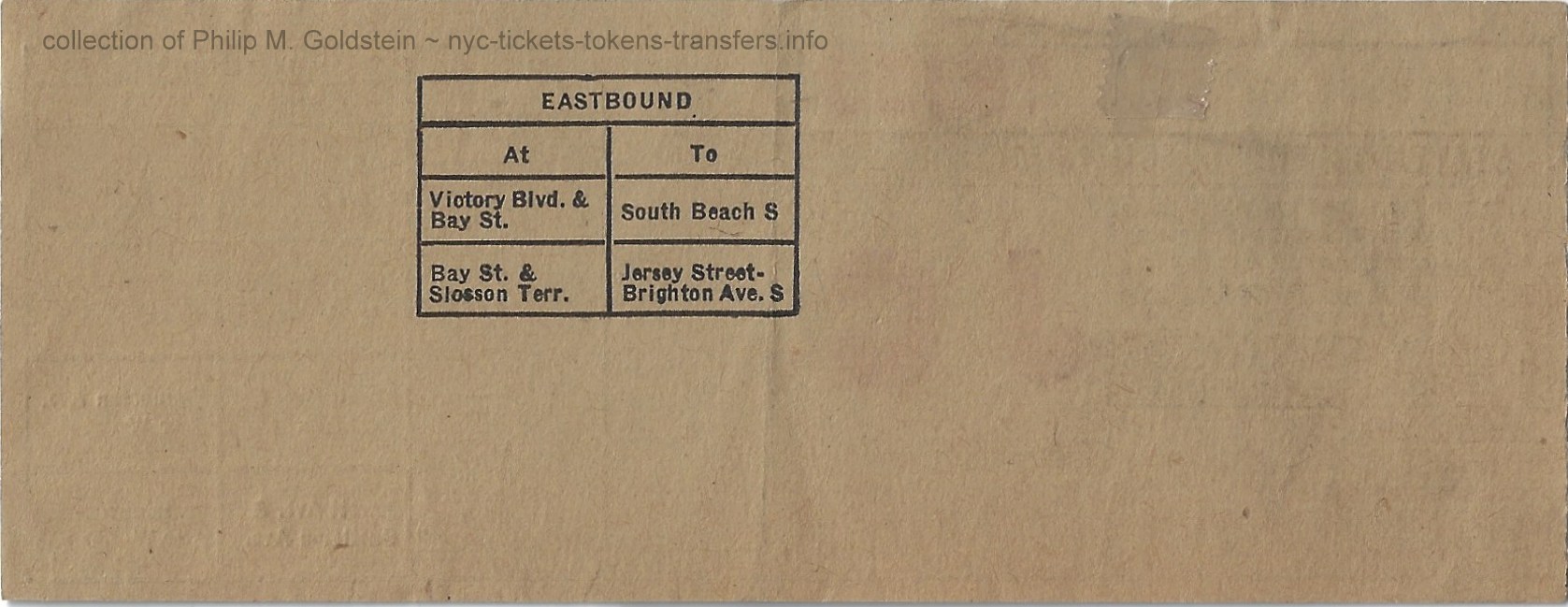 |
| No. 6 - Victory Boulevard - post 1946 day code: JC Free redacted: 4 7/16" x 2" w/o selvage |
| . |
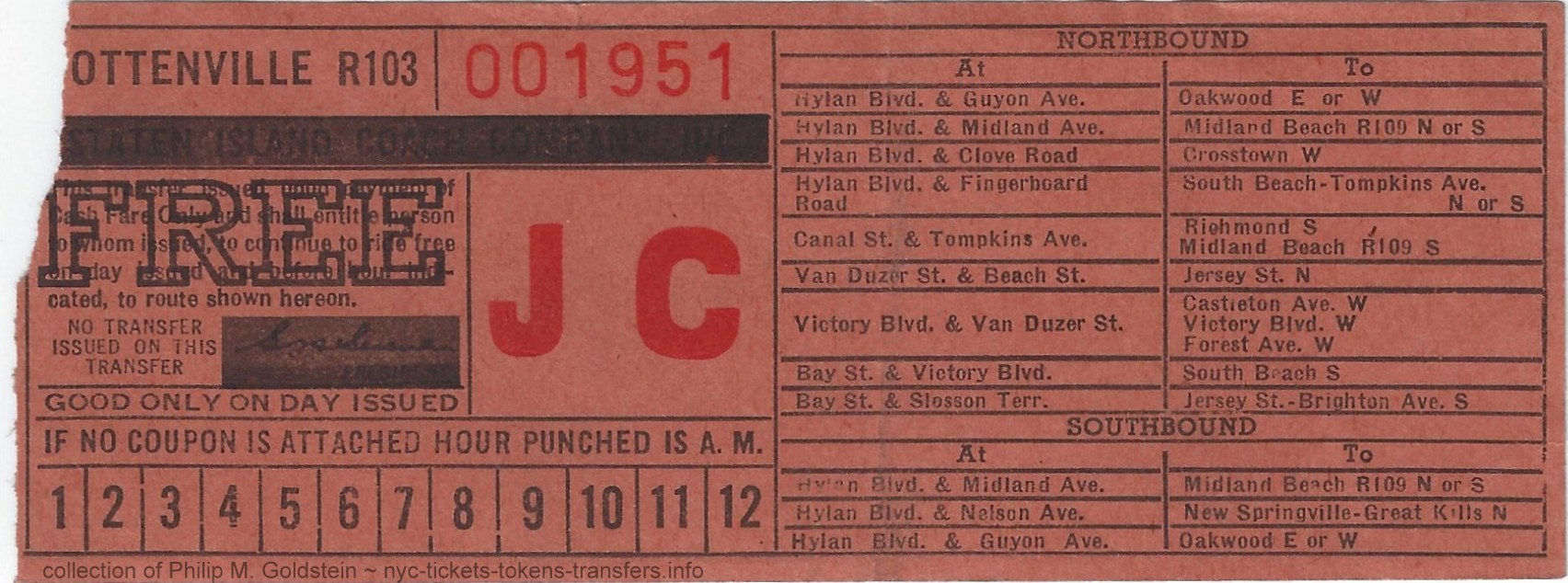 |
| Tottenville R103 - post 1946 day code: JC Free redacted: 4 7/16" x 2" w/o selvage |
Manhattan and Bronx Surface Transit Operating Authority "MaBSTOA"
Formed in 1962, as a subsidiary of the New York City Transit Authority, the Manhattan and Bronx Surface Transit Operating Authority was created to take over bus operations in the boroughs of Manhattan and the Bronx of the bankrupt Fifth Avenue Coach Company, and Surface Transit Corp.
Its creation as a subsidiary, allowed tenured employees to avoid being subject to civil service employment rules; however, some crafts of employees were afforded civil service protection; as well as a separate pension plan.
![]()
BX-55 Third Avenue Elevated ![]() Route "bustitution"
Route "bustitution"
to
NYCTA Subway: IRT Jerome Avenue Line ![]() and White Plains Road Line
and White Plains Road Line ![]()
![]() and IND Concourse Line
and IND Concourse Line ![]()
![]()
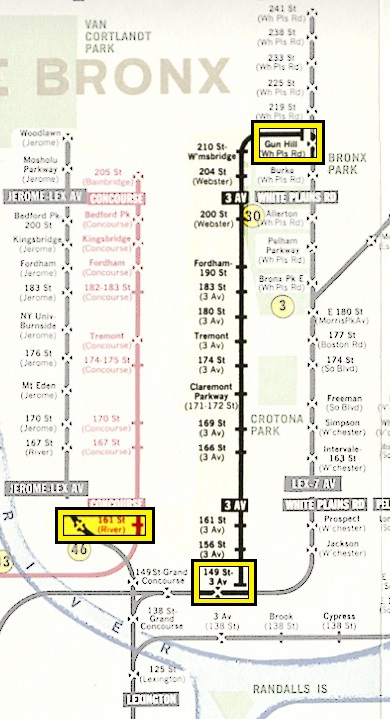 |
This Bx55X service allowed free transfers to intersecting subway lines and bus lines, thereby effectually making this issue a large format combination ticket. It was issued following the cessation of service on the Bronx portion of the Third Avenue elevated It is understood that the following issues were issued to bus passengers riding the BX55 bus which the former Third Avenue El service and were alighting at either:
149th
Street, 156th Street, 161th Street, 166th Street,
169th Street, Claremont Parkway, 174th Street,
Tremont Avenue / 177th Street, 180th Street, 183rd Street,
Fordham Road / 190th Street, Bronx Park Terminal,
200th Street, 204th Street, 210th Street / Williamsbridge
and Gun Hill Road.
As this bus route only stopped at limited locations and not every street corner as would a local bus, it constituted an express service and therefore carried the X suffix. This Bx55X service was one of the few routes in the city to allow free transfers to the subway prior to the introduction of the MetroCard in 1993, and one of the first routes to use the MetroCard (another being the B35 / Ninth Avenue Station in brooklyn). At some point in its operating history, the X suffix was dropped from the route number, becoming simply the Bx55. Southbound buses originally traveled via Washington Avenue and service between East 161st Street and 149th Street ran at Melrose Avenue in both directions until February 1984, when all service was shifted over to Third Avenue. Bx55 service was slowly reduced after the MetroCard's introduction with free transfers to other buses and the subway. All late night buses terminated at Fordham Plaza on September 10, 1995. Late night service (between 1 a.m. and 4:30 a.m.) was eliminated on September 8, 1996, and was merged with Bx15 service. Supplemental Bx15 service was provided between Fordham Road and 149th Street to maintain the Bx55's frequency. To maintain the transfer to the subway, bus-subway transfers were accepted on the Bx15 overnight. The change was made to eliminate duplicative service, which was lightly patronized. Select weekday and all weekend trips terminated at Fordham Plaza in February 2004, and all weekend and evening services were eliminated on June 27, 2010. All Bx55 service was discontinued on June 28, 2013. The rapid transit counterpart to these issues would be the IRT Third Avenue Elevated Bx55X continuation tickets on Page 3 of this website. |
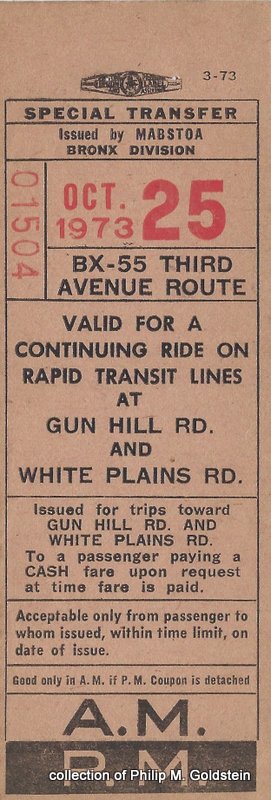 |
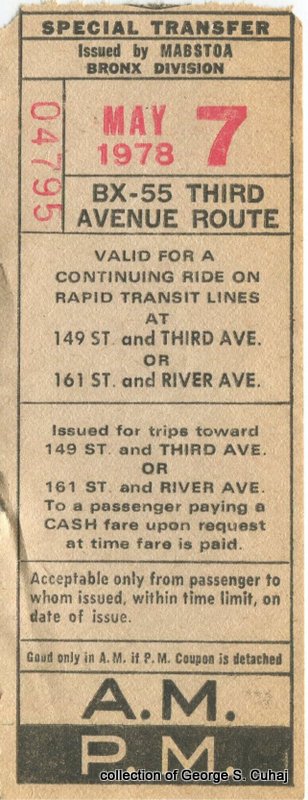 |
| 3-73 Northbound: Valid for a Continuing Ride on Rapid Transit Lines at Gun Hill Rd. and White Plains Rd. (former northern terminus of Third Avenue El) |
May 7, 1978 Southbound: Valid for a Continuing Ride on Rapid Transit Lines at 149 St, and Third Ave. (former southern terminus of Third Avenue El) or 161 St. and River Ave. (Yankee Stadium) |
..Special
Transfers for continued trip from bus routes to rapid transit stations
are much less common than that of the general issues for bus routes
transfers in the previous chapter.
As such, these tickets can be priced at $3.00 - $4.00 each, with selvage.
 |
 |
| COL22-0 (orange) Bx22 |
COL22-B (blue) Bx22 |
 |
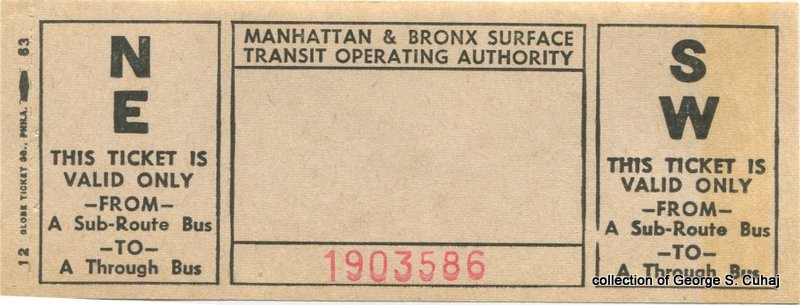 |
| M1, M2A, M7, M10 (January 1972) Valid from Sub-Route to Through Bus 5 9/16" x 2" |
North / East, South / West (December 1983) Valid from Sub-Route to Through Bus 5 1/2" x 2 1/16" |
| M101 & M104 |
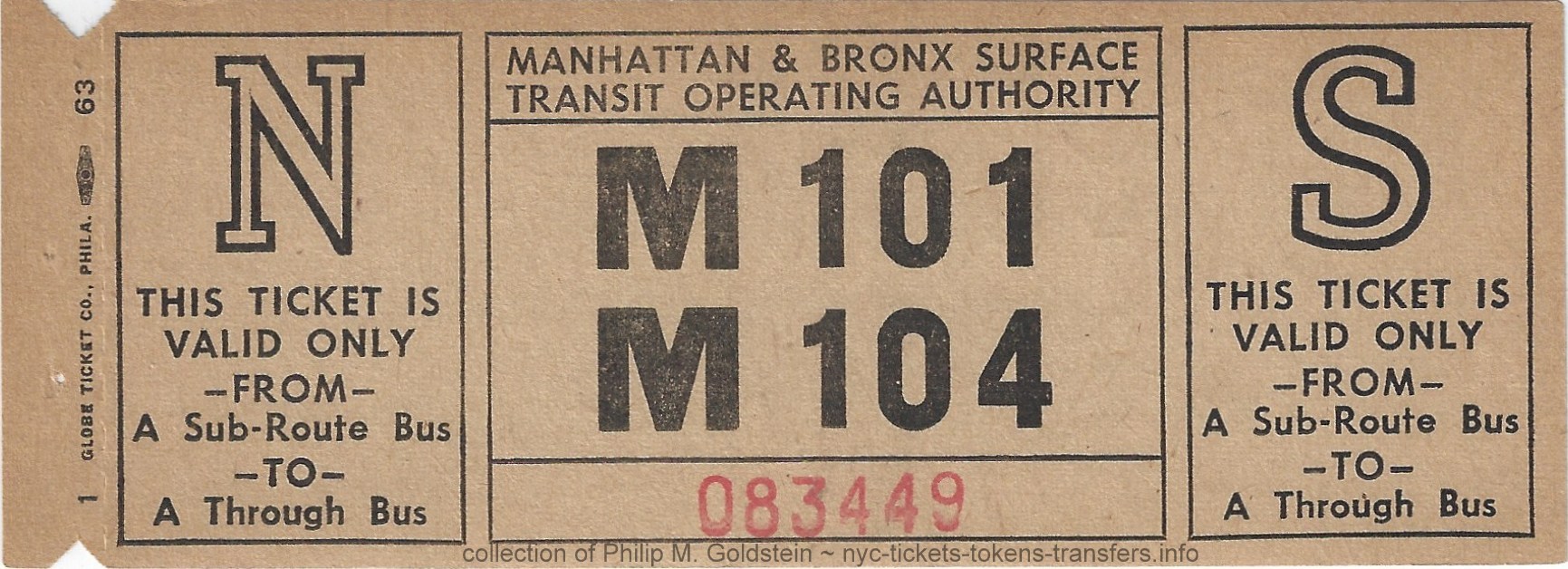 |
| North & South (buff) - 1963- From Sub-route Bus to Through Bus Surface Transportation Corp of NY (receivership, Lester T. Doyle trustee) Globe Ticket |
| M103 & M106 |
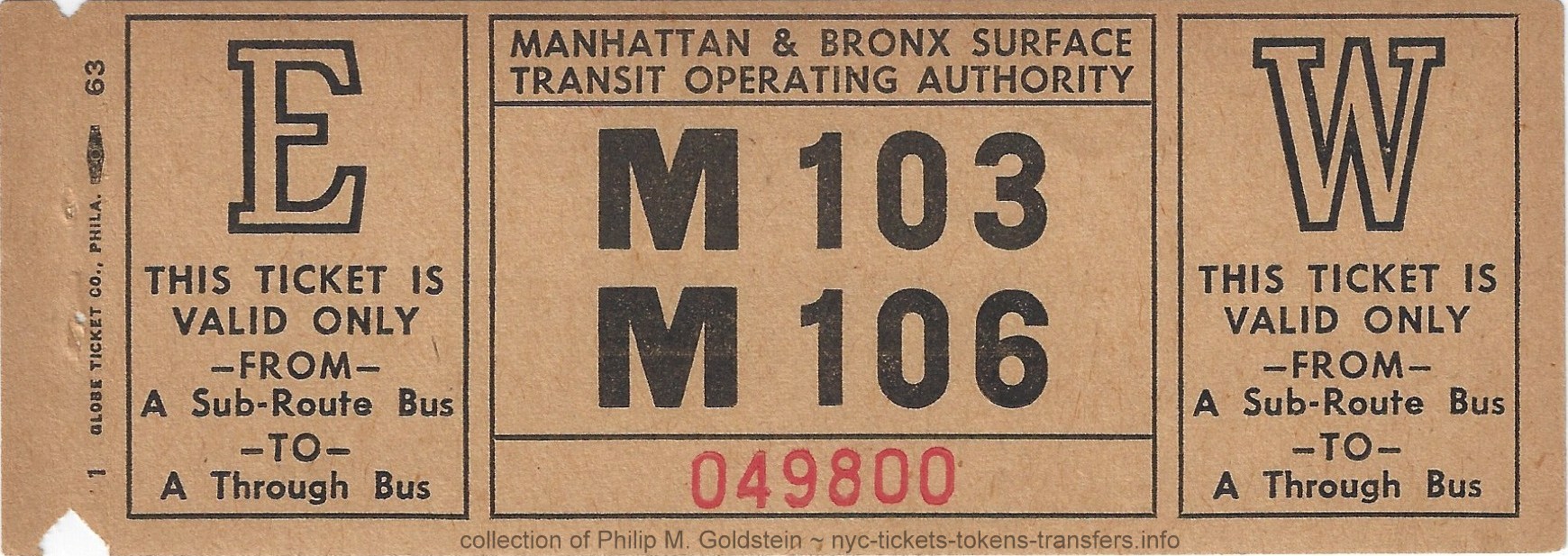 |
| East & West (buff) - 1963- From Sub-route Bus to Through Bus Surface Transportation Corp of NY (receivership, Lester T. Doyle trustee) Globe Ticket |
![]()
Manhattan: NYCTA Manhattan Bus Division
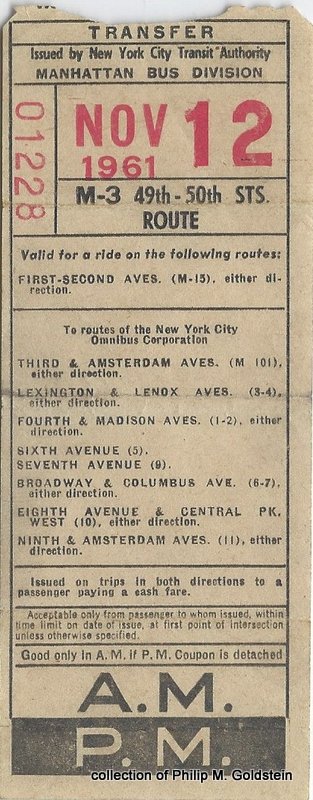 |
| M-3 (buff) Nov 12, 1961 M-3 49th - 50th Sts. Route (to routes of New York City Omnibus Corp listed) |
.
| NYCTA Manhattan Bus Division set (believed to be incomplete) |
|||||
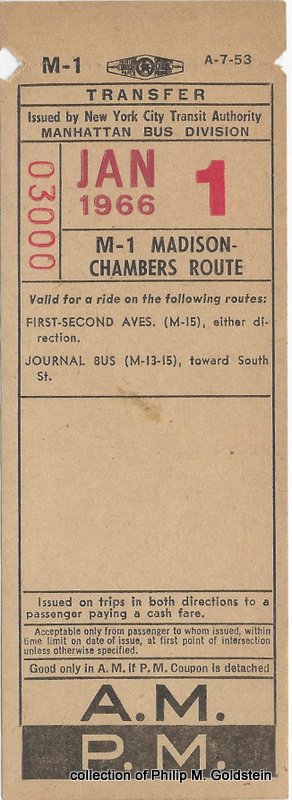 |
 |
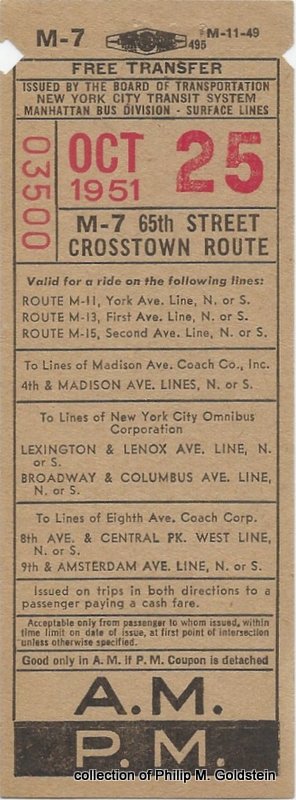 |
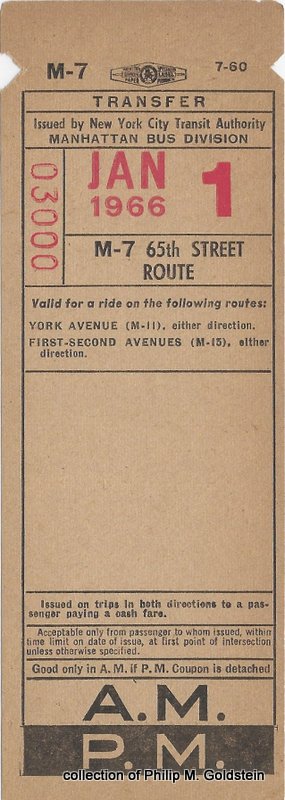 |
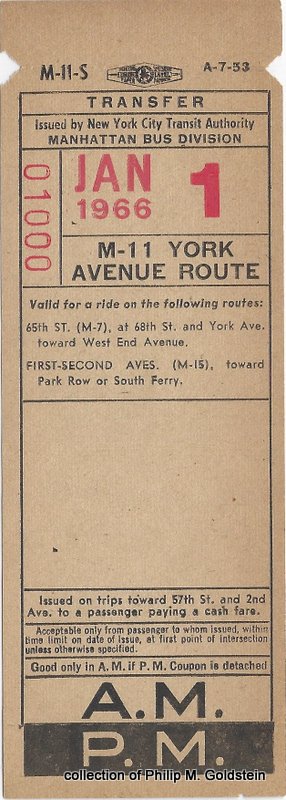 |
 |
| M-1 (buff) M-1 Madison - Chambers Route NYCTA |
M-3 (buff) M-3 49th - 50th Sts. Route NYCTA |
M-7 (buff) M-7 65th Street Crosstown Route BOT-NYCTS |
M-7 (buff) M-7 65th Street Route NYCTA |
M-11-S (buff) M-11 York Avenue Route NYCTA |
M-11-N (orange) M-11 York Avenue Route NYCTA |
| . | |||||
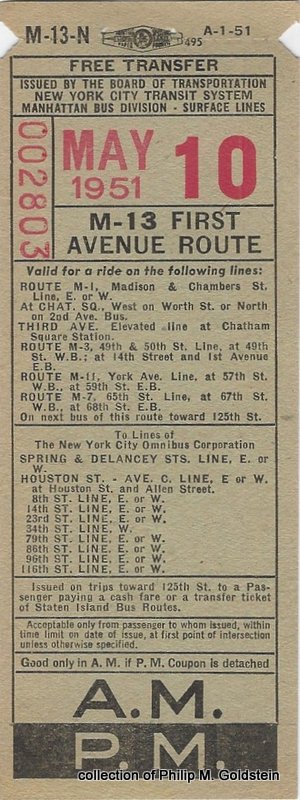 |
intentionally left blank | 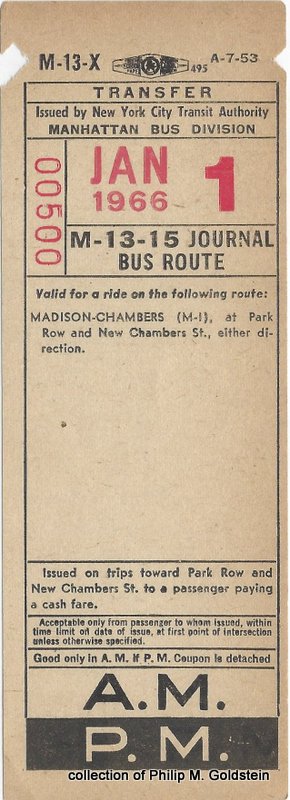 |
intentionally left blank | 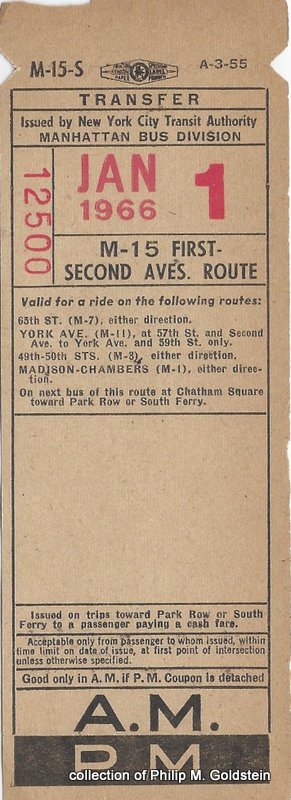 |
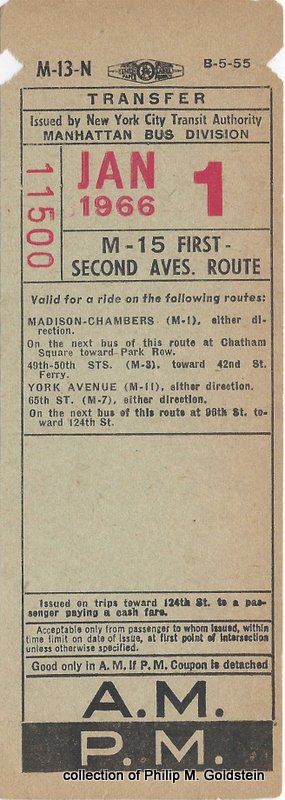 |
| M-13-N (green) M-13 First Ave. Route BOT-NYCTS |
M-13-X (buff) M-13-15 Journal Bus Route NYCTA |
M-15-S (buff) M-15 First-Second Aves. Route NYCTA |
M-13-N (green) M-15 First-Second Aves. Route NYCTA |
||
Transfers
of this style for the routes in Manhattan are not as common as
Brooklyn. This may be due in part to the control of most northern
routes by MaBSTOA. $2.00.50 to $2.50 with selvage.
Again, complete books known and not worth the sum of 25 transfers.
$15.00 - $17.50 per book is fair for issues date 1950-1970; and $8.0 to
$10.00 per book for dates 1970-1982.
![]()
Manhattan: New York City Transit Authority
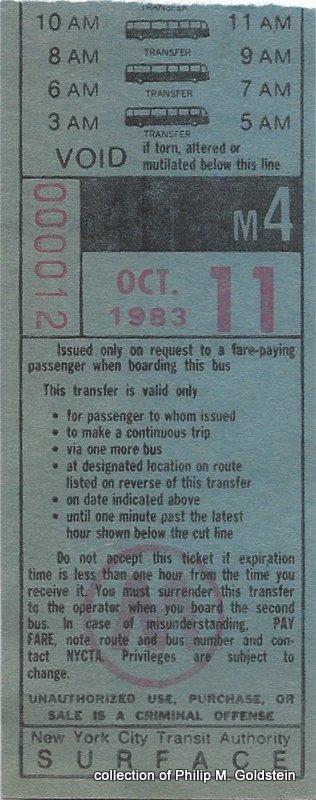 |
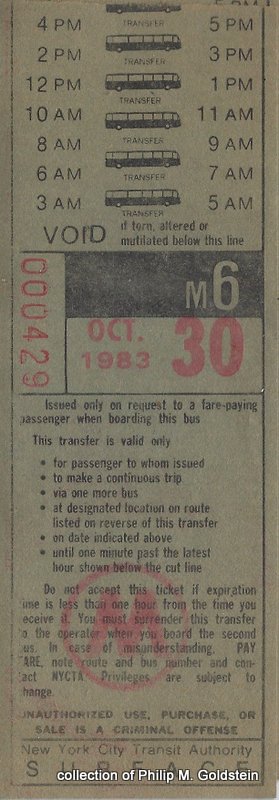 |
 |
| (blue) Oct 11, 1983 M4 |
(blue) Oct 30, 1983 M6 |
May 12, 1988 M42 |
![]()
 |
| M96 / M106 |
All
boroughs extremely common in unbroken books. No more than $10.00 -
$15.00 PER complete book. Individual transfers of this type no
more than $1.00 each with selvage;
However a substantial premium should be considered for the last day of issue of paper transfers for that route.
 |
intentionally left blank |  |
 |
| Routes 1-43 - Outbound | Routes 12-44 - Outbound | Routes 12-44 - Inbound |
![]()
.$1.25
to $1.50 with selvage. Again, complete books are plentiful; and not
worth the sum of 25 transfers. $12.00 - $15.00 per book is fair for
issues date 1950-1970; and $7.50 to $10.00 per book for dates 1970-1982.
Identification Checks are more uncommon, $2.50-$4.00 with selvage.
.
![]()
Queens: New York City Transit Authority - Queens Bus Division
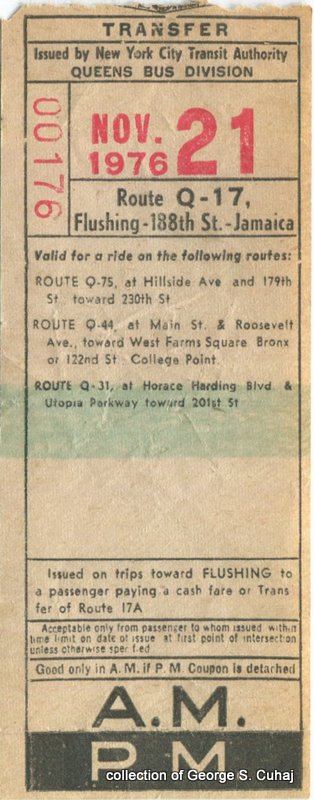
(blue stripe) Nov 21, 1976
Route Q-17
Flushing-188th St. - Jamaica
![]()
Queens: MTA - New York City Transit Authority
 |
| Q44 extra long form: 9 1/8" x 2" |
![]()
Queens: Interdivisional Continuation Ticket - "Continued Ride"
Q49 (bus)
to
BMT Jamaica Line ![]() - Queens Boulevard Station
- Queens Boulevard Station
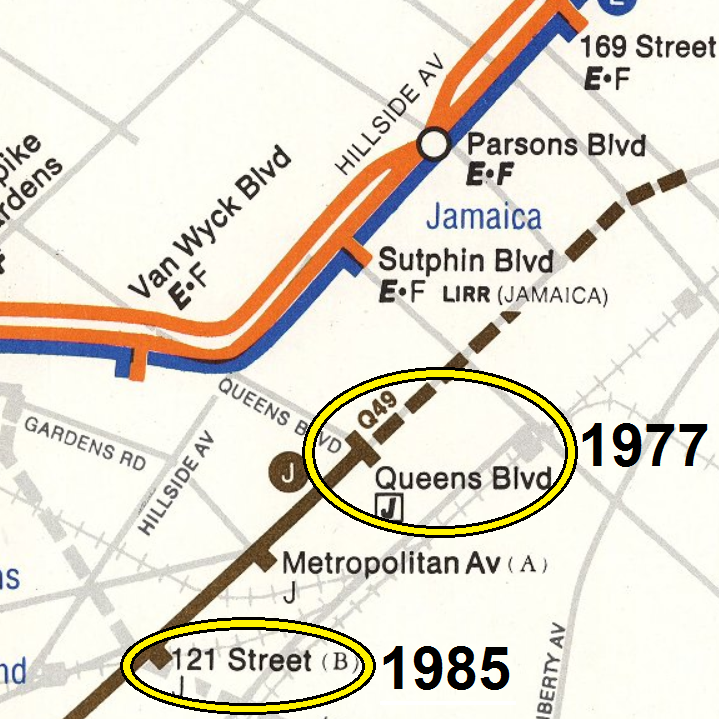 |
In September 1977, the three stations: Sutphin Boulevard, 160th Street and 168th Street, which were east of the Queens Boulevard station on the BMT Jamaica Line The Q49 bus route was created as a bustitution shuttle to provide service along the now closed portion of the route. On April 15, 1985, the Queens Boulevard station along with the Metropolitan Avenue station were closed as well, when the line was further cut back to 121st Street; and the Q49 bus route was extended to this new terminal. The Q49 bus itself was discontinued when the rest of the Jamaica Line was connected to the Archer Avenue Subway Extension in 1988. |

Q49 continuation ticket to Queens Boulevard Station - 1977 - 1985
Globe Ticket
5 9/16" x 2 1/8" w/ 1/2" selvage
uncommon; $5.00 - $7.50 without selvage / 7.50 - $10.00 with selvage.
.
![]()

![]()
Staten Island: New York City Transit Authority - Staten Island Bus Division
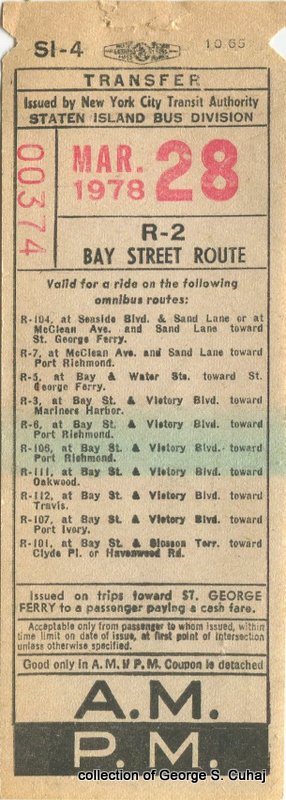
SI-4 (blue stripe) 10-65
R-2 Bay Street Route
Staten Island: MTA New York City Transit
 |
 |
| CAS 7-B S53 |
|
On July 4, 1986; in commemoration of and in accordance to the nationwide celebration of the 100th Anniversary of the Statue of Liberty; the New York City Transit Authority issued a three day special citywide transfer issue. Specific routes were not listed as on regular issues of surface transfers, and the M insignia of the Metropolitan Transit Authority (the parent agent to the New York City Transit Authority) was replaced with the single color (red) artwork of the Statue of Liberty. Backs were unprinted.
They are seen in four colors: pink, white, yellow and blue, and are also seen dated for July 5th and 6th.
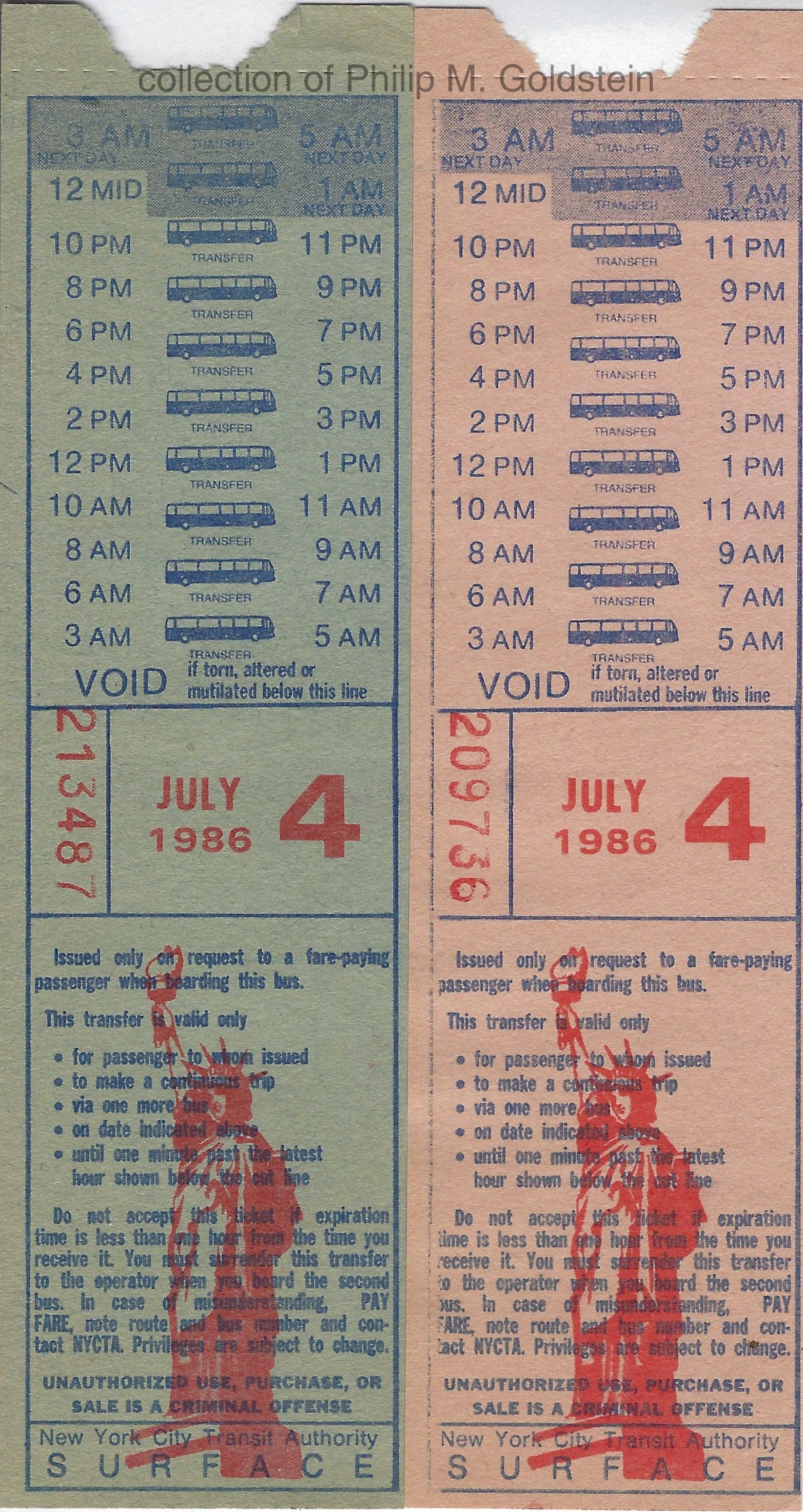  |
|
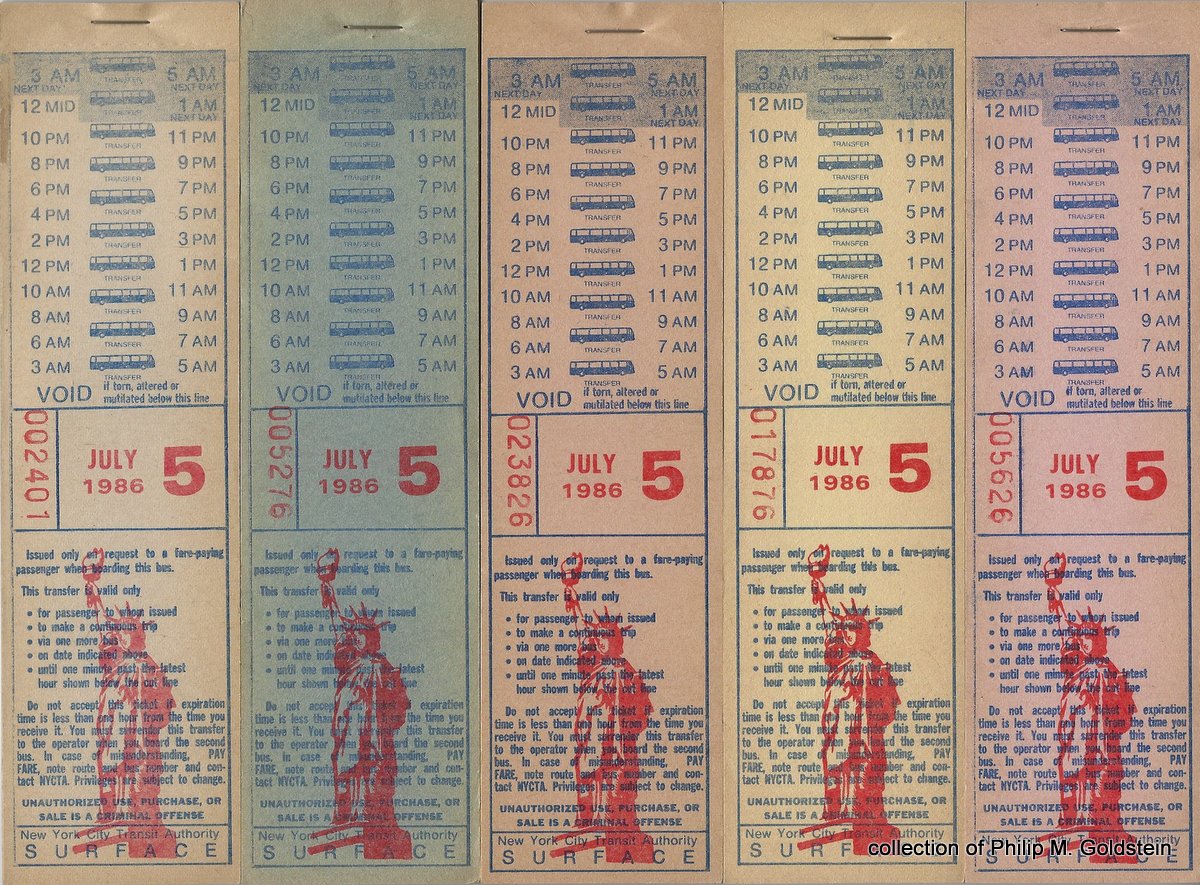  |
|
| 7½" length (7" long ticket and ½" selvage) by 2" width pulp paper, dyed orange or blue; printed front only. Individual transfers regularly seen and complete books for sale. Theoretically, these should be even more prolific as all the bus routes in New York City were issued these books for July 4 holiday as opposed those specifically marked for individual routes. No more than $12.50 - $15.00 PER complete book. Individual transfers of this type no more than $1.00 each with selvage. |
|
|
The NYCTA operates Express Bus routes throughout the five
boroughs with most termini being in Manhattan in the morning and outer
boroughs in the evening. The
original incarnation of this express service is reported to have began
in 1968 with a Queens to Manhattan express service and these routes
were originally suffixed with the letter letter "X", i.e.: Q20X In 1976, the NYCTA began adapting their bus nomenclature so the X would be a prefix letter: X20. This express service proved to be popular, and was slowly expanded throughout the years and boroughs, as demand increased in several neighborhoods. This provided a bus service with limited stops (instead of stopping as flagged at practically every or every other street corner as with regular surface routes) and in neighborhoods that may not have had a rapid transit system nearby. Most often, the passenger would plan their schedule to arrive at the express bus stop the same time every day, and be greeted by the same bus operator. These Express Bus Routes proved very popular with executives as well as middle management, and whose salaries could afford this premium service. It also offered a respite for those who took their own automobile to work; as by the time you calculated the cost of gas, tolls and wear and tear on your vehicle; the cost of Express Bus was on par. And, someone else was doing the driving! Furthermore, with the adaptation of bus only lanes at select river crossings; trip time on the Express Bus was usually less than if one drove their own vehicle. The Express Bus fleet is appointed with more spacious and cushioned seating in comparison to the regular fleet of buses. They were also easier to maintain to a higher degree of cleanliness on the interior as opposed to the regular fleet as well; primarily due to the higher standards of the passengers using them. Business types were nowhere near as slovenly or inconsiderate as slobs, school kids, and riff raff! As of August 19, 2018; Express Bus routes from Staten Island / Manhattan have ceased using the X prefix, and now carry the borough letters of the service: SIM - Staten Island to Manhattan. This new nomenclature is slowly being adopted for the other express bus routes as well: BM - Brooklyn / Manhattan; QM - Queens / Manhattan and BxM - Bronx / Manhattan. Sidetrack down memory lane:
My mother, when offered the position of executive
secretary, getting promoted from staff secretary; calculated the annual
cost of this premium service, and included it in her requested salary.I distinctly recall on one really miserable winter day in 1984, I had been waiting for over 40 minutes for the regular northbound B68 Coney Island Avenue bus to go to school. My mother, who arrived at the bus stop after I, to find me waiting; caught her regular express bus, the X29. After a quick mother/son kiss, she got on board and I watched her say something to the operator, who then looked down at me and said, "hop on!" To a regular bus passenger used to the "normal" hard plastic mass transit seats, a perpetual funky humid / body odor / vinyl flooring smell, and the regular group of rowdy school kids in the back, graffiti, scratched windows and light rubbish on the floor; I was in awe. Wide cushioned seats, pleasant smell, clean and everyone in casual or business attire and properly behaved! It was like being transported into another dimension. Not 10 minutes later, I got off at my stop at Avenue M, and that was that. Back to the rat race and common folk! PMG |
| NYCTA Express Bus Fares Note: some early express buses routes, particularly those from Great Kills, Staten Island to Brooklyn or destinations in Manhattan varied Wall St or Midtown. |
||
| fare | from | notes |
| $1.00 | April 12, 1971 | first route from 91st St / York Ave to Wall St |
| $1.00 | August 1, 1971 | Queens to Midtown, Manhattan Express bus service began |
| 50¢ 85¢
$1.00 |
January 4, 1972 | R8/X bus route (Staten Island-Brooklyn Express) R9/X bus route (Staten Island-Brooklyn-Wall St. Manhattan Express) R9/X bus route (Staten Island-Brooklyn-Midtown Manhattan Express) |
| $1.50 | September 1, 1975 | |
| $2.00 | June 28, 1980 | |
| $2.50 | September 1981 | |
| $3.00 | January 2, 1984 | |
| $3.50 | January 1, 1986 | Only the Manhattan East Side Express Bus went to $4.00. All others stayed at $3.00 |
| $4.00 | January 1, 1990 | |
| $3.00 | March 1, 1998 | |
| $4.00 | May 4, 2003 | |
| $5.00 | February 27, 2005 | |
| $5.50 | December 30, 2010 | |
| $6.00 | March 3, 2013 | |
| $6.50 | March 22, 2015 | |
| $6.75 | April 21, 2019 | present (MetroCard or OMNY only, coin payment discontinued) |
| $7.00 | August 20, 2023 | |
Express: New York City Transit Authority
 |
 |
..... |  |
 |
| YUK-X-1-Y (yellow) 3-83P X17 - X19 |
YUK-X-1-V (pink) 3-83P X17 - X19 |
|||
Express Bus transfers are seldom encountered. $3.00 - $4.00 each with selvage. Unbroken books not encountered frequently and should command at least sum of individual transfers.
![]()
Express: MTA - New York City Transit
 |
 |
 |
 |
 |
 |
| X8 |
X27 UP 12-Y |
X28 |
|||
Obviously, each bus route was issued several books of transfers, daily. Depending on the established traffic for that particular route, it could be as little as two books for a 12 hour shift) for a shuttle line, or several books for heavily traveled through routes. Most transfer ticket books were printed with 50 tickets in a book; however 25 ticket books are seen and depending on the route.
These books of transfers were issued each day of the calender year: that is 365 days if you do not know how many days are in a year. Multiply this number, by the usual standard of two colors of issue: one color for each direction for a single route. You are now talking a minimum of 730 tickets of each date PER route PER year.
Now, multiply that number by the total number of routes in the Five Boroughs. About an average of 75 to 80 routes per borough would be a fair estimate. That comes to 58,400 transfers.
Factor in additional special transfers in multiple colors, and the total number of possible transfer grows exponentially.
Some routes did not exist at certain periods - so a particular route may not be available in one year, but was a few years later, while another was abolished.
An attempt to make a "set" from issued tickets, is statistically (and financially) a very difficult thing to accomplish, unless you are fortunate enough to locate a control set. A control set was used by depots and by accounting department to check the validity of a questionable transfer. Believe me, while not common, attempts at counterfeiting transfers were not unheard of.
These control sets were usually issued on the first of the year. A control set would have an example from all five boroughs from the same day.. This is something even the most earnest collectors could not achieve as it would require visiting every single depot within the five boroughs in a very small specific time frame to acquire a complete range of routes for that single day.
But except for a control set, it also explains why there are so many whole books available for sale. After their printed issue date, they were no longer good, and so were discarded, even if unused. If 100 books were printed for a particular route for a particular day, at 25 transfers per book = 2500 transfers total. But if only 500 transfers were issued in one direction for the entire day, then there would be 80 books to dispose of. That leaves 2000 unused transfers, still in books, unused. And usually, they went into a paper recycling dumpster behind the bus depot.
Which is why surface transfers are plentiful and available in so many varieties and issue dates. And which is why they should be extremely cheap.
So; how much should you pay?
Some collectors and / or dealers acquired vast quantities of transfer books in the manner of dumpster diving; while others that were employed by the NYCTA and now retired; saved and accumulated them before they hit the dumpster. Totes and milk crate-fuls of transfer books. Of which, these thousands and thousands of books are still being sold and dispersed 30 years later.
When I first started collecting surface transfers around 2000, I was able to purchase individual transfers for around 25 to 40 cents a piece, and 2 to 3 dollars for a complete book. Every day of the week and twice on Sunday. As part of my OCD, I recorded the price and serial number of every transfer acquired, whether individually or in a group.
Now, within the last few years there has been a dramatic rise in pricing on eBay in regards to these transfers. Sellers are asking $3.99, $5.99, even $9.99 each, and even higher! For 1990's bus transfers! Books? $25 and higher. This pricing greatly exceeds the rate of inflation. And there is no shortage of them, so it's not about supply and demand. A transfer that I would have purchased in 2000 for 40 cents, would now sell at 63 cents, adjusted for the rate of inflation. A $1.00 transfer? would be $1.56. So why are sellers asking the prices they are? Are they worth this?
Absolutely NOT. Do not be fooled into even thinking this for a single moment!
If one merely takes the time, look through the amount of auctions relating to NYCTA bus transfers (they only list the previous 90 days), and you will see the same thing I do. There are hundreds if not thousands of them out there, so they are obviously not rare. And frankly, there is not much demand, as it is a very specialized area. So why the jump in prices?
In one and a legitimate aspect, eBay fees. EBay has made it unprofitable and inconvenient to sell nickel and dime stuff cheaply. What used to be an online marketplace / garage sale / flea market, is now a boutique shop with antique store prices. In another, shipping. eBay has made it difficult to negotiate on shipping. They suggest a particular service and offer it to the seller as part of the sales package. Most of the time it is a standard flat rate first class mail with tracking number.
A first class stamp costs 55 cents at the time of this writing.
Now it's 66 cents. Do I really need tracking on a $1.00 item? Not it my
opinion. If it isn't rare and easily replaceable, I can buy another.
But a lot of eBay sellers are afraid of the their shipments getting
lost and then having to refund the money. So eBay packages the shipping
label program with the sellers account and charges for it. And a seller
is not overly enthusiastic to opt out of the all-in-one sales format
and go the extra mile to just jam a transfer in a plain white envelope
with a 66 cent stamp. They want to click, print and ship. While
this works for normal sales, it does not apply or work for cheap under
$2 - 3 dollar items. And do not let an seller try to shuck and jive you
into an excuse of "there is my cost in gas, and time of having to go to
the post office, printer ink, stationery, yada yada yada.). Postal
carriers pick up these pre-paid pre-labeled ready to go envelopes and
packages.
I have found the some sellers are willing to take the
time upon an email, to adjust shipping accordingly. Believe it or not,
newer sellers are more sympathetic to this than older established
sellers. They cannot be bothered.
I also have caught several sellers charging $3.99 shipping with tracking, and when the package comes in, the transfer (or other cheap item) is a plain white envelope wrapped in plain white piece of 8 1/2 x 11" paper that doubles as a receipt, with a 55 cent stamp. On yes they did. Not once, but twice - the same seller. Usually this is easily rectified with a quick message stating this. One seller first would not respond to my messages. An eBay claim resulted in a very fast refund. Honestly, who pays attention when the package arrives? Most of the time we are so eager to open it and revel in our new acquisition. I'm no different, so pay attention to your postage label!
Unfortunately, and in most cases, this outlandish pricing falls in the more prosaic category; plain and simple GREED. Some sellers in an attempt to cash in quick, and out-priced the objects; because selling one transfer at one time for $10 beats trying to selling 25 transfers at 40 cents each over tens of months, or years.
And since most collectors only need one example for their "set", and do not need duplicates; so the remainder of the transfers, and there is quite a lot; sit on eBay unsold.
Sellers need to understand this. Some think they are being low-balled, but thats not the case. These transfers are cheap and plentiful. They need to be sold as such. As a seller, if you don't have time or wherewithal to market accordingly sell them at a reasonable price to someone who will. Buyers, should not fall into their trap and think otherwise.
.
|
||||||||||